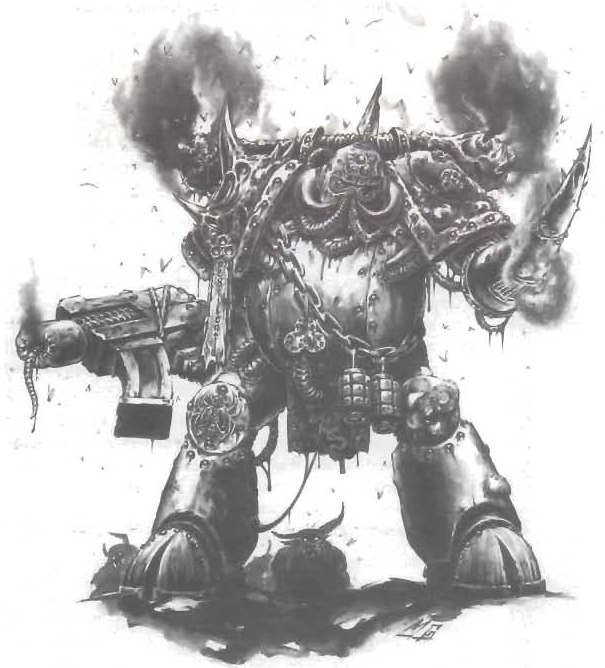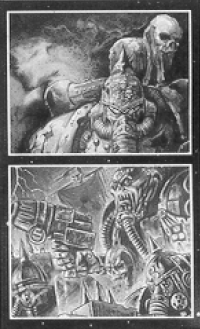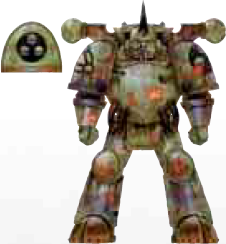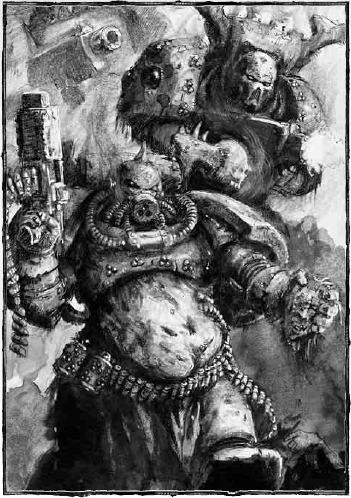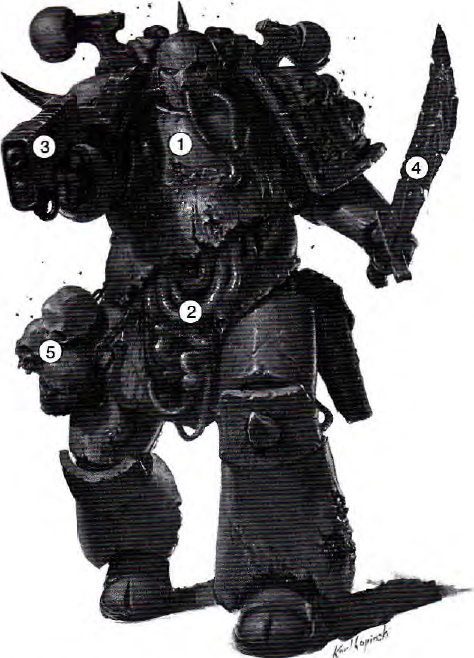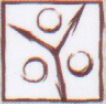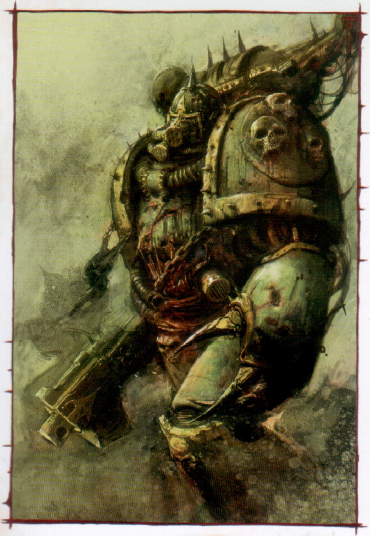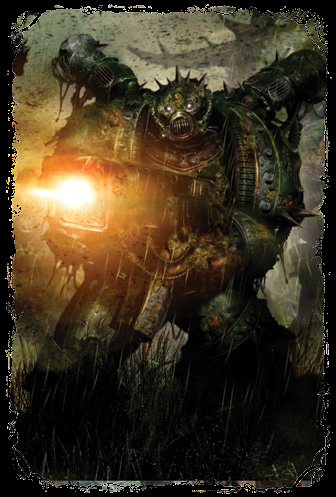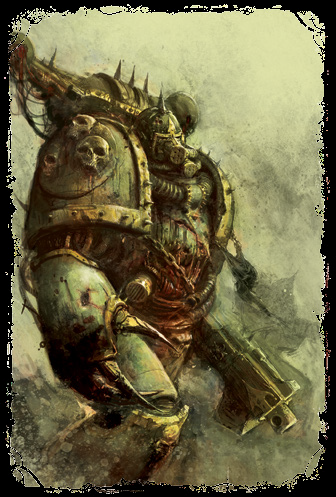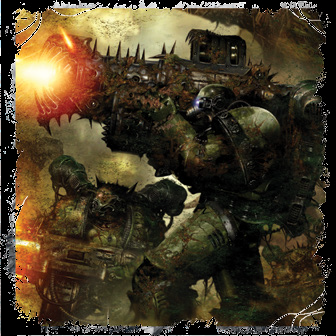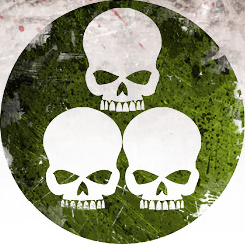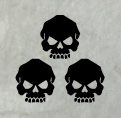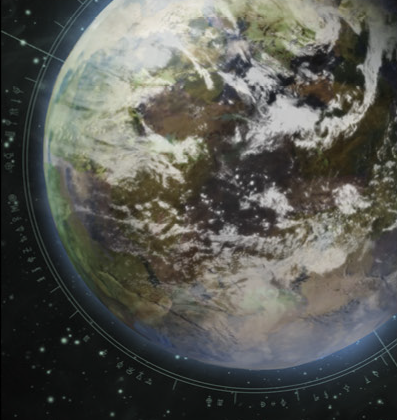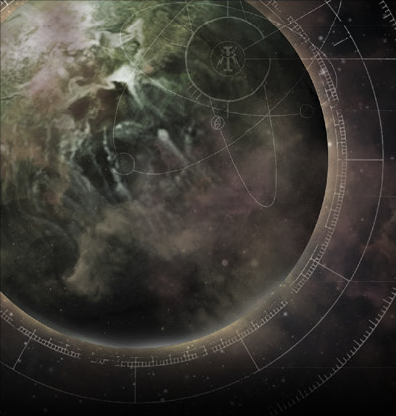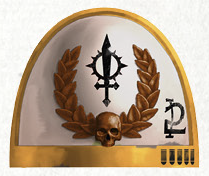[ Models | Lore | Sources | Inspiration ]
Death Guard
In the Warhammer 40,000 setting, the Death Guard are one of the original twenty Space Marine legions from the First Founding. The Primarch of the Death Guard, who provided their genetic template, is Mortarion. During the Horus Heresy, Mortarion (and by extension the Death Guard) supported Warmaster Horus in his bid to overthrow the Emperor. On their way to Terra, the legion's fleet was waylaid in the Warp and exposed to the Destroyer Plague. The legion ended up pledging themselves to Nurgle in order to overcome this disease, and they continue to fight in the Plague God's name.
Specific positions within the Death Guard include: Lords of Contagion, Noxious Blightbringers, and Malignant Plaguecasters.
Notable members of the Death Guard are: Nathaniel Garro, Gulgoth, Mortarion, Necrosius, Pestilaan, Typhus, and Ussax. Other members include the Blight Stalker, Corpulux, Dipteron, Festasmus the Putrid, Kulvain Hestarius, and Urgloth Rotheart.
Following the end of the Horus Heresy and the Death Guard's retreat to the Eye of Terror, various warbands split from the main legion. These include: Apostles of Contagion, Lords of Decay, the Purge, the Tainted, the Tainted Sons, and others.
Space Marine (1st ed, 1989)
General Horus was the finest military commander of his age. The Emperor granted him the title of Imperial Warmaster - a high honour, even in an age when brave deeds were commonplace. But the Imperium's hero was to become its deadliest enemy.
On the feral world of Davin, the Warmaster arranged to be inducted into a mystical warrior-lodge. This was not uncommon; Imperial policy approved of such links between feral-world natives and 'the Warriors from the Sky'. However, the warrior-lodge on Davin was not what it seemed. During the initiation, Horus became possessed by a Daemon from the warp. Those who had known Horus well began to speak of changes: lapses in memory, minor changes in habits, small things. Not until the Scouring of Isstvan did the truth become clear.
The Imperial Commander of Isstvan III had declared the system independent. Horus took five Space Marine Chapters to crush the rebellion: the World Eaters, Emperor's Children, Death Guards, Thousand Sons and his own Chapter, the Sons of Horus. He introduced the warrior-lodges to the Chapters, and the rot spread throughout his command. The Daemon-Horus planned to strike at the Imperium itself, and establish his rule throughout the galaxy. But first, Isstvan had to be dealt with.
The Scouring of Isstvan was a brutal affair. Isstvan III was destroyed by a virus bomb; twelve billion died instantly. It is said that the psychic death-scream of the doomed world drowned out the signal of the Astronomican.
During the bombardment, the frigate Eisenstein was seized by a small group of loyal Space Marine officers. They fought clear of the war-fleet and carried the news of Horus' corruption to Terra. Thus began the Horus Heresy wars.
The Imperium split almost evenly. The corruption of Horus' warrior-cult had spread from his command into several other units. Many more were attracted by his military reputation. Seven Space Marine Chapters - fully one-third of the Legiones Astartes - were sent against Horus. Four of these - the Word Bearers, Night Lords, Iron Warriors and Alpha Legion - joined the Rebels; the others have been purged from Imperial records.
While civil wars raged on a million worlds, Horus struck at Terra. The Adeptus Mechanicus workshops on Mars were quickly overrun, and as quickly besieged by the Loyalists. Of all the Titan Legions of the Divisio Militaris, only those on Terra remained loyal. Horus landed on Terra, and immediately lay siege to the Emperor's palace. On the 55th day of the battle, as the Inner Palace fell, the Emperor himself teleported into the Rebel command chamber with an elite force of Adeptus Custodes and Imperial Fist Marines. Horus was killed - although his body was never found - and the Emperor was so grievously wounded that he has been confined ever since to the biomechanical life-support unit known as the Golden Throne.
With Horus dead, the Rebels were thrown back from Terra. Soon the whole Sol system was recovered. But across the galaxy, the battles continue - the Rebels have been denied a swift victory, and the fate of Humanity still hangs in the balance. Throughout the Imperium there is war, the most dreadful war that Mankind has ever known. For the first time, Space Marines fight their fellow Marines - continents burn and planets are laid bare as the ultimate warriors meet in battle to decide the fate of all Mankind.
"You realise that you are preaching mutiny?" Brother-Captain Tarvitz nodded gravely. "Betray Horus or betray the Emperor. What choice is there?" The Space Marine officers looked at each other in silence for a few seconds. Tarvitz leaned forward across the table, resting on his fists.
"Fact: in the five Chapters under his command, Horus has installed this system of feral-world warrior lodges that he picked up on Davin. The standard Imperial organisations and command structures laid down in the Codex have been completely disregarded.
"Fact: the bulk of the Marines in our five Chapters have repudiated their Marine's oath and sworn loyalty to the feral world deities. Further, they have sworn loyalty to Horus personally. Heresy and blasphemy.
"Fact: the Isstvan campaign has been conducted without even the pretence of orders from Terra. While I do not presume to speak for the Emperor, I cannot believe that the use of a virus bomb on Isstvan III was justifiable. A single Company from a single Chapter dropped on the rebel headquarters would have answered the case.
"I say the Emperor must know what is happening here. Who is with me? Varren? What say the World Eaters?" A red-uniformed officer stood.
"There are fifteen men I can trust. They are yours."
"Garro?" A Captain of the Death Guards looked up.
"A dozen. I wish it were more."
"Ten from the Luna Wolves."
"Twenty from the Thousand Sons."
"Be sure they are all trustworthy. If you have the slightest doubt, do not commit them. Of my own Emperor's Children, there are ten I am sure of, including myself" There was a pause as the paucity of their force sunk in.
"Seventy Marines," said Brother-Captain Varren of the World Eaters, "The sum of our five Chapter numbers - a good omen, perhaps?" A couple of the others smiled, and the tension of the moment was broken. "Seventy Marines," repeated Tarvitz, "Enough for any task, I think. So, to work. Varren, your men will seize control of the frigate Eisenstein in three hours from now. It is on the edge of the fleet, and should be clear for the jump to Warp Space." Varren nodded.
"The Eisenstein has been having manoeuvre-drive trouble," he said, with exaggerated innocence. "She's been falling behind the fleet all day." Tarvitz grinned.
"Good. The rest of us will arrange for our ships to lag behind with her in case of... further trouble with the drives. Three hours from now, we will all assemble full crew for an emergency briefing. Meanwhile, our trusted men take control of the systems on all five ships. Clear all remaining ships from around the Eisenstein and keep her covered until she makes the jump to warp space. Then, cause as much damage as you can to the rest of the fleet. History will vindicate us."
He turned to Varren. "Your World Eaters are our only hope," he said, "Do not fail." Varren's eyes became serious. "We cannot fail," he said, "There is too much at stake. Your deaths will be avenged."
Brother-Captain Fenlan opened the Rhino's hatch and poked his head out. He caught the faint stench of sulphur in the air before his respirator rattled into life and filtered it out. Checking the seals of his suit, he cast a glance towards the enemy.
The Traitors were just visible on the horizon, the pure white of their uniforms a stark contrast to the featureless red sand that stretched as far as the eye could see. He tried to make an estimate of their numbers, but the heat haze distorted his vision; he guessed there were about five thousand, but it could well have been twice that number. As for his own side, they had just under seven thousand.
The two sides charged. Fenlan's Salamanders drove into the center of the Death Guards, a column of dark green cutting through the Traitor's white. Along the edges of the column there were bright veins of flashing light as the Marines exchanged shots. With painful slowness the green mass began to spread sideways, clearing itself a path with heavy bolter fire, pushing forward over the bodies of the fallen.
The rest of the Salamanders' swung around the Death Guards' flanks, trying to surround them and box them in, but the Traitors refused to yield. They fought for every inch of ground, simultaneously pushing back the flanking force and squeezing the line of troops that bisected them, isolating it within a circle of their own men. Suddenly caught with nowhere to run, the Salamanders' main force was slaughtered; within a matter of minutes every last Marine was blown apart, his broken body trampled underfoot.
Fenlan watched as his troops began to lose the advantage, his despair becoming stronger as each explosion smashed their ranks. His hand shaking, he picked up the commlink.
"Brother-Captain Fenlan. Treab's World, Northern Sulphur Desert. Request immediate reinforcements. We are engaged in combat with a large Traitor force, and are sustaining heavy losses."
White Dwarf 122 (1990-02)
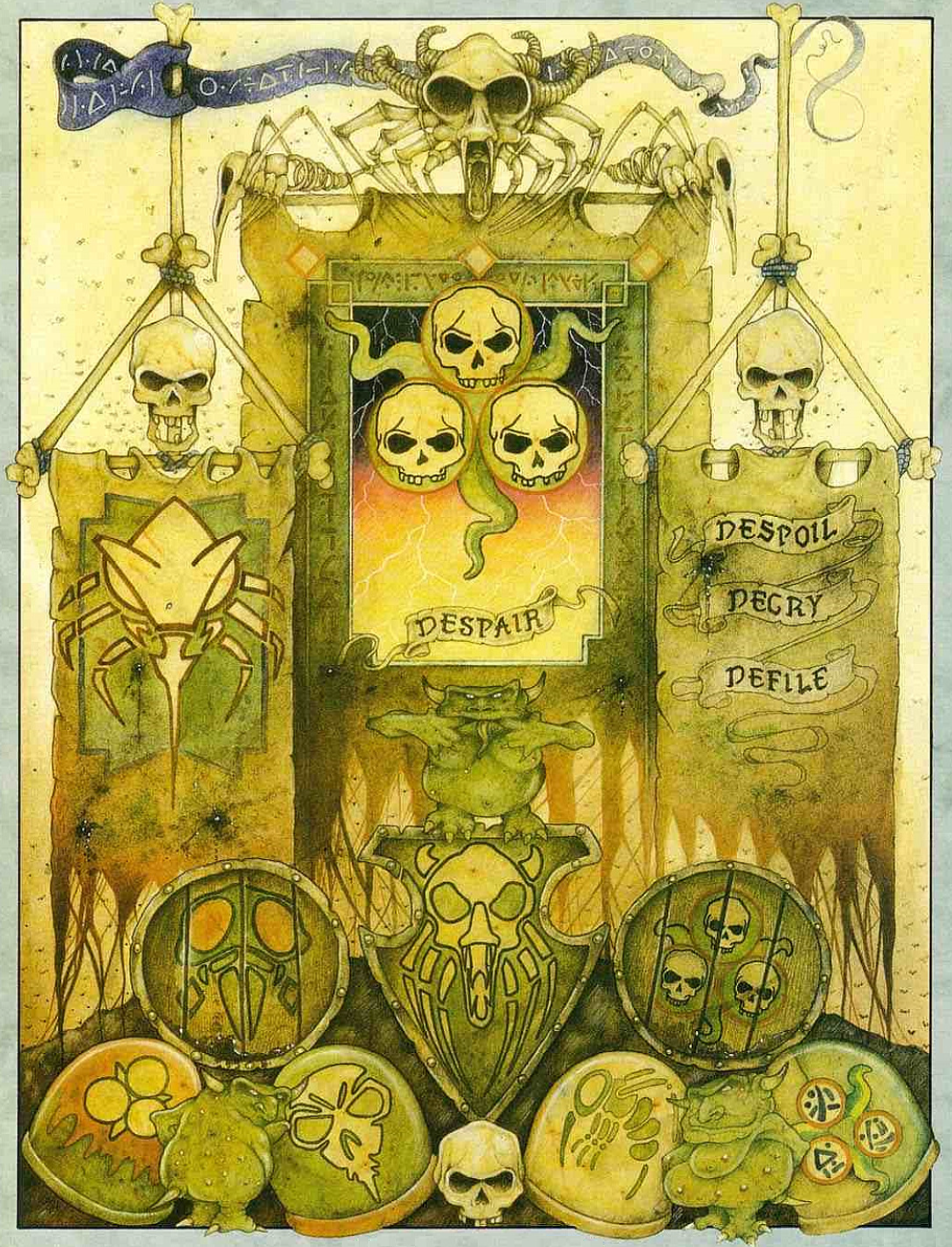
Followers of Nurgle, be they Champions of the Warhammer World or spacefaring Champions who lead the Chaos Renegades throughout the galaxy, favour certain materials with which to decorate their banners. Thus many of these banners, and for that matter the shoulder badges and icons of the Chaos Renegades, gleam with yellow pus, bile green, and several rich brown colours of doubtful origin.
- Centre: battle Banner of Mortarion, Primarch of the Death Guard Space Marines. The Banner is kept enshrined on the world of Mortarius in the Eye of Terror, and is removed and carried into battle when the Death Guard go to war.
- Left: the Banner of Chaos Champion Pestulus depicting the blood sucking flea which characterises his own mutation - the head of a fearsome blood-devouring insect.
- Right: typical of the declaiming banners carried by the Champions of Nurgle is this, listing in no uncertain terms the avowed aims of its bearer.
- Below: three shields depicting variations of Nurgle's own symbol, the tripartite fly.
- Bottom: shoulder pads of the Death Guard with more variations of the tripartite fly.
Realm of Chaos: The Lost and the Damned (1990)
The Emperor never made the mistake of underestimating the threat of Chaos, and in order to meet that threat he put the best scientific brains on Earth to work. Weapons and spacecraft poured out of the Martian factories to bolster beleaguered forces throughout the galaxy.
The Emperor's most long-sighted plan to counter the insidious influences of the Chaos Powers was the creation of the Primarchs: genetically engineered super-humans with god-like powers. The Emperor's intention was to create a whole race of super-humans from the genetic blueprint of the Primarchs. By making them loyal and strong he hoped that they would prove immune to the malign psychic influences of Chaos.
The Primarchs were to be shining examples of humans free from the taint of corruption. The energy of the uncorrupted warp would flow through them as it flowed through the Emperor himself, invigorating them and conferring special powers such as were possessed by the shamans of old.
Unfortunately, things did not go quite according to plan. Despite the Emperor's best attempts to shield the project from the penetrating eyes of the Chaos Powers they still managed to learn of it. The Primarchs were still in their foetal stage, growing in special amniotic tanks, when the Chaos Powers combined their energies to spirit them away in an unexpectedly bold move.
Even for the Chaos Powers this kidnapping represented a colossal expenditure of energy. The Primarchs were sucked through the warp and scattered on separate human worlds in distant parts of the galaxy. The Chaos Powers did not have the resources to destroy the Primarchs, but they did the next best thing which was to hide them from the Emperor. They were to remain hidden until after the waking of Slaanesh.
The Space Marines
The Emperor had lost the Primarchs and the first action of his renewed war against the Chaos Powers. The Primarchs could not be recreated and even if this were possible there was not time to do it. The birth pangs of Slaanesh grew louder and louder as the time of his waking grew near. The Emperor evolved another plan. Using genetic material which had been imprinted from the Primarchs into laboratory gholems, some of their qualities could be reproduced as discrete biological organs. By implanting these organs into a young growing body a person with some of the qualities of the Primarchs could be created. In this way the first Space Marines Chapters were founded. Each Chapter utilised genetic material derived from one of the Primarchs.
The Great Crusade
By the time that the warp storms were ended, the Space Marines and other Imperial forces were ready to begin their reconquest of the galaxy. The forces of Chaos were already strong, and many human worlds had been taken over by Chaos Cultists or other aliens. It was a long hard struggle, but with every victory the Imperium grew stronger as new warriors joined the Great Crusade.
The initial conquests concentrated in areas where the Primarchs had been hidden. Using his psychic powers the Emperor gradually located and found each of his original creations and united them with the Space Marine Chapters created from their genetic imprints. They seemed none the worse for their brush with Chaos, having grown up to be great leaders and warriors among the local human populations. In fact this appearance of normality was to prove deceptive, for some of the Primarchs had become tainted by their early contact with Chaos. With the help of the Primarchs the Great Crusade swept across the galaxy. Humanity rose to the task of rebuilding its ancient heritage, and everywhere the alien oppressor was defeated and driven out. Chaos retreated to its own realms, to the zones of warp-real space overlap such as the Eye of Terror.
In the third year of the Horus Heresy the rebel Death Guard Chapter was marooned in the warp while attempting a long-range jump to Earth. Months passed while the fleet's Navigators searched for a warp-tide that would bring them back to the material universe. Meanwhile a mysterious contagion began to spread from ship to ship. The stinking pestilence bloated the gut, distended the flesh, and turned its victims rotten from the inside. Eventually the Chapter's Primarch Mortarion became infected and in his delirium he called upon the Powers of Chaos to aid the Space Marines. Mortarion's fevered ravings were answered by Nurgle, and Mortarion became Nurgle's Champion and eventually the Daemon Prince Mortarion, Lord of the Plague Planet. The Plague Planet he rules over lies deep inside the Eye of Terror. From this dark and slimy orb Mortarion launches fleets of Plague Ships into the warp to carry their contagions through the galaxy. On board are Champions of Chaos and their followers from the Plague Planet accompanied by warriors of the ancient Death Guard - the heinous Plague Marines of Nurgle.
The Death Guard
The Death Guard Chapter was one of the original twenty Space Marine Chapters founded by the Emperor. During the Horus Heresy the Chapter joined the rebel Warmaster Horus and took part in many battles against the Emperor's forces. Their commander, Mortarion, became an open worshipper of Nurgle when the entire Chapter was trapped inside the warp and ravaged by plague. Subsequently he led his Space Marines in a merry dance of destruction over a score of planets. As disease began to disfigure the Marines, their appearance changed into the disgusting form they still bear today. Now te once tall and erect Space Marines of the Death Guard are the Plague Marines of Nurgle. Their flesh bubbles with corruption, their innards spill through lesions in their putrid skin, and their bodies ooze with sticky slime.
Following the death of Horus and the effective end of the Heresy, Mortarion fled with the remnants of his Chapter into the Eye of Terror where he received Nurgle's ultimate reward and became the Daemon Prince Mortarion. He rules over a Plague Planet where sickness and pestilence are the norm, where miasmic clouds being corruption and death and where the diseased pray to Nurgle for relief from their constant agony. Some of them are favoured and become Champions, and then fight among themselves for mastery and the chance to become Daemon Princes in their own right. The Plague Marines rarely interfere in battles between rising Champions. In fact they are not commonly seen by the world's inhabitants except during the time when new Champions are selected to fight with the Chaos Renegades. Most of their time is spent attending on Mortarion or carrying out his wishes, spreading new diseases and travelling to other worlds to carry Nurgle's plagues to new victims.
The Plague Fleets
Not even the ministrations of advanced technology can entirely eradicate the dangers of disease on long space voyages. A ship travelling between far flung planets always risks contamination by alien viruses or mutated bacteria. Such perils can quickly infect and slay the crew, or incapacitate the ship's Navigator stranding the ship in the warp. The empty husks of Plague Ships drift through the warp, sometimes for thousands of years, until they are drawn to that bosom of pestilence which is the Plague Planet of Mortarion. Here they are gathered into Plague Fleets and filled with the diseased followers of Mortarion before being cast back into the warp to spread their pestilence throughout the galaxy.
The Plague Fleets carry followers of Nurgle to inhabited planets where their destructive raids are inevitably followed by an outbreak of a no less destructive contagion. Once the Plague Ships are abandoned or their crews finally destroyed, the hulks float back into the warp where the currents carry them back to the Plague Planet.
The Cloud of Flies
During the Plague Ships' journey through the warp the insides of the craft erupt with large furry black flies. They burst from every surface, covering the interior of the ship, filling whole rooms with their decaying carcasses. When the ship reaches a new world the Champions and their followers prepare to disembark by landing craft, teleport, or by landing the ship itself. As soon as the ship's hatches are opened a thick black cloud of insects is released, each a tiny bearer of disease ready to spread the foulness of Nurgle over a virgin planet. Even when the Marines disembark by teleporter enough flies are transported to form a dense cloud of choking blackness.
Codex: Chaos (1996)
The Death Guard Legion was one of the original twenty Space Marine Legions founded by the Emperor. During the Horus Heresy the Legion joined the rebel Warmaster Horus and took part in many battles against the Emperor's forces. When Horus led his attack on the Emperor, the rebel Death Guard Legion was marooned in the warp while attempting the long journey to Earth. Days passed while the fleet's Navigators searched for a warp-tide that would bring them bak to the material universe. Meanwhile a mysterious contagion began to spread from ship to ship. The stinking pestilence bloated the gut, distended the flesh, and turned its victim rotten from the inside. Eventually even the Legion's primarch, Mortarion, became infected and in his delirium he called upon the Powers of Chaos to aid the Space Marines. Mortarion's fevered ravings were answered by Nurgle, and Mortarion became Nurgle's Champion.
The Death Guard, newly dedicated to Nurgle, arrived in time to take part in Horus's attack on Earth and took part in all of the major battles of the campaign. As disease began to disfigure the Death Guard, their appearance changed into the disgusting form they still bear today, and the once tall and noble Space Marines of the Death Guard became Plague Marines of Nurgle.
Of all the Chaos Space Marines, Plague Marines are the most physically horrible to look upon. Their flesh pulses with corruption, their innards spill through lesions in their putrid skin, and their bodies ooze with sticky slime. The sheer stench their rotting bodies exude fills the air around them with the sickly sweet scent of death for hundreds of yards in every direction. The sight of living creatures so foul is an abomination to nature, and of all the Plague Marines, those of the Death Guard are the most foul and disgusting, the most corpulent and corrupt.
Following Horus's defeat, Mortarion led his Death Guard in a merry dance of destruction over a score of planets until finally retreating with the remnants of the Legion into the Eye of Terror. Here he received Nurgle's ultimate reward and became a fully-fledged Daemon Prince ruling over one of Nurgle's greatest Plague Worlds in the Eye of Terror.
The Plague Planet Mortarion rules over lies deep inside the Eye of Terror. From this dark and slimy orb Mortarion launches fleets of plague ships into the warp to carry their contagions through the galaxy. On board are Champions of Chaos and their followers from the Plague Planet accompanied by warriors of the ancient Death Guard, the heinous Plague Marines of Nurgle.
The Plague Planet itself is a place where sickness and pestilence are the norm, where miasma clouds bring contagion and death and where the diseased pray to Nurgle for relief from their constant agony. Some of them are favoured and become Champions, and then fight among themselves for mastery and the chance to become daemon princes in their own right. The Plague Marines rarely interfere in battles between rising Champions. In fact they are not commonly seen by the world's inhabitants except during the time when new Champions are selected and enter the ranks of the Plague Marines. Most of their time is spent attending on Mortarion or carrying out his wishes, spreading new diseases and travelling to other worlds to carry Nurgle's plagues to new victims.
Plague Marines are Chaos Space Marines who have dedicated themselves to the Chaos God Nurgle. Amongst the most dedicated followers of this cult are the Chaos Space Marines of the Death Guard, but many other Chaos Space Marines also dedicate themselves to the Lord of Decay.
Plague Marines have disgusting rotted bodies that stink of decay. Their armour and weapons are pitted and corroded by the putrescent slime that oozes from their many sores, but they are still fearsome opponents. Their decaying brains are innured to the agony of their bodily corruption, making them all but immune to any pain or discomfort caused by battle wounds.
| Troop Type | M | WS | BS | S | T | W | I | A | Ld |
|---|
| Plague Marines | 4 | 4 | 4 | 4 | 4(5) | 1 | 4 | 1 | 8 |
| Plague Marine Terminators | 4 | 5 | 5 | 4 | 4(5) | 1 | 5 | 1 | 9 |
Special Rules
Chaos Space Marines
The usual Rapid Fire special rules apply.
Mark of Nurgle
All Plague Marines are blessed with the Mark of Nurgle (see above). This means that their Toughness is increased by +1 point, as shown on their profile above. Note that Plague Marines receive the Mark of Nurgle for free and do not have to pay any points for it.
Twisted and corrupt, the Death Guard are disease-ridden mockeries of their former selves. Guided by their Daemon-Primarch Mortarion, they revel in the contamination of Imperial worlds, sowing plague and contagion wherever they go, inflicting cruel and agonising deaths on a planetary scale.
Plague Marines are hideous and nauseating to behold. Their swollen, decaying flesh is barely contained by their corroded, slime-encrusted armour. Such human carrion barely feels pain any longer, as their nerve endings and pain receptors have atrophied over the long years of degeneration.
Codex: Chaos Space Marines (1999)
Plague Marines are Space Marines who are sworn to the Chaos god of decay and pestilence - Nurgle. They have disgusting rotted bodies that stink of decay and their armour and weapons are pitted and corroded by putrid slime that oozes from their many sores, but they are still fearsome opponents. Their decaying brains are inured to the agony of their bodily corruption, making them all but immmune to any pain caused by battle wounds.
Plague Marines
| | Pts/model | WS | BS | S | T | W | I | A | Ld | Sv |
|---|
| Plague Marine | 20 | 4 | 4 | 4 | 5 | 1 | 4 | 1 | 9 | 3+ |
| Aspiring Champion | +20 | 4 | 4 | 4 | 5 | 1 | 4 | 2 | 10 | 3+ |
Squad: The squad consists of between five and ten Nurgle Plague Marines.
Weapons: Bolter or bolt pistol. All models have a Plague knife.
Options: Up to one Plague Marine may be armed with one of the following: meltagun at +10 pts, flamer at +3 pts, plasma pistol at +5 pts or plasma gun at +6 pts.
The entire squad may be equipped with blight grenades at +3 pts per model.
One of the Chaos Space Marines may be upgraded to an Aspiring Champion at an additional cost of +20 pts. The Aspiring Champion may be given any equipment allowed from the Chaos Armoury.
Rhino: The entire squad may be mounted in a Rhino armoured carrier at an additional cost of +50 pts.
Special Rules
Troop Choice: If the army is led by a Chaos Lord bearing the Mark of Nurgle then Plague Marines may be taken as Elites or Troop choices. In any other circumstances they may only be taken as an Elites choice.
Fearless: Plague Marines never fall back and cannot be pinned. They are assumed to automatically pass any Morale check.
Plague Knife & Blight Grenades: These items are described in the Chaos Wargear section of this Codex.
When Horus led his attack on the Emperor, the rebel Death Guard Legion was marooned in the warp where a mysterious contagion began to spread from ship to ship. The stinking pestilence bloated the gut, distended the flesh and turned its victims rotten from the inside. Eventually Mortarion became infected and in his delirium he called upon the powers of Chaos to aid the Space Marines. Mortarion's fevered ravings were answered by Nurgle and Mortarion became Nurgle's Champion.
The Death Guard, newly dedicated to Nurgle, arrived in time to take part in Horus' attack on earth and fought in all of the major battles of the campaign. As disease began to disfigure the Death Guard, their appearance changed into the disgusting form they still bear today and the once tall and noble Space Marines of the Death Guard became Plague Marines of Nurgle. Following Horus' defeat, Mortarion led his Death Guard in a merry dance of destruction over a score of planets until finally retreating with the remnants of the legion into the Eye of Terror.
Following their retreat from the material universe, it becomes difficult to say with certainty what happened to the Death Guard. However, it seems likely that Mortarion received Nurgle's ultimate reward and became a fully-fledged Daemon Prince, ruling over a Plague world in the Eye of Terror. From this dark and slimy world Mortarion launches fleets of Plague ships into the warp to carry their contagion through the galaxy.
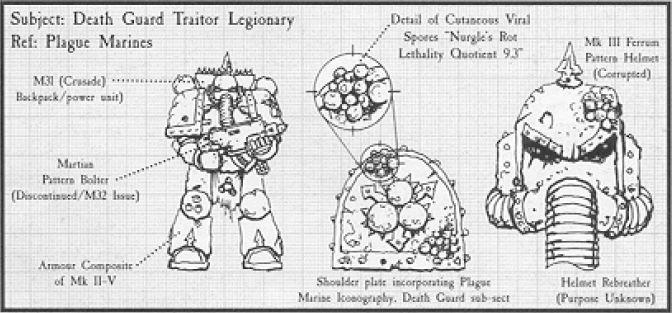
White Dwarf 265 (2002-01)
The Death Guard Legion, the dread Plague Marines of Nurgle, has become a relentless and terrifying scourge upon the Imperium of Man. But it was not always so. Ten millennia ago, the Death Guard was one of the original twenty Space Marine Legions, united in the defense of Mankind under the command of the Emperor and their fearsome Primarch, Mortarion.
Origins
When the Emperor's twenty nascent Primarchs were scattered across the galaxy, the Stygian Scrolls tell of one who came to rest on a bleak moor, strewn with dead and scattered with the carnage of battle for leagues in every direction. The planet was Barbarus, perpetually shrouded in poisonous fog, whose mountainous crags were ruled by warlords with fantastic powers and horrific appetite, and whose human settlers, stranded there millennia before, were crowded into the lowest valleys, beneath the choking mists. They lives lives of unrelenting terror, eking out a peasant's existence by day beneath a dim sun which never burned completely through the fog, and cowering by firelight after dark from the terrible beings which moved unseen above.
The greatest of these overlords stood in triumph on the battlefield, revelling in his massacre until the silence was shattered by a child's cry. Legend tells that the warlord walked the sea of corpses for a day and a night in his creaking battle armor, drawn by the wail of the infant. For an instant, he considered ending its young life; but no mere human ought to be able to breathe the poisonous miasma of the heights of Barbarus, much less cry out as this child did. For long moments he contemplated the thing which appeared human but was clearly more; then he gathered up the infant and carried it from the carnage. For all his dark power, until that moment he had not had what this child now promised: a son and heir. Born of death, upon a field of death, the warlord christened the infant Mortarion: child of death.
His master tested the infant's limits. When he had determined precisely how high into the toxic clouds of Barbarus's peaks the child could survive, he erected a stony keep and fenced it behind back iron. Then he moved his own manse beyond, to the highest crag, where the atmosphere was deadly even to the nascent Primarch. Mortarion grew to adolescence in such a world, of citadels of weeping grey stone and cast-iron fences, where the very air was death, and the sun never more than a distant smudge. It was a world of constant war, against opposing lords who came with golem armies of stitched-together dead one day, then tormented shapeshifters, more monsters than men, the next. To survive, Mortarion learned at the foot of his overmaster, and learned voraciously everything his master would teach him. Mortarion devoured it all: from battle doctrine to arcane secrets, from artifice to stratagem. He learned and he grew, shaped by his grim environs, but a child of the Emperor for all that - superhumanly resilient to the poisonous air around him and superhumanly strong even in the absence of sufficient sunlight or nourishment. Mortarion possessed an intellect which was highly keen and which asked questions his lord was not wont to answer.
Increasingly, the questions centered around the fragile things in the valleys below, which the warlords preyed upon for their corpses to reanimate, or victims to accurse. His master kept Mortarion as distant from the human settlements as he could, but his very act of denial fed the maturing Primarch's obsession. The day finally came when Mortarion would be denied no longer. Mortarion slipped through the dungeons from his keep. The last thing he heard was the voice of the overlord, the only father he had known, roaring in the miasmic darkness from the high battlements as Mortarion descended from the mountain, renouncing the Primarch for his betrayal, warning Mortarion that to return would mean death.
Descending beneath the mists was a revelation to Mortarion; his lungs were filled with air free of poisons for the first time. He smelled aromas of food being prepared, of crops freshly harvested, heard voices unmuffle by fog and, for the first time, heard laughter. The young Primarch realised that he was among his own kind, that the 'fragile prey' of the warlords were his own people. And with the realisation came rage. He determined to bring them the justice denied them by the dark powers which moved above.
Mortarion's acceptance amongst the human settlers of Barbarus was no simple thing. However like them he felt himself to be, to them he was little different from the monsters above. Towering over even the tallest of them, gaunt and pallid, with hollow, haunted eyes which betrayed the horrors he had seen, Mortarion terrified most of the settlers. They looked upon him with suspicion and fear. It stung the young Primarch, but he bided his time, using his great strength to work the fields for their meager harvest, knowing that his opportunity to prove himself would come. When it did in the twilight hours, he was ready.
From the darkness came shambling dark things. A lesser lord led his corpse-like thralls into the settlement, taking with silent, remorseless strength those they could carry off for their master's dark purpose. The peasants fought back as best they could, with torches and farmer's tools rendered into makeshift weapons. It was all they could do not to run, much less offer a meaningful fight. They had played out the futility of this scene their whole lives, and they knew how it would end. Until, that is, Mortarion strode into their midst. Towering over them with an enormous two-handed harvesting scythe, he charged into the ranks of the enemy with all his rage-born might, and drove them from the village. Their dark lord smiled at him as he neared and withdrew into the poisonous heights where this rebellious human could never reach him. He was still wearing his contemptuous smile when Mortarion caught up with him on the mountainside and exacted his vengeance for the 'fragile prey' below. After that night, Mortarion's place among the settlers was never in doubt.
As he matured, Mortarion taught the settlers of Barbarus what he knew of warfare. Word of his exploits spread, and many oters made the perilous journey to learn. Slowly, villages became strongpoints, and the villagers were more effective defenders. Eventually, Motrarion went amongst the people, travelling from settlement to settlement, teaching, building and, when occasion demanded, defending them. Always, however, his ultimate justice was denied; the dark powers could always retreat into the impregnable bulwrk of their poisonous mists. His people could only fight in defense. That had to change.
Mortarion recruited the toughest, most resilient of Barbarus' population, forming them into small units which he drilled himself, teaching them not only defense but also attack. He turned blacksmiths from toolworking to weaponsmaking when time allowed, and crafters to the shaping of armor. And, with the best artificers he could find, he bent his formidable intellect to the problem of the poisonous air.
Inquisitor Mendikoff's monograph, Cataphract of Death, relates the now-famous result. When next a warlord descended from above, and the villagers mounted a defense successful enough to drivehis unholy army back, Mortarion and his retinue of warriors, masked with crude filtering hoses and breathing gear, advanced into the fog after them. For the first time in living memory the prey brought death into the realm of death, killing the warlord and massacring his army. Mortarion continually improved his warrior's breathing apparatus, and he and his Death Guard, as his retinue came to be know, campaigned ever higher into the dark powers' domain, encountering ever more virulent pestilence. The constant exposure to ever higher doses of toxins toughened his Death Guard, traits which proved transferable to each new iteration of the Death Guard, growing tougher as though emulating their champion himself.
Only the most toxic peaks were denied Mortarion and the Death Guard and they warred for months across the poisonous spine of Barbarus, until only one grim manse stood against them, one which Mortarion knew well. The concentration of death about it overcame his force, threatening even Mortarion himself, and so he withdrew. Upon his return, however, his world was destined to once again spin out of his control.
Mortarion and his brethren arrived to find the village alive unlike he had ever known it. On everyone's lips was word of the arrival of a stranger, a great benefactor who brought promise of salvation. The Primarch's mood darkened; this day of deliverance was one he had worked for all his life, and he found himself altogether unhappy to see it co-opted by the arrival of some newcomer of uncertain agenda.
Taletellers say Mortarion flattened the massive wooden door of the hall upon his entrance. Seated at banquet, he found the elders and a stranger who was their opposite in every imaginable way. Where they were gaunt and pale, he was robust, his flesh bronzed, his physique utterly perfect. The people greeted Mortarion's arrival expectantly. Despite the effect wrought upon him by Barbarus's poisons, the connection between the new benefactor and their defender was nevertheless plain to them all. As plain as father and son. However, Mortarion was oblivious to any connection. He greeted the stranger with barely masked hostility, which quickly turned to outright anger at the stranger's utter unflappability. The elders spoke of the new arrival's promise to unite the people of Barbarus within a great expandign brotherhood of humanity which could help them be rid of their persecution from above. Mortarion felt his moment of triumph slipping from him. Twisting the haft of his ever-present scythe until this knuckles whitened, he declared that he and his Death Guard needed no help to finish their quest for justice.
It is said that the benefactor quietly challenged the stormy young Primarch's assertion, pointing out the Death Guard's failure to reach the last high citadel, and then threw down a gauntlet. If Mortarion could defeat the high overlord alone, he would withdraw and leave Barbarus to its own means. But if he failed, they would join his Imperium of Man and Mortarion would swear total fealty and allegiance to him.
Over the protests of his Death Guard, he spun on his heel and struck out alone for the last manse standing against him, the keep of the overlord he had called father. If some part of him knew that even he could not survive the highest reaches of Barbarus, he did not acknowledge it. Mortarion climbed ever higher, driven by the inevitability of the imminent conflict with his once master, driven by his desire to bring final justice for the people of his world. However he was mostly motivated by a compulsion to prove himself to the stranger below.
The confrontation, when it finnaly came, was mercilessly brief. Mortarion, choking in air so toxic that the hoses of his protective breathing gear began to rot away, struggled to the very gates of the overlord's citadel, calling out his defiance. The last thing he saw as he fell to his knees, the world turning grey as he was overcome, was the Overlord of Barbarus coming for him, to fulfill the promise he had made generations before. Then the might stranger stepped between them, defying the death-fog, and felling the overlord with a single blow of his gleaming sword.
Mortarion was true to his oath. When he recovered, he bent his knee to the stranger and swore himself and the Death Guard to his service. Only then did the Emperor of Man reveal himself as the young Primarch's true father, and the destiny such service would bring: command of the fourteenth Legion of the Adeptus Astartes, the Space Marines.
The Libram Primaris, or Book of Primarchs, tells how Mortarion brought the relentlessness, remorselessness and resilience of his personal Death Guard to the Legion built of his own genetic material, and how in turn they adopted his retinue's title as their own. The resulting prowess of the Death Guard was recognised from the moment Mortarion took command, but the young Primarch never settled in Imperial society outside of battle. Mortarion was a grim, driven Primarch, fixated on reckoning with the oppressors of the galaxy. The easy camaraderie of the other Primarchs was alien to him. The Shadow Journal of Bellerophan, Dark Angels Librarian, confides that, of them all, he found kindred spirits in only two: Night Haunter, the dread master of the Night Lords, and Horus, the Warmaster of the Imperium, and the right hand of the Emperor. Horus above all others recognised the value of the Death Guard. He would often place Mortarion and his Legion in the center of his battleline, counting on the enemy's inability to oust them so that he could either lever his advance from the rock of Mortarion's immovable position, or use it as the anvil upon which the Imperial hammer, in the form of his Luna Wolves, or the Haunter's Night Lords, would break the foe. It was a mercilessly effective combination.
In the charismatic Warmaster, Mortarion found a mentor who seemed to understand his goals and appreciate his methods. So close did Mortarion appear to be to Horus, in fact, it is believed that at least two of the other Primarchs, Roboute Guilliman of the Ultramarines and the ever watchful, ever taciturn Corax of the Raven Guard, approached the Emperor with concerns about where the master of the Death Guard's loyalties lay. The story of his allegiance to the Emperor won through his own failure was by then well-known, and anyone with even a passing familiarity with Mortarion knew that the pallid Primarch chafed at it. The Emperor is said to have dismissed their concerns with a wave; loyalty to Horus was de facto loyalty to the Emperor.
On that matter, the Emperor could not have been more wrong...
The Betrayal
On the feral planet Davin, the Warmaster and his Legion, now named the Sons of Horus in his honor, had fallen to Chaos. Before they would leave, Horus would be utterly possessed, foreswearing allegiance to the Emperor for the cause of Chaos and his own advancement, and would draw the Primarchs and Battle Brothers of half the Imperium's Legions to his cause. Transcripts of the Council of Charon, convened after the Heresy to ascribe responsibility, suggest that, unlike some of the other Primarchs, Horus did not need to resort to ritual possession to win the Death Guard to his side. Horus promised that under his rule the old order woud fall, and a new age would dawn, a just age with right ensured by the mighty. Mortarion turned on the Imperium as he had turned on the overlords of Barbarus, and joined the rebellion which would forever sunder the Imperium - the Horus Heresy. What he did not know then was the price he would be called upon to pay.
Horus was a brilliant strategist; he knew that the heart of the Imperium was Terra, and from the very moment of his rebellion, Terra was his objective. In short order he had gathered sufficient strength to shatter the defenses of the Imperium and lay siege to the Imperial Palace itself. Mortarion was determined that the Death Guard would be there with him. With his entire fleet, he crossed into the Warp and straight into nightmare.
The Death Guard fleet was becalmed by an impenetrable warpstorm, its navigators neither able to guide them through it nor find safe passage into realspace. The fleet was reduced to drifting through the Immaterium, and while they were stilled the Destroyer came.
For Mortarion and the Space Marines of the Death Guard there was nothing so terrifying as the plague which made their legendary resilience meaningless. These were the warriors who the Imperium had sent to conquer worlds no other man could set foot upon, much less fight on and win. Pestilence, contagion, toxin and pollution; there was no environment so hostile which Mortarion and the Death Guard could not overcome, until the plague which raced through their fleet. It roiled in their guts, bloating and distending their once superhuman bodies, transforming them into horrible, pustulent grotesques. They were made corrupt within and sickening to behold without and they grew sicker and sicker, yet could not die, their own constitution becoming their worst enemy. What they endured was unimaginable yet none suffered more that Mortarion. For the Primarch, it was as though he were upon the mountaintop of Barbarus once more, surrendering to the poison, without the mercy of unconsciousness to claim him or the Emperor to come to his salvation.
Whether he perceived, in those terrible hours, the loss of what he had once stood for, and the damnation he had wrought upon himself and his Legion, only Mortarion will ever know. Unable to endure the suffering any longer, Mortarion offered into the Immaterium himself, his Legion and his very soul in exchange for deliverance. A presence in the Immaterium answered, as though it had been waiting all along. In the depths of the warp, the Great God Nurgle, Lord of Decay and Father of Disease, called that debt and accepted Mortarion and the Death Guard Legion as his own.
What emerged from the warp when the Death Guard fleet broke out bore little resemblance to what had entered. The gleaming white and grey armor of Imperial champions was no more, burst and shattered from the horrific bloating of infected bodies, scabbed with boils, putrescence and the filth of corruption. Their weapons and machinery of war were now powered by the sickly sorcery of Chaos, glowing with lambent green luminescence and oozing gangrenous pus. The name Death Guard itself would pass into secondary use, as the walking pestilence-carriers became a terrifying sight across the Imperium. To their victims, to their erstwhile allies, even to themselves, they had become the Plague Marines.
Horus was eventually defeated by the Emperor and Chaos was driven back across space, finding refuge in the weeping sore known as the Eye of Terror. Mortarion and his Death Guard retreated there as well, but not in disarray, as many of the other Legions did.
Even in damnation, the resilience of the Death Guard remained, and under the direction of their Master they withdrew into the Eye intact, Loyalist Space Marines and Imperial Guard regiments breaking upon them time and again.
Within, Mortarion claimed the world which would become known as the Plague Planet as his own; its location near the fabric of reality was ideal for launching new strikes into the Imperium and across the galaxy. He shaped it so satisfactorily and defended it with his Plague Marines so well that his patron, Nurgle the Unclean, elevated the Primarch to daemonhood and gave Mortarion what the Emperor had denied him, and what Horus had not been able to provide: a world of his own. Mortarion became the overlord of a world of poison, horror, and misery. He had come home.
Home World
Barbarus was a feral world which orbited near its dim yellow sun, creating a thick, miasmic atmosphere of toxic chemicals. The most virulent gases rose through Barbarus's perpetual cloud towards the heat of its star, making the world beneath a dismal place of night, unbroken by starlight and with short, shadowy days. An atmosphere breathable by humans existed only in the lowest elevations, on flat moors and in the valley basins of the jagged, stony mountains which spined the world. Beings immune to the toxic soup of the planet's higher atmospheres once existed on Barbarus, building great grey keeps in the mountain fastnesses. When humans came to Barbarus, the horrific conditions from which they had to eke out survival quickly reduced them to a pre-feudal state. The higher beings' incomprehensible powers, their ability to survive where men could not, and above all their hunger to prey upon, experiment with and accurse Humankind caused the settlers to ascribe to those beings a medieval supernaturalism. What manner of creatures these dark overlords were will never be known.
Since his elevation to daemonhood, Mortarion has, consciously or not, remade the Plague Planet very much in Barbarus's image. Its citizens cower in festering villages on the planet's surface, serving their supreme masters, Mortarion's champions and other daemonic chosen of Nurgle who reside in mighty fortress-citadels high above them. Diseased things which should be dead, yet are not, roam the landscape, and skeletal Mortarion rules over all, enthroned upon the highest peak of the world.
Combat Doctrine
Mortarion was well-educated, if narrowly. Matters of culture, history, philosophy were often alien to him, but on the subject of dealing death he was a prodigy. Mortarion believed that victory came through sheer relentlessness, and communicated that ethic throughout the Death Guard. Their weapons and armor were rarely the most expertly artificed, certainly not the most beautifully-ornamented, but functioned without flaw. The Death Guard did not manouevre fancifully, or confound their opponents; they picked the best ground upon which to fight, then smashed their foes after they had broken themselves against the Death Guard line. There was no environment which Mortarion and the Death Guard feared. What Mortarion and his adepts could not devide means to compensate for, the Death Guard overcame through sheer resilience.
Mortarion learned battle in a theatre of rocky mountainous terrain, without benefit of machinery. Though his considerable intellect allowed him to grasp the value of such support when his elevation to Primarch of a Space Marine Legion made such things as tanks and transport available, the primacy of the foot soldier remained ever the trademark of the Death Guard. Mortarion preferred to utilise huge waves of infantry, well-equipped and highly-trained on an individual level. He demanded that they be able to function and fight in almost any kind of atmosphere, and gave little emphasis on specialised units using jump packs or bikes. In fact, the Death Guard did not have dedicated Assault and Tactical squads as such; all his Space Marines were expected by Mortarion to be equally adept with bolter, pistol and close combat weapon, to fight with whatever weapon circumstance dictated. Such doctrine lent itself well to the use of Tactical Dreadnought armor, and the Death Guard regularly used Terminators before the Heresy. The Death Guard were particularly renowned for their success at such high-risk missions as space hulk clearance and the Plague Marines continue that success, using hulks to spread disease, infection and the cult of Nurgle throughout the body of the Imperium. The combat doctrine which served the Death Guard so well in life now suits the damned character of the Plague Marines to perfection.
Organisation
Mortarion was an infantryman, and the Death Guard were organised around the principle of equipping the individual Space Marine as well as possible. Obedience was extended through every rank: sergeants were extensions of their captains, who were extensions of Mortarion himself. If there were any of the original Legions that could be said to be of one body, it was the Death Guard. As a consequence, the Death Guard were organised into fewer companies than any of the other First Founding Legions. There were never more than seven companies at any time in its history, but each was of considerably greater size, and heavy with Space Marine infantry, including Terminator squads.
With Mortarion elevated to daemonhood, his hand upon the Legion became more remote and the Death Guard became broken up through space and time into smaller units. Warriors of the Death Guard are most often seen afoot, or at best accompanied by mad, plague-infested Dreadnoughts. Few of the tanks and transports of the Legion still function, their upkeep and maintenance being no priority to Space Marines dedicated to the incarnation of Rot and Decay. Some such constructs do soldier on, possessed by minor daemonic entities or infested and animated by Nurgling hordes, the swarming worker drones of the Lord of the Unclean. These forces are often found organised in squads of seven banded together into cohorts of seven squads. An echo of their Legion's organisational model at its height, seven is also the sacred number of the Death Guard's patron power, and they believe that by forming themselves in multiples of that number, they carry the favour of the daemon lord Nurgle and create a kabalistic strength. Whether their 'Rule of Seven' draws the attention and sorcerous blessing of the Death Guard's deity or not, the manner in which the Plague Marines carry themselves to war still reflects the hand of the Primarch which forged them, shaped them, then led them to their damnation. The daemon prince Mortarion remains master of the Death Guard even after their fall, orchestrating their movements unseen from his bubonic throne.
Beliefs
The beliefs of the Death Guard echoed those of Mortarion, beginning as one thing and ending as the corrupt opposite. A resolute determination that individuals should be free of oppression and terror became a conviction that individuals were not suited to decide what was just for them. A faith in inner strength, iron will and unshakeable resolution in the face of hardship led to pride, arrogance and an utter contempt for those they deemed inferior.
When Nurgle's Rot came to the stranded Death Guard, their pride and arrogance was revealed, and their contempt for weakness turned upon themselves. Their surrender to Nurgle left them with only one seething, burning outlet, stoked white-hot by the depth of self-loathing: to infect the strong, slay the weak and rot the foundations of everything in their paths until it collapses. Their debasement would no longer seem so shameful, if the pestilence of their Unclean Lord eventually brought everything to ruin.
Gene-seed
The Space Marines of the Death Guard always reflected the gaunt, shadow-eyed, quality of their Primarch, that gave the lie to the hardiness with which they were made. The contagion which led to their damnation corrupted them physically, as well. As Plague Marines, the once-gaunt Death Guard are now bloated and seeping like an infected abscess, covered in boils, sores and weeping wounds crusted with the brown and green filth of the unclean. Nurgle does not accompany this repulsive aspect with gifts of mutation as freely as other powers (such capricious change is the province of his antithesis, Tzeentch), but on occasion will alter the countenance of a Death Guard aspirant with a tentacle, facet-eyed head of an insect or some other hideously repulsive form.
Battlecry
The Death Guard have no rallying cry as such. As Plague Marines, they are the incarnation of silent death, the virulent epidemic, the wasting disease and the remorselessness of decay. They are pestilence and pox, famine and blight, contagion and cancer, and like all of these things, are most terrifying when they come without word or warning.
Codex: Chaos Space Marines (2002)
The instant Isstvan III died the Emperor knew something terrible had occurred.
The Emperor dispatched seven Legions to confront Horus, to call him to account for his actions. The Warmaster's forces had redeployed to Isstvan V, where the first wave of loyalists made planetfall. The details of what has become known as the Isstvan V Drop Site Massacre are vague, for only a handful of Space Marines survived, and their descendants will not speak of it. According to the Mythos Angelica Mortis, the Raven Guard, Iron Hands and Salamanders Legions made up the first wave of the action, and were caught off guard by the ferocity of the traitor counter attack. As the first wave became pinned at the drop site, they attempted a breakout, only to discover that the four Legions of the second wave, listed in the Libra Historica as the Iron Warriors, Emperor's Children, World Eaters and Death Guard, had betrayed them.
The loyalists were slaughtered almost to a man, trapped between the armies of Horus and the newly revealed traitors of the second wave.
Plague Marines are followers of Nurgle who have chosen to be the vessel for all manner of contagion and pestilence in return for immunity from their effects. Bloated and diseased Plague Marines are horrific to behold but can endure tremendous punishment thanks to Grandfather Nurgle's blessings. The Death Guard Legion was the sole source of all the original Plague Marines although since the Heresy there have been many whose will to live was strong enough to make them sacrifice their souls for continued existence.
Plague Marines are Chaos Space Marines with the Mark of Nurgle. Lords and Lieutenants, Chosen, Possessed, Chaos Space Marines and Chaos Havocs can all bear the Mark of Nurgle, see the Book of Nurgle for more details. Chaos Space Marine squads which are given the Mark of Nurgle will become an Elites choice unless the army is led by a model with the same Mark in which case they remain a Troops choice.
The Mark of Nurgle
The Mark of Nurgle can be bought for an independent character at +10 pts or for all members of a unit at +5 points per model. A model with the Mark of Nurgle is a living host for all manner of poxes and infections, which it spreads for the greater glory of the Lord of Decay. Horrific to behold and almost impossible to kill, Plague Marines are a blight on all life. Models with the Mark of Nurgle are Fearless and gifted with Daemonic Resilience.
No unit with the Mark of Nurgle may carry any of the following weapons: lascannon, autocannon, missile launcher or heavy bolter.
The Primarch of the Death Guard, Mortarion, trained his warriors to fight on foot relying on their bolters to cut down their enemies. Loyal to his teachings down the centuries Plague Marines have learned to use their bolters in close combat, a feat aided by their ability to absorb the ferocious recoil with their diseased bulk. All models with the Mark of Nurgle have True Grit to reflect this.
True Grit
Bolters have a 'pistol grip' which means they can be fired with a single hand. This takes considerable practice and skill and is not normally encouraged. Models with True Grit, however, have learned how to use their bolters in this manner. In game terms, this means that they may count their bolter as a bolt pistol in close combat and will therefore be allowed to roll an extra Attack dice if they have been equipped with a second pistol or close combat weapon. However, a model using their bolter in this manner may not receive the attack bonus for charging, as a bolter is too unwieldy to be fired with one hand while simultaneously hurling yourself at the enemy.
Servants of Nurgle, the Death Guard fight only to spread contagion and death throughout the galaxy. These once proud Space Marines have now been reduced to pestilent, disease-infested killers.
The Death Guard consist largely of Plague Marines: creatures so vile they have given their entire existence to spreading Nurgle's Rot amongst the living. Those infected with the rot meet a painful death, their bodies reduced to a mass of weeping sores and pestilent weals. Death is no release for these wretches, who find themselves reborn into service of Grandfather Nurgle, to whom their cries for relief from the ever-present plague are like the clamouring of loving children.
Playing a Death Guard Army
If you want to use a pure Death Guard army you must adhere to the following limitations:
- All characters and units must have the Mark of Nurgle. Characters or units that cannot have the Mark cannot be used.
- The only Daemons that can be used are those of Nurgle.
- Vehicles may only be dedicated to Nurgle although they may be undedicated.
- The Death Guard are primarily infantry-based, and lack the specialised fast Attack choices available to other Chaos forces. As a result, the limited number of Rhinos available to them are dedicated to this role. To reflect this lack in game terms, only two Plague Marine squads with Rhinos may be counted as Troops choices; all others are counted as Fast Attack choices instead.
- Favoured Daemon Packs may add +1 to the Summoning roll.
- Any favoured unit allowed Aspiring Champions may upgrade one model to an Aspiring Champion for free.
Codex: Eye of Terror (2003)
Recorded Traitor Legiones Astartes
- Alpha Legion
- 20+ unconfirmed sightings - all sectors
- Black Legion
- Major presence - all sectors
- Death Guard
- Major presence - Sabiaco Diablo
- Emperor's Children
- Unconfirmed actions against Eldar reported
- Iron Warriors
- Suspected presence - Cadian system
- Night Lords
- Unconfirmed reports - all sectors
- Sons of Malice
- Active - Scelus sector
- Thousand Sons
- Active - Caliban and Prospero sectors
- Violators
- 3 confirmed actions - Cadian sector
- Warp Ghosts
- Unconfirmed sighting - Agripinaa system
- World Eaters
- Significant involvement - all sectors
- Word Bearers
- Active - rear echelon sectors
Known Traitor Legio Titanicus
- Deaths Heads
- Major presence confirmed - Cadia
- Death Stalkers
- Unconfirmed involvement - Cadia
- Fire Masters
- Limited presence - Cadian sector
- Iron Skulls
- Major force sighted - Vorga Torq
- Legio Vulcanum I
- 4 unconfirmed assaults - Belisar and Kromat
- Legio Vulcanum II
- Suspected presence - Sabiaco Diablo
Major Traitor Guard Units
- 5th Columnus
- Presence confirmed - Belis Corona
- 666th Regiment of Foot
- Confirmed presence - Cadia
- Discilian Apostates
- Unconfirmed
- Jenen Ironclads
- Major presence - Kromat system
- Sentrek Freemen
- 3 suspected sightings - Barisa system
- The Traitor 9th
- Significant presence Kantrael system
- Ubridius Light Infantry
- Major presence Cadian sector
- Volscani Cataphracts
- Active - Cadia
++Continued in File IO/57++
Estimated Mutant Hordes
- The Annointed of Aq'si
- 6 attacks confirmed - Belisar system
- The Shyis'slaa
- Linked to cult uprisings - Albitern system
- The Stigmatus Covenant
- Significant presence - Mackan system
- The Unsanctified
- Unconfirmed involvement - Bar-el system
++Continued in File DE/80++
Recorded Traitor Fleet Units
+Estimated Traitor Fleet Assets
- Battle Fleets
- est. 38
- Blackstone Fortresses
- 2
- 'Wolf Pack' Squadrons
- est. 19
+Battlefleets of Note
- The Grand Fleet of the Despoiler
- 7 Battleships
- 13 heavy cruisers
- est. 23 cruiser squadrons
- est. 30 escort squadrons
- The Fleet of Kosolax the Foresworn
- 1 Battleship
- 3 cruiser squadrons
- 8 escort squadrons
- The Plague Fleet of Typhus, Herald of Nurgle
- Terminus Est
- 2 Battleships
- 3 heavy cruisers
- 5 cruiser squadrons
- est. 12 escort squadrons
+Vessels of Note
- Plagueclaw
- Unknown class
- Darkblood
- Styx class heavy cruiser
- Planet Killer
- Undesignated class capital vessel
- Merciless Death
- Despoiler class battleship
- Fortress of Agony
- Despoiler class battleship
++Continued in File WW/33++
Codex: Chaos Space Marines (2007)
The flame that ignited the fuel of treachery in the Primarchs came from rebellion in the Isstvan system. The Imperial commander there renounced his oaths to the Emperor and declared independence. The Emperor decreed that if the commander of Isstvan went unpunished other worlds might follow suit, and so he ordered Horus to put down the rebellion by whatever means necessary, not knowing of the subtle changes Chaos had wrought in the Warmaster's soul.
Horus chose to end the Isstvan rebellion swiftly and without mercy, and virus bombed Isstvan III from orbit. The voracious life-eater virus consumed everything on the planet in a matter of minutes. Whole continents and cities were charred to ashes as the mass of oxygen released by the instant rotting of all organic material on the planet burned in the atmosphere, covering Isstvan III with a firestorm. Twelve billion souls died with a death scream that momentarily pulsed brighter than the Astronomican. It was a blaze of psychic light signalling to the Chaos Gods that Horus was now theirs.
On the planet's surface had been over one hundred companies of Space Marines drawn from the Emperor's Children, Death Guard and World Eaters Legions, still loyal to the Emperor. Of these, fully two-thirds miraculously survived the bombardment, thanks to warning messages they received from loyal comrades aboard the orbiting fleet of Warmaster Horus.
Whilst Horus resolved what to do with these survivors, Angron, headstrong primarch of the World Eaters, made planetfall at the head of fifty companies of Space Marines. Horus was incensed by this rash move, but Angron had forced his hand and the Warmaster despatched the remaining Sons of Horus, Emperor's Children and Death Guard units. The ground fighting began and signalled the start of the greatest civil war to ever have engulfed the Imperium.
As the traitorous forces of Horus launched their orbital barrage on the loyal Space Marines on Isstvan III Captain Garro of the Death Guard seized the frigate Eisenstein. Garro was a staunch loyalist. A Terran, he had fought countless battles alongside the Emperor during the Great Crusade. The unfolding events at Isstvan III were hard for him to fathom. His instinct had led him to warn the loyal warriors on the planet's surface and with seventy fellow loyalists, he determined to flee the Isstvan system and make for Earth.
Garro's lightly armed cruiser was no match for the powerful batteries of Horus' blockading fleet and took many hits as it sped past their massive gun batteries. The crippled ship limped away from Isstvan III. It was severely damaged, all the Astropaths aboard had perished in the firefight and its lone Navigator was mortally wounded. The ship was incapable of interstellar communication and had little chance of successfully navigating its way across the Immaterium. All Garro could hope for was that the Eisenstein could escape from Isstvan and somehow find a way to get to Earth to warn the Emperor of Horus' treachery.
During the drop site massacre, the veteran companies of the Iron Hands Legion fought gallantly beside their Primarch Ferrus Manus, but they were hopelessly outnumbered by the sudden appearance of the full strength of Horus' Legions. In moments the Iron Hands were swamped by foes too numerous to count. World Eaters, Death Guard, Emperor's Children and Sons of Horus Space Marines poured over the Urgall Hills. The loyal Space Marines struggled to maintain order and cohesion in their perimeter as they desperately tried to stave off the seemingly never-ending onslaught launched by the traitors.
With the initial attack stalled, Horus opted to bring forth his entire arsenal of weapons and warriors to overthrow the Emperor. For over a month, the gigantic cannons of the rebel army pounded the walls, foremost amongst them the siege weapons of the Legio Mortis Titan Legion, which had turned to Chaos in the earliest days of the Heresy. Eventually, after heavy bombardment, part of the curtain wall came crashing down and the Traitor Legions hurled themselves at the breach to pour into the inner palace.
Along banner-lined corridors, through mile-long galleries, the loyalists and rebels tore at each other. At the heart of the fighting stood the Primarchs. Rogal Dorn of the Imperial Fists and Sanguinius of the Blood Angels fought a desperate rearguard action to halt the force pouring through the breach. Angron of the World Eaters slew loyalist Space Marines by the dozen, while Mortarion of the Death Guard led his pustulent Plague Marines into the thickest fighting.
Lying just outside the Eye of Terror, close to the stable warp route known as the Cadian Gate, Brigannion Four has been claimed not only by the Night Lords but also the Black Legion, the Death Guard, the Sons of Hate and the Brotherhood of Blood. It is now an unimaginably vast fortress of corrupt magic and machine, made all the more impregnable by its current ruler, Manneus Drath of the Iron Warriors.
The first Plague Marines were warriors of the Death Guard Legion trapped in the Warp upon their spaceships when the virulent Destroyer Plague struck their fleet. Mortarion and his Legion offered themselves up to the service of the Lord of Decay in return for having their lives spared. Their bodies became bloated and swollen with the corruption festering within them, but they no longer felt the agony of the warp-pox and did not die from its horrific symptoms.
Though may other Space Marines have dedicated themselves to Nurgle since the Horus Heresy, few ever achieve the ranks of the Plague Marines. Those who truly wish to join this most elite of foetid cadres swears loyalty to the Death Guard and their Primarch Mortarion. Only then will Nurgle bestow upon them the corrupting ague that created the Plague Marines.
Outside of the Death Guard, a favoured few Sorcerers of Nurgle know the secrets of the Plague Marines, and Abaddon of the Black Legion has won most of these foetid spellcasters to his cause. For many favours and service, these blight-carriers will bestow the gift of Plague Marinehood to the worthy who swear loyalty to Nurgle and to the Black Legion.
Plague Marines have disgusting, rotted bodies that stink of decay. The putrescent slime that oozes from their many weeping sores pits and corrodes their armour, but the Plague Marines are still fearsome, skilled warriors.
Their decaying brains are inured to the agony of their bodily corruption, making them all but immune to any pain or discomfort caused by battle wounds. The Plague Marines prefer short-ranged firefights, where they can see the festering wounds inflicted upon their enemies even while they laugh off the bullets and las-bolts directed back at them. Should the enemy close to within assault range, the Plague Marines can defend themselves with blight grenades. These contain virulent toxins that eat away at armour, and fill the air with thick clouds of blinding spores. The most ostentatious blight grenades are 'death's heads' made from the severed heads of fallen enemies. The brains are infected and pustulent, and maggots, slime and other noxious ingredients are added, before the head is sealed with ancient wax.
As well as fighting in the armies of the Chaos Lords, the Plague Marines dedicate their lives to spreading corruption and decay. The Plague fleets of Nurgle that spew from the Eye of Terror are captained by the Plague Marines, spreading contagion and pestilence across dozens of star systems. The Plague Fleets carry followers of Nurgle to inhabited worlds, where the Plague Marines' destructive raids are inevitably followed by outbreaks of no less destructive contagions. Once the Plague ships are abandoned or their crews finally destroyed, the hulks float back to the Warp and eventually, perhaps guided by the hand of Nurgle himself, find their way back to the Plague Planet where they are re-crewed for new attacks.
| | WS | BS | S | T | W | I | A | Ld | Sv |
|---|
| Plague Marine | 4 | 4 | 4 | 4(5) | 1 | 3 | 1 | 9 | 3+ |
| Plague Champion | 4 | 4 | 4 | 4(5) | 1 | 3 | 2 | 10 | 3+ |
Unit Type: Infantry
Special Rules
Fearless, Feel no Pain, Mark of Nurgle (included in profile).
Blight Grenades: These are defensive grenades, which means that enemy units do not gain their bonus Attacks for charging if they are assaulting a unit of Plague Marines.
The Cloud of Flies
During a Plague Ship's journey through the Warp, the interior of the craft erupts with large furry black flies. They burst from every surface, covering the insides of the ship, filling whole rooms with their decaying carcasses. When the Plague Ship reaches a world, the Champions disembark by atmospheric craft or by landing the ship itself. As soon as the transport's hatches are opened, a thick cloud of insects is released, each a tiny bearer of disease ready to spread the foulness of Nurgle over a virgin planet. Even when the Plague Marines disembark by teleporter enough flies are transported with them to form a dense cloud of choking darkness.
As well as ancient Chapter or Legion warships, Chaos Space Marines make use of space hulks to travel the Warp. Space hulks are massive vessels comprising asteroids, derelicts and other debris that have been smashed together into a single immense structure by the tides of the Warp. Most space hulks drift randomly upon warp eddies, but sometimes Chaos Renegades will activate antiquated engines and employ the power of Chaos Sorcerers to steer a space hulk towards a target.
One of the most infamous space hulks is known by the Inquisition as the Unholy Harbinger. The Unholy Harbinger is used as a mobile base by a large contingent of Chaos Space Marines, at various times including warriors from the Black Legion, Death Guard, Sons of Vengeance, Anointers of Blood and the Pyre. Its first appearance is recorded in a request for aid and advice from the Cloras system - a request that was not met in time, with the Black Templars arriving some four weeks later to find the system in ruins and half of its population taken into slavery.
The Unholy Harbinger was also reportedly sighted in the later stages of the Gothic War, and before the Sacking of Garipedes during the three-centuries-long schism in the Segmentum Solar known as the Tournament of Fear. Most recently, the ill-regarded vessel has been sighted several times near the Cadian Gate, presumably drawn to the sector by the launch of Abaddon's 13th Black Crusade. It was positively identified by Inquisitor Czevak as part of the invading fleet that attacked Belis Corona, and is believed to have also participated in fleet actions around Dentor.
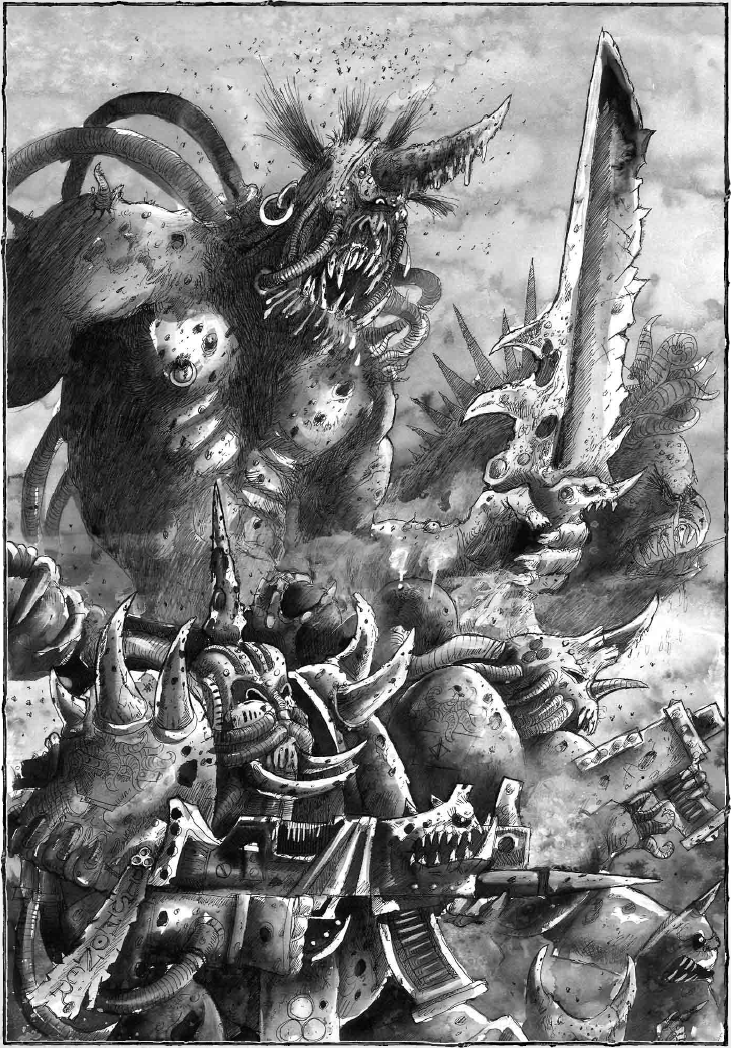
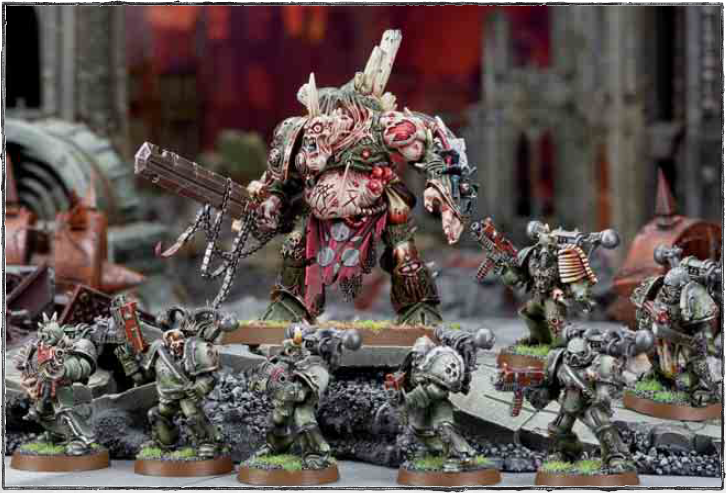
A Daemon Prince of Nurgle accompanied by a squad of noisome Plague Marines.

The pustulent Chaos Space Marines of Nurgle fight alongside renegades and Traitor legionnaires all across the galaxy. Where there is death and misery, the Plague Marines will swiftly follow.
Imperial Armour 6: The Siege of Vraks, part 2 (2008)
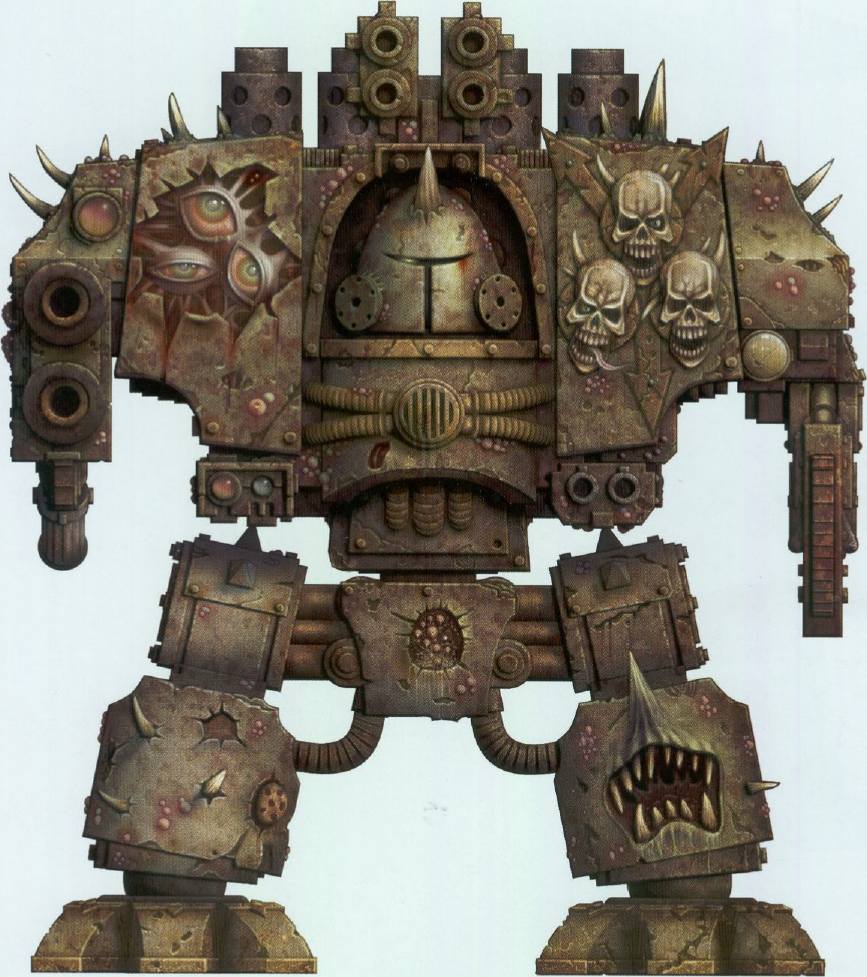
Chaos Dreadnought of the Deathguard. Like all those who have aligned themselves with the power of the Plague Lord and received his favour, disease and decay have covered the hull. This decay seems to have no effect of the Dreadnought's operations.
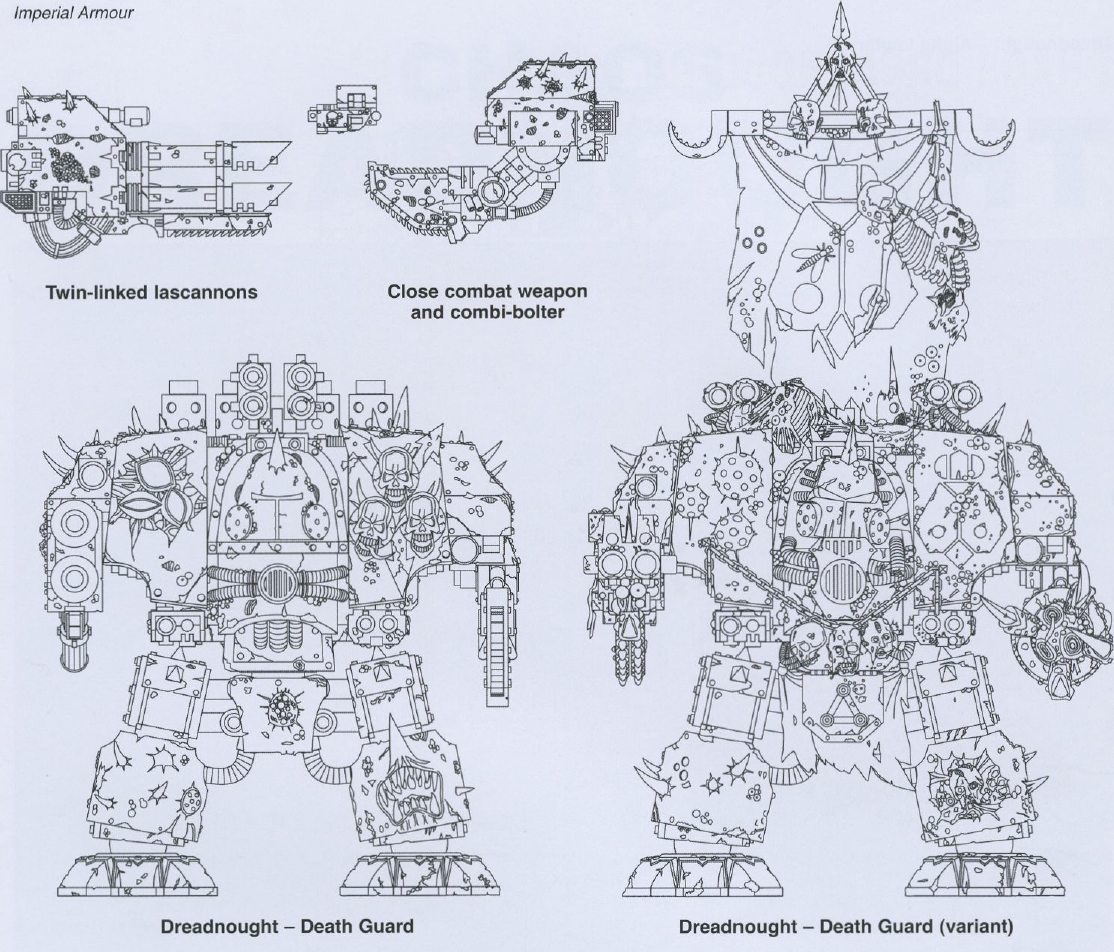
Imperial Armour 7: The Siege of Vraks, part 3 (2009)
1. Ancient Corroded Armour
Although this ancient suit of Power Armour has been corroded and corrupted almost past recognition, its structure still bears the hallmarks of the older style MkIII 'Iron' Pattern suits favoured by the Death Guard legion during the pre-Heresy era. Even though more modern suits had become available to them, the Death Guard retained a large stockpile of this heavier pattern, preferring it for both its durability and the ease with which they customised it to better handle the rigours of the toxic battle zones in which the Legion excelled. This armour suit has clearly suffered severe corrosion and structural breaches over its millennia of service and has been further modified with a heretical pattern 'open vent' reactor backpack, blasphemous iconography and has swelled to contain the monstrous bulk of its occupant.
At some point this armour has suffered catasrophic damage to the belly plate. The extent of armour penetration would indicate it was caused by a power weapon, most likely a raking blow from a lightning claw. The damage would have been terminal even for a Space Marine's enhanced physique, but to this Death Guard Marine the damage was merely superficial.
2. Bloated and Decaying Flesh
The flesh of the Plague Marine is bloated, distended and corpulent, seething with organic corruption and decay and terrible to look upon. The stench alone given off by them is enough to incapacitate. This seemingly dead and decaying flesh however makes the Plague Marine almost impossible to stop with conventional small arms fire, and they are able to shrug off injury and damage that would commonly defeat even the superhuman physiology of the Adeptus Astartes. In combat against these horrific servants of Chaos, mass concentrated firepower or weapons more commonly employed to deal with armoured vehicles are recommended as the key to a successful confrontation.
The decaying flesh also attracts maggots and flies. These creatures commonly accompany all Nurgle's forces, and some even cultivate them, considering them sacred creatures. Blistering through the armour's shoulder pads are maggot hives which constantly produce large fat black flies.
3. Plasma Pistol
In contrast to the Plague Marine's other equipment, this plasma pistol appears to be a more recent Imperial model, probably a Mk XI or XII 'single core' pattern, likely taken from the spoils of war on the battlefield. Already showing signs of corruption and ill-repair, the tortured machine spirit of this weapon will likely make it prone to catastrophic magnetic field failure and hazardous thermal flashbacks which would likely kill a human operator. However, given the Plague Marine's unhallowed tolerance for injury and pain, the dangers are likely to prove inconsequential to this malignant warrior.
4. Contaminated Blade
Of unknown origin and design, the Plague Marine carries a 'cleaver' type combat weapon of the sort often, and not inaccurately, named a "Plague Knife" by Imperial observers. Wielded with the superhuman strength and speed of these creatures, these unpowered blades can pierce most forms of body armour, and can breach the protection of ceramite powered armour if a vulnerable location is struck. If the skin of a victim is cut, the contaminated and necrotic slime that covers the blade will almost invariably infect the wound and poison the bloodstream, leading to a slow and agonising death in over 90% of cases. Even the augmented metabolism of the Astartes is not entirely immune to this effect. As yet the Adeptus Biologis have no antidotes that have any effect on the toxins. Rumours persist that some of these weapons are further empowered by the dark taint of the Warp against which no flesh can be spared. Only the Ordo Malleus know the truth.
5. Blight Grenades
Also known as a 'death head' grenade, it is made from a conquered foe of Nurgle. Constructed by Nurgle sorcerers, the severed head is covered with a waxy mix of slime and blood until it is watertight. The brain cavity is then filled with pus and left to fester, becoming a poisonous gas. The result is a missile which bursts on impact, releasing a deadly acidic gas.
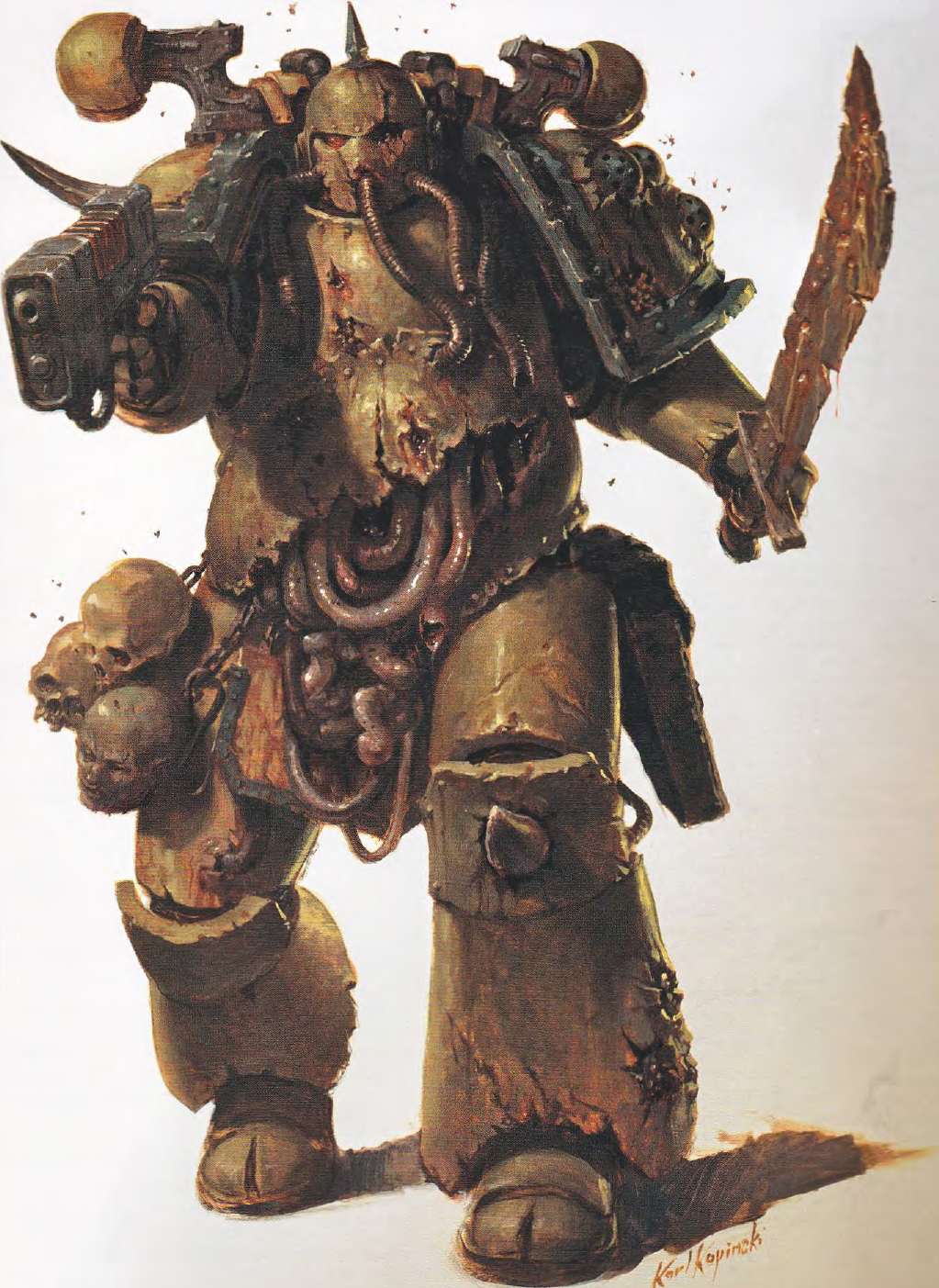
Black Crusade (2011)
The Death Guard followed Horus into heresy, their sense of loyalty to their Warmaster and their Primarch, Mortarion triumphing over their duty to the Emperor on distant Terra. The rebel Death Guard Legion was marooned in the warp during the long journey to Earth to join the attack on the Imperial Palace. A mysterious, unstoppable contagion spread through the trapped fleet, putrefying all it touched. Mortarion himself became infected and in his delirium he called upon the Powers of Chaos to aid his Space Marines. Mortarion's fevered ravings were answered by Nurgle, and Mortarion became Nurgle's Champion.
The Death Guard survived but they continue to bear the marks of Nurgle's first blessings upon them. Their once-white armour became stained and cracked where the bubbling foulness of their mortal bodies has erupted to the surface. They bear the three-lobed mark of Nurgle rendered as flies or rotting heads upon banners and shoulder guards. Their bolt guns and chainswords are caked with filth and rust but are no less deadly. Plague and contagion have become the Death Guard's primary weapons and they can be found anywhere in the galaxy spreading Nurgle's blessings.
First Founding (2011)
"In the embrace of great Nurgle, I am no longer afraid, for with His pestilential favour I have become that which I once feared: Death."
— Kulvain Hestarius of the Death Guard
The Death Guard are a Traitor Legion entirely steeped in the power of Nurgle, the God of Plagues, their very essence the epitome of all that vile Chaos Power stands for. Their bodies are hives of filth and decay, their flesh eternally rotting away even as it is renewed by the ceaseless process of death and rebirth. Once, however, the Death Guard were the strongest and most resilient of all of the Emperor's Legions, the inheritors of the Primarch Mortarion in whose genetic image they were created.
Mortarion grew to maturity on the world of Barbarus, a planet steeped in a toxic miasma where the human population cowered in the dark lowlands, fearful of the overlords that preyed upon them from their mountaintop keeps deep within the fog. History does not record who or what these beings truly were, but it is certain they were more than, or at least other than, human. For one, they were able to breathe the deadly gases that make up the atmosphere, getting ever more deadly the higher the altitude, but they are said to have displayed other abilities too. The abominable masters of Barbarus were somehow able to enslave or dominate the flesh of the dead, and they preyed upon the cringing natives in the valleys below, ever needful of raw material to fuel the endless wars they fought against one another.
The infant Primarch was raised by one such overlord, who taught him the ways of war, yet would not answer his questions regarding the people who dwelled in the lowlands. When Mortarion defied his master and descended through the fog, which as a superhuman Primarch he could breathe, he found people, like himself, if weaker and existing in perpetual terror of the overlords who preyed upon them each night. Though they were initially suspicious of him, Mortarion proved himself one of their kind, and moulded them into an army that at first defied the hunting parties of the overlords, and then turned the tables upon them. At length, the only one left was he who had been Mortarion's master, residing so high in the toxic strata that not even Mortarion could pursue him.
When the Emperor came to Barbarus, the people greeted him as their saviour, yet Mortarion was jealous and resentful of the adulation heaped upon this perfect stranger. Though his people could see that the Emperor was the Primarch's sire, he himself saw only the differences. Where the stranger was noble of form and tanned of skin, Mortarion was pale and gaunt. When he refused to join him, the Master of Mankind issued Mortarion a challenge - if the Primarch could defeat the last overlord of Barbarus, the Emperor would depart. If he could not, Mortarion must accept his fate and join the Great Crusade.
Mortarion accepted the Emperor's challenge and ascended into the toxic clouds, higher than he had ever travelled before. At length, he reached the grim keep of his former master and raged for the overlord to face him. Yet, even the Primarch's superhumanly enhanced body could not withstand the toxic atmosphere, but as he succumbed, he saw the golden figure of the Emperor step between him and the overlord, entirely unaffected by the poisonous air. With a single stroke of his mighty blade, the Emperor felled the last overlord, and Mortarion acceded to his fate.
Once the Primarch was united with his Legion, it was found that the Death Guard, as they became known, were amongst the most resolute and resilient of all the Legions. Mortarion's warriors were ever to be found at the centre of the battle line, their strength and determination the inheritance of their Primarch, making them the unbreakable core of any army of conquest. When the Horus Heresy plunged the galaxy into civil war, the warriors of the Death Guard found themselves becalmed in the warp and assailed by warp-born plagues so virulent that not even their legendary resilience could withstand them. Soon, the entire Legion was beset by a sickness that bloated their bellies with corpse gas, caused flesh to slough from their bodies and made these strongest and toughest of warriors into crippled wretches assailed by delirium. Though none can say exactly what forces acted upon the soul of the Primarch of the Death Guard, whether he was already damned or whether he made his pact in some state of fever, he must have called out for deliverance, and his call must have been answered. When finally the Death Guard Legion's fleet emerged from the warp, its vessels and its warriors were entirely changed. The once-gleaming white and grey armour was stained with filth, and the noble warriors were transformed into walking hives of death and abomination. Worse still, the "Plague Marines" of the Death Guard were now hosts for the most virulent afflictions that their new patron, the Plague God Nurgle, could concoct. Condemned to a deathless state of decay, the Death Guard would spread their pestilent diseases the length and breadth of the galaxy for the greater glory of Chaos.
For Ever After
With the ending of the Horus Heresy, the Primarch Mortarion led his Legion into the Eye of Terror, and while others had splintered into countless warbands, the Death Guard remained largely whole, thanks in no small part to their legendary strength and resilience. Mortarion led them to a world that would become known simply as the Plague Planet, which he moulded into a new and despicable form, making it a virtual copy of Barbarus.
To this day, Mortarion's Death Guard launch their assaults through the Cadian Gate and into the galaxy beyond, sometimes in large bodies and at others lending strength to allied forces. Wherever they travel they spread the joyful, exuberant poxes of Nurgle, gifting those who would know eternal life with the choicest of the Plague God's blessings. The Death Guard is known to be active in several warzones in the Jericho Reach, though so far only in relatively small numbers and acting as adjuncts to larger forces. There have been numerous occasions when previously unknown plagues have swept the defence lines of otherwise static fronts, followed hours later by an overwhelming enemy advance. Many amongst the crusade's high command ascribe such instances to the Death Guard, and are fearful of what vile diseases they might concoct next.
Codex: Chaos Space Marines (2012)
The final catalyst came from a rebellion in the Isstvan system. The Imperial governor upon Isstvan III had renounced his oaths to the Emperor and declared independence. The Emperor decreed that if the commander of Isstvan went unpunished, other worlds might follow. He ordered Horus to put down the rebellion by whatever means necessary, not knowing of the subtle changes Chaos had wrought upon the Warmaster's soul.
Horus chose to end the Isstvan rebellion swiftly and without mercy, employing virus bombs against Isstvan III from orbit. The voracious life-eater virus consumed every living thing upon the planet in a matter of minutes. Whole continents and cities were burnt to ashes as the mass of gasses released by the rotting organic material ignited in the atmosphere, scouring Isstvan III clean in a devastating firestorm. Twelve billion souls died with a death scream that momentarily pulsed brighter than the Astronomican. It was a signal to the Chaos Gods that Horus was now completely theirs.
Over one hundred companies drawn from the Emperor's Children, Death Guard, World Eaters and Sons of Horus Legions had already taken up arms against the rebellion on Isstvan III's surface. Horus had ensured their numbers were almost entirely made up of those Space Marines from each Legion who were still loyal to the Emperor, intending to wipe out those who had proved incorruptible in a single deadly stroke. Of these brave warriors, fully two-thirds miraculously survived the bombardment, thanks to warning messages received from the dwindling ranks of loyal comrades left aboard the orbiting fleet of Warmaster Horus. Angron, headstrong as ever, made planetfall at the head of fifty companies of Traitor Marines, and the gorund war began in earnest, signalling the start of the greatest turmoil to ever have engulfed the Imperium.
As the forces of Horus launched their orbital barrage upon the loyal Space Marines on Isstvan III, Captain Garro, of the Death Guard, seized the frigate Eisenstein from the traitor fleet. His instinct had led him to warn the loyal warriors on the planet's surface of their imminent betrayal, and he determined to flee the Isstvan system. Garro's vessel was no match against the powerful battleships of Horus' blockading fleet; all Garro could hope for was that the Eisenstein could escape from the Isstvan system and somehow find a way to reach Terra to warn the Emperor of Horus' treachery - he was unable to prevent the coming atrocities.
With the initial attack stalled, Horus brought his entire arsenal of weapons and warriors to bear. For over a month, the gigantic cannons of the rebel army pounded the walls, foremost amongst them the siege weapons of the Iron Warriors and the Legio Mortis Titan Legion. Eventually, after heavy bombardment, part of the curtain wall came crashing down and the Traitor Legions hurled themselves at the breach to pour into the inner palace. At the heart of the fighting stood the Primarchs. The indomitable Rogal Dorn of the Imperial Fists and noble Sanguinius of the Blood Angels fought a desperate rearguard action to halt the force pouring through the breach. Angron of the World Eaters slew loyalist Space Marines by the dozen, while Mortarion of the Death Guard led his pestilent Plague Marines into the thickest fighting. To the terrified populace of Terra, it was as if their world was drowned in battle.
'Great Nurgle, rain your feculent blessing upon us.'
Dripping with putrescence, the Death Guard match towards their prey as slow but sure as the onset of a pox. The Plague Marines that form the vast bulk of their forces are literally rotten from the inside out, each riddled with decay and entropy. If anything, this malfeasance only makes them stronger, their necrotic bodies so numb to pain that only total destruction can stop them. Grandfather Nurgle has been generous indeed to his favoured sons - their flesh pulses with corruption and bulges from cracked armour - and they share these gifts of suffering across the galaxy.
36th Millennium
437.M36 The Green Death
The infected Ork warbands invading the Ecclesiarchy world of Sanctia evince a terrible new barbarism. They fall upon the planet's defenders and consume them bodily, devouring the living and the dead alike, as if compelled by a daemonic hunger. Bloating and swelling, the Orks become obese monstrosities that can move only at a snail's pace. Puzzled by this strange reprieve, the Adepta Sororitas systematically purge the Orks with flame and bolter. It is then that Mortarion and his Death Guard make planetfall. The skeletally thin Daemon Primarch looms over the bodies of the Orks as he stalks to the front lines. At his passing, each Ork bursts apart in a shower of foul fluids, and dozens of Nurglings spill out from their remains to follow their master. Sanctia falls to the Green Death within twenty hours of Mortarion's arrival, and the plague spreads across the Ecclesiarchy-held system at an unstoppable pace.
41st Millennium
[...]
757.M41 The Plague that Walks
The first outbreak of the zombie plague occurs on Hydra Minoris after Typhus, and his Death Guard foot soldiers, penetrate to the heart of its capital hive. As the living begin to fall prey to the painful disease, its true horror is revealed; the dead victims begin to rise up and attack the living. The resultant Imperial quarantine traps 23 billion uninfected citizens alongside a rising tide of the undead.
'Decay and corruption of the flesh are their secret joys, and they are abominations in the eyes of men...'
Plague Marines are Chaos Space Marines who have sworn themselves to Nurgle, the Chaos God of pestilence and entropy. The first Plague Marines were warriors of the Death Guard Legion, trapped in the Warp upon their spaceships when the virulent destroyer plague struck their fleet. Mortarion and his Legion offered themselves up to the service of the Lord of Decay in return for their lives. Their bodies became bloated and swollen with the corruption festering within them, but they no longer felt the agony of the Warp-pox and did not die from its horrific symptoms.
Since then, many Space Marines have dedicated themselves to Nurgle, though few achieve the vaunted ranks of the Death Guard. Those who truly wish to join this most foetid of cadres must first swear loyalty to the Primarch Mortarion. Only then will Nurgle bestow upon them the corrupting ague that created the Plague Marines. Outside of the Death Guard, a favoured few Sorcerers of Nurgle know the secrets of the Plague Marines, and Abaddon of the Black Legion has won many of these spellcasters to his cause. In return for fealty and long service, these blight-mages will bestow their pestilent gifts in the Warmaster's name.
Plague Marines have disgusting, rotted bodies that stink of decay. The putrescent slime that oozes from their many weeping sores corrodes their armour and boils away their skin, but despite their horrific disfigurements, the Plague Marines are fearsome warriors indeed. Their rotting brains are inured to the agony of bodily corruption, making them all but immune to the pain or debilitation caused by battle wounds. The Plague Marines prefer short-ranged firefights, where they can appreciate the festering wounds they inflict upon their enemies even as they laugh off the bolts and las-blasts directed back at them. Should the enemy close to within arm's reach, the Plague Marines will defend themselves with plague-riddled knives and toxic blight grenades. These contain virulent toxins that eat away at armour and fill the air with thick clouds of blinding spores. The most ostentatious blight grenades are 'death's heads' made from the severed heads of fallen enemies, each filled to the brim with a cocktail of disease before being sealed with ancient wax.
As well as fighting at the behest of the Lords of Chaos, the Plague Marines dedicate their lives to spreading corruption and decay across the galaxy. The fleets of Nurgle that spew from the Warp spread contagion and pestilence across dozens of star systems. Once the Plague Ships are abandoned or their crews finally destroyed, the hulks float back to the Warp and eventually, perhaps guided by the hand of Nurgle himself, find their way back to a Plague planet where they are re-crewed for new attacks.
| | WS | BS | S | T | W | I | A | Ld | Sv |
|---|
| Plague Marine | 4 | 4 | 4 | 5 | 1 | 3 | 1 | 8 | 3+ |
| Plague Champion | 4 | 4 | 4 | 5 | 1 | 3 | 2 | 9 | 3+ |
Unit Type
Infantry.
Plague Champion is Infantry (Character).
Wargear
Power armour (pg 68), boltgun, bolt pistol, plague knife (pg 64), blight grenades (pg 66), krak grenades.
Special Rules
Champion of Chaos (Plague Champion only) (pg 28), Fearless, Feel no Pain, Mark of Nurgle (pg 30).
The Cloud of Flies
During a Plague Ship's journey through the Warp, the interior of the craft erupts with large, furry black flies, which fill the ship with their decaying carcasses. When the Plague Ship reaches a world, the Plague Marines disembark to make planetfall. As soon as their transports' hatches open, a thick cloud of insects is released, ready to spread its foulness over a virgin planet.
Codex: Dark Angels (2013)
101.M34 Noble Passing
While leading his Chapter to victory in the Bloodpox Campaign against the Death Guard and the Brotherhood of Plague, the twelfth Supreme Grand Master of the Dark Angels, the esteemed Armaros contracts the loathsome pox. His rapid deformation convinces the Supreme Grand Master to immediately pass the Lion Helm to his successor. To ensure the contamination does not spread, Armaros voluntarily enters the Rock's reactor chamber and is wholly consumed.
Dataslate: Helbrutes (2014) — A Menagerie of Monsters
Thanks to their omnipresent madness, it is possible to generalise about the battlefield roles of Helbrutes. However, no two of these roaring metal beasts are ever exactly the same in appearance. The influence of the Chaos Gods - coupled with the pilot's own dark dreams of glory - will twist each Helbrute's physical form within the Warp. Meanwhile, the warband to which a Helbrute owes allegiance will decorate the beast's armoured hide to their taste. Many emblazon their warband's iconography upon their Helbrutes, and bedeck them in the trappings of their twisted faith. Others leave the maddened machines to mutate however they will, believing it against the will of the gods to interfere in the Helbrute's apotheosis. Thus a Helbrute of the Death Guard may degenerate into a bloated hulk of rusting metal and suppurative, weeping flesh.
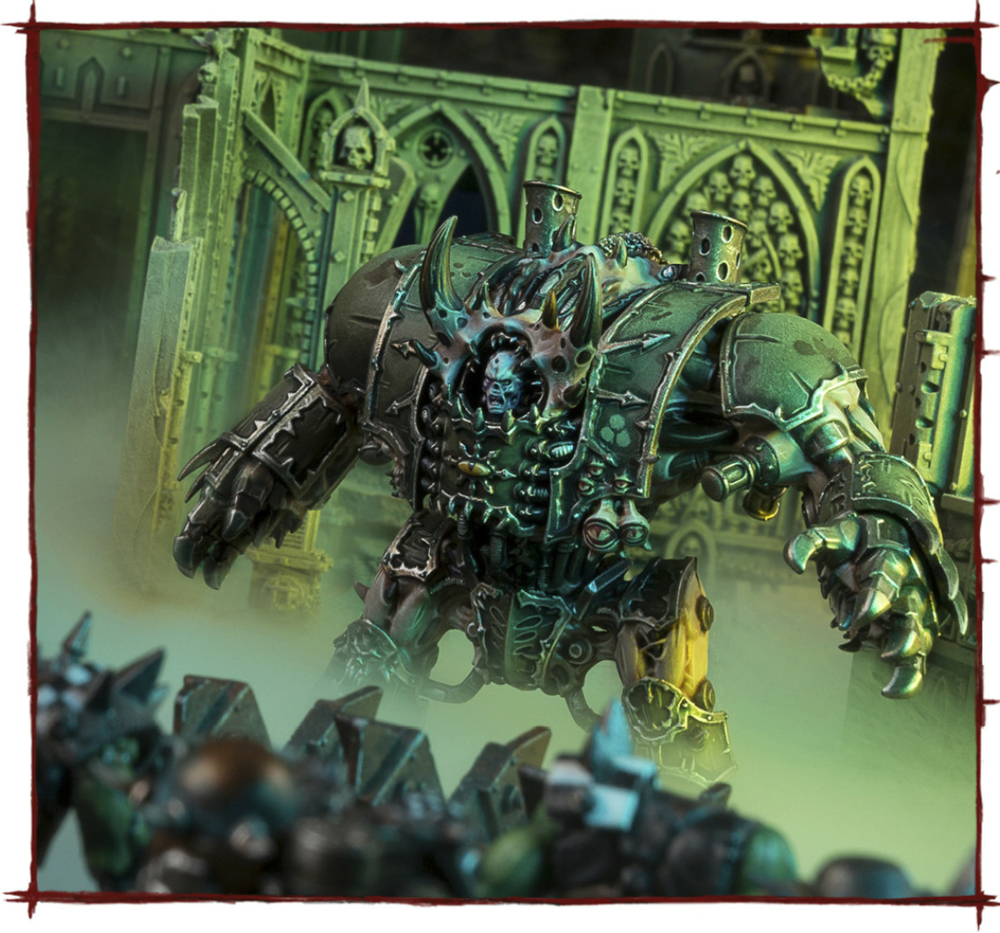
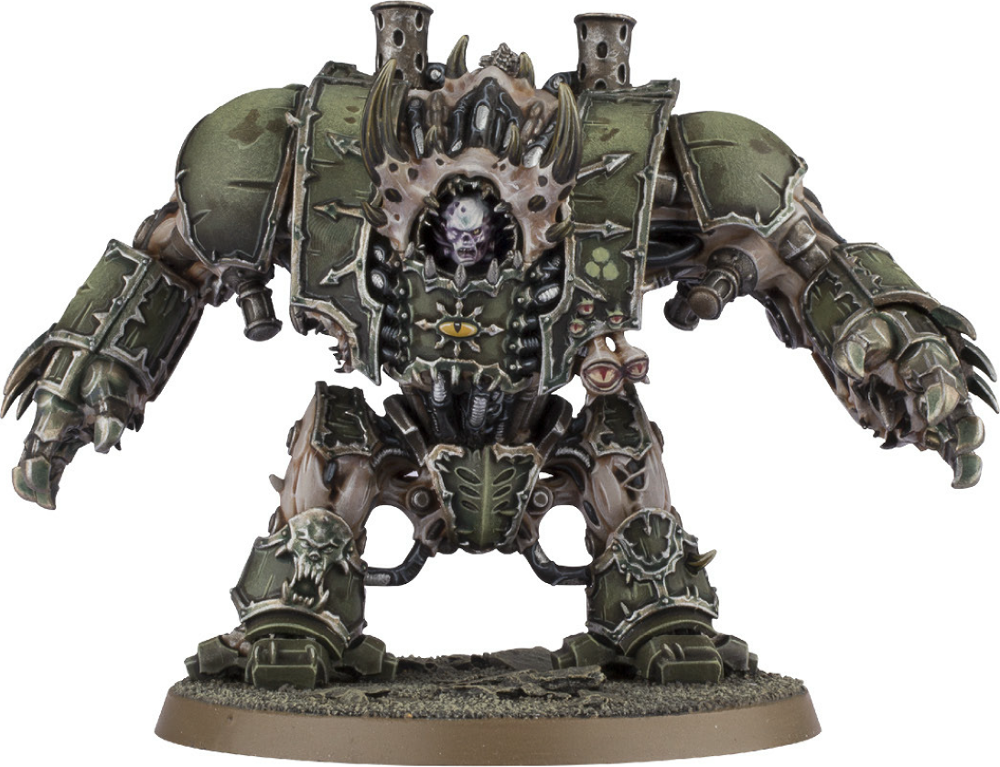
Death Guard Helbrute
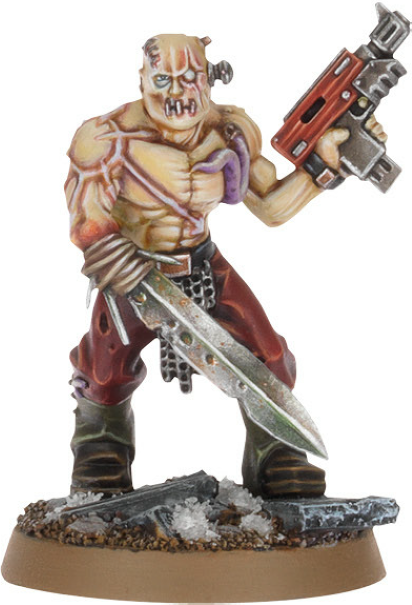
Converted Death Guard Chaos Cultist
The Tome of Decay (2014)
Chaos Space Marines
Corruption. It is a word that lies at the heart of the most divisive, destructive, and long-lasting conflict the galaxy has ever known. It was corruption of the spirit that caused Horus and half of all Space Marine Legions to turn on the Emperor of Mankind. Corruption of will broke the resolve of thousands of warriors who found the unrelenting hardships of serving a weak cause in support of a cruel master too much to endure. Corruption of faith cast thousands more down a fresh path of glory and freedom, embracing new, darker masters that blessed them with tangible gifts and rewards rather than fleeting promises and thankless suffering. Corruption of the body - the infirmities of ageing forms, infected wounds sustained in battle, and the ravages of illness were sufficient for countless others to turn to the only being capable of saving them from the misery of their decline - Nurgle.
Among the first to abandon the Emperor and embrace the Lord of Decay were Mortarion and his Death Guard. Abandoned by the Corpse God of Man and left to a fate of starvation and disease, they struck a bargain with their new corpulent master, Nurgle, and were saved. The pain of their affliction was numbed. Their bodies became hosts to maggots, flies, and a host of contagions. They were given renewed strength and a purpose they had never considered before. As Plague Marines, they embraced corruption in all its forms as a natural and inescapable part of life. Thus empowered and enlightened, they set about the task of taking the blessings and revelations of Nurgle to the masses. They became Nurgle's rotted fist, spreading his infectious message of hope and perseverance to the battlefields of the galaxy. But they would not be his only power armoured servants.
War zones are breeding grounds for all manner of corruption. They present ample opportunity for Nurgle's truths to manifest and present themselves to those who have open eyes with which to see them and the cunning to make use of them. Plague Marines such as the Death Guard and others spread disease with each toss of a blight grenade or thrust of a plague knife, but other forms of decay shape events as well. Fragmentary warbands from many of the Traitor Legions and renegade Space Marine Chapters, though not particularly given to devout worship of Nurgle, know in their twisted hearts that the Pox Lord is correct in that collapse is inevitable. The Lord of Decay teaches that nothing is permanent, and it is a lesson these Chaos Space Marines have learned well.
Even after a battle has been won by the Legions of Nurgle, his presence continues to have an effect. Broken bodies lay rotting, their organs and flesh turning to mush and renewing the soil into which they seep. Though their approach is less subtle than that of a lovingly crafted plague, Chaos Space Marines are remarkably efficient at converting massive armies of enemy flesh into the raw materials of rebirth, and therefore he embraces their service to him with glee.
"The Imperium drew its last breath long ago. We are merely awaiting its death rattle, and then entropy shall claim its long-awaited victory. We are patient. We have waited ten thousand years. We will wait ten thousand more, if necessary. But I do not think it will be."
— Lethrax the Blighted Hand
For a Plague Marine or other Chaos Space Marine in the service of Nurgle, the timeless nature of existence within the Warp is a gift beyond measure. Many of the lessons and experiences that lesser mortals are unable to fully appreciate, let alone comprehend in any significant way, are theirs to explore. It gives these warriors an eternity to ponder the grandeur of their master's plan for ultimate corruption. The many diseases they have within them are given time to percolate and properly evolve into ever more deadly forms. Perhaps best of all, it may allow them to live long enough to see rot claim the body and soul of the False Emperor as he withers away to nothing on his Golden Throne. While the unfocussed followers of Tzeentch waste time in futile attempts to find new ways to breach the Imperial Palace, the patient Chaos Space Marines of Nurgle know that inevitability is their ally. They have but to wait for the great victory, for nothing is eternal - not even the Emperor and his domain. For these enlightened and blighted warriors, the Long War does not seem as long as it does to others.
This is not to say they do not harbour the same righteous hatred for their former brothers that all Legions share. While they know they could simply wait for victory to come to them, they choose to follow the example of Nurgle himself and take a more active role in the downfall and renewal of the galaxy. Eternity offers them many ways to revel in the joy of living and to gain satisfaction from the death they can bring to their enemies. There are a thousand worlds ripe for virus bombing. Billions of souls wait to be tormented by plagues of the spirit. The flesh and bones of entire Space Marine chapters are there to be harvested and used as experimental subjects for Nurgle's constantly mutating catalogue of diseases. It is the duty and privilege of the veterans of the Long War to see to it that no opportunity to further the great cycle through acts of vengeance upon the Emperor's lapdogs passes by.
The betrayals committed against the Legions in the days of Horus' war against the bonds of undeserved servitude are fresh in the minds of all who fought in those days. Let Khorne's brainless savages mutilate the warriors of the Adeptus Astartes. Such violence has a place. If the appetites of Slaanesh's brain-addled devotees get lost in the pleasures of the kill, so be it. Even the erratic, misguided actions of Tzeentch's minions can, at times, create diversions that force the enemies of the Ruinous Powers to weaken. None of this can compare to the all-encompassing totality of the Plaguelord's grand design. As empires crumble, stars collapse upon themselves and each and every pathetic Space Marine chapter fades from memory, Grandfather Nurgle and his chosen servants will have the last laugh. The galaxy will die, and from its death throes a new existence shall come into being, with Nurgle ruling as lord over it all. Not a single one of the Emperor's loyal, wretched offspring shall persist to sully it.
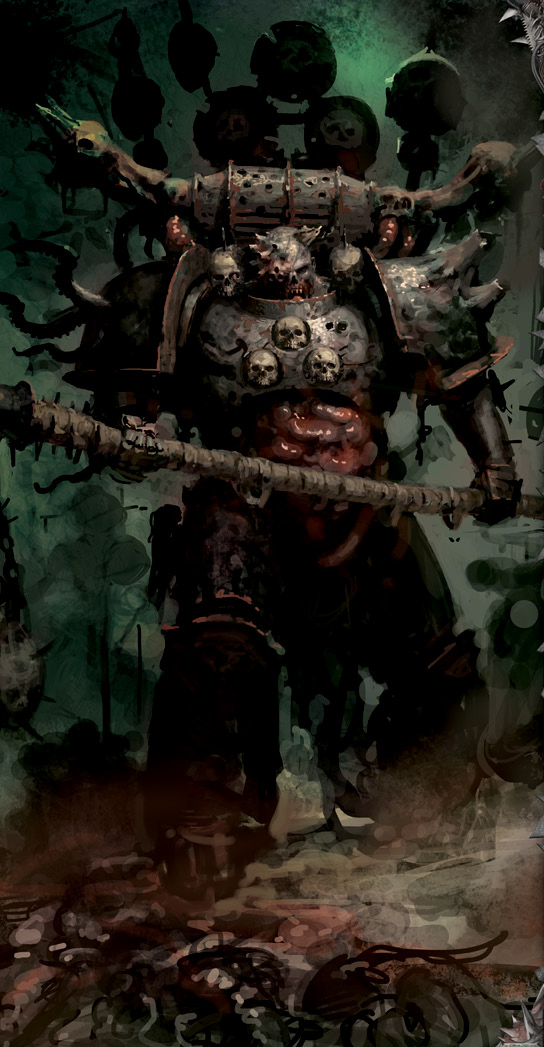
Though now considered one of the Imperium's most abhorrent foes, the Death Guard were once counted among the most relentless and resolute of the Emperor's warriors. The cryptic Stygian Scrolls claim the Legion hailed from the planet Barbarus, a toxic world wreathed in a perpetual poisonous fog. As a result, the planet's inhabitants became extremely resilient to their poisonous home world, a trait that would eventually give rise to the Death Guard's infamous ability to operate in even the most toxic warzones. This hardy constitution, combined with a grimly stoic demeanour and brutally efficient infantry tactics, made the Death Guard one of the most determined and reliable forces within the Great Crusade.
Yet when Horus led half the Space Marine Legions in rebellion against the Emperor, he was able to sway Mortarion, the Death Guard's pallid and grim Primarch, to join him in tearing to the ground all that his father had accomplished. What exactly motivated Mortarion to betray the Imperium is lost to history, yet he and his warriors eagerly joined the other traitors in their campaign of destruction, crossing into the Warp en masse to aid in the assault on Holy Terra.
However, shortly after their transition, the Death Guard were becalmed within the fickle Warp tides, while a strange and devastating plague of unprecedented virulence ravaged the Legion and their attendant fleet. Even the legendary physiologies of the Space Marines could not save them as one by one each of the Death Guard was overcome, their superhuman bodies bloated and distended as the foul contagion transformed them into shambling, diseased grotesques.
Yet none are believed to have suffered as greatly as Mortarion, who was forced to watch his progeny stumble in unending anguish through the disease choked confines of their helpless vessels without hope of escape or death. In desperation, Mortarion offered up his soul and the souls of the remaining Death Guard to the Warp in exchange for his Legion's salvation, and it was Nurgle, Lord of Disease and Decay, who answered his prayer, saving the Death Guard and ensuring their eternal damnation.
What eventually emerged from the Warp within their filth-covered plague ships were not the stoic and austere Death Guard of old, but the first and most deadly of the Plague Marines. Led by their Primarch, the transformed Legion burst forth upon the Emperor's Palace of Terra like a tide of putrid corruption, their disease-encrusted bulks and rust-covered weapons wreaking a devastating toll upon the Imperial defenders.
The Heralds of Decay
In the wake of Horus's defeat, the Death Guard retreated to the Eye of Terror alongside the other Traitor Legions, their steadfast demeanour allowing them to avoid the disarray and anarchy that afflicted many of their traitor brethren. Upon entering the Warp, they laid claim to a blighted world near the borders of reality now known as the Plague Planet. The Death Guard are said to dwell there still, and it is from this poisonous rock that the Legion continues to strike out at their Imperial enemies, their massive plague ships bursting with diseased followers eager to bring despair and desolation to mankind. Those insane and corrupted individuals who claim to have set foot upon it say it is a toxic world of corruption and pestilence whose skeletal ruler dwells within his wrought-iron bastion upon the world's highest peak.
Since their fall, the Legion has utterly dedicated itself to propagating Nurgle's corruption, its diseased fleets spewing from the Warp to spread his vile plagues across countless worlds. In battle, they are as utterly relentless as ever, inexorably advancing in the face of withering fire while using their rust-covered bolters and poisonous Plague Knives to brutally dispatch their foes. Their bloated and diseased bodies are immune to fear and pain, often allowing them to causally ignore wounds which would kill lesser men.
Throughout their centuries of raiding, the Legion has gradually split into smaller and smaller units, each led by a particularly deadly Champion of Nurgle in addition to the untold numbers of foetid, Warp-spawned servants that accompany them. In keeping with their corrupt heritage, the Death Guard primarily fight on foot, relying heavily on infantry tactics and their own diseased physiologies to overpower their enemies. Many of these repulsive warriors are the same traitors who burst forth from the Warp during the fabled Battle of Terra centuries ago, while others are more recent converts who have sworn allegiance to both Mortarion and his noxious patron.
Scattered warbands of Death Guard frequently operate within and around the Screaming Vortex, ever eager to reduce the many worlds surrounding those unnatural currents to stinking morasses of putrefaction. Though few in number, they frequently swell their ranks with denizens of the Vortex who wish to spread Grandfather Nurgle's bounty as well as the numerous Traitor Space Marines who have embraced the path of decay. Yet there is a change coming within the Vortex, with many isolated warbands uniting beneath the pestilent banner of a malevolent new champion who has emerged from the eternal warzones that surround the Calixis Sector.
Known only as Buorgdius, legend has it that he was once a proud captain of a Space Marine purgation force that was sent to facilitate the eradication of Chaos forces within the Acheros Salient of the Jericho Reach. After months of brutal campaigning, a rogue plague ship unexpectedly burst forth from the Warp and rammed his Strike Cruiser before vomiting its rotting warriors directly into the vessel's interior. It is said that the Captain fought with terrible fury, cutting down all manner of plague-ridden monstrosities while enduring the foul swarms of flies and noxious clouds of contagion that choked every corridor and assailed his superhuman frame.
By the time he reached the bridge, the mighty warrior could barely stand, while behind him his battle brothers lay dead or dying and the servants of Nurgle ran rampant throughout the hallowed halls of the venerable Strike Cruiser. The bloated Daemon-thing that confronted him within that necrotic bubo laughed at the weakened Captain's plight and raised his massive weapon to strike the killing blow. In that moment, the Captain despaired, crying out in anguish and pleading for the strength to kill his foe. Suddenly unhindered by the innumerable infections that festered within his body, the Captain struck out with renewed vigour, smiting his opponent and claiming his place at the plague ship's helm.
Now he is a Champion of Nurgle whose plague fleet plies the outer fringes of the Screaming Vortex, unleashing its revolting warriors against those unfortunate enough to fall afoul of their diseased and leprous hulks. In combat, Buorgdius leads the reanimated corpses of his former Space Marine brethren into battle while wielding a massive mace crafted from the diseased bones of his unholy predecessor, and dripping with repellent Warp energies. Afterward, his undead warriors stuff the innumerable dead and dying into the filthy, dank plague holds of his vessels in order that they may moulder in the foetid darkness. In this way, the champion recruits many of his mightiest warriors, and he is said to offer a place in his warband to any who will but supplicate themselves before the Lord of Decay.
"I have wandered amid the decomposing copses of my master's Garden, and drank deep from the stagnant pools of corruption at his feet. Soon you shall see what true power means."
— Plague Captain Despoidiol, Champion of Grief
The Lord of Decay has many servants that dwell within the swirling eddies of the Screaming Vortex. Among the greatest of these are the Plague Marines, warriors whose putrid appearance is matched only by their determination and unnatural resilience. While the Death Guard are the most notorious of these vile individuals, not every Traitor Marine that follows the path of decay owes his allegiance to that polluted lineage, for Nurgle's corrupt abundance is available to all who prove worthy of his favour. Yet regardless of their origins, the denizens of the Vortex often give these grotesque brutes a wide berth, as each is always eager to share their bounty of disease and death.
Playing a Plague Marine
Plague Marines are amongst the most terrifying and relentless of Nurgle's servants, undaunted in the face of death and heedless of all but the most devastating wounds. Their rusty armour and weapons are coated in filth, pus, and other foulness, while rotting organs burst from rents in their distended forms, and teeming hordes of insects burrow beneath their pallid, leprous flesh. Such is the extent of the decay that wracks their diseased frames that their crumbling armour has long since fused with the decayed flesh beneath, while the very air surrounding them is a cloying miasma of disease.
Yet, despite their ghoulish appearance, these warriors are far from dead. Instead they are living embodiments of the promise of corruption and decay within all living things, a gift of their foul patron in return for their devotion to the propagation of his numerous contagions and poxes. However, though many Chaos Space Marines may dedicate themselves to the Plague Father's service, only those truly worthy of his favour receive the dreadful blessings required to transform them into a Plague Marine.
Many receive their abhorrent favours in exchange for deplorable acts of adulation or through pacts with powerful plague sorcerers and other foul servants of Nurgle. Others embrace the path of decay out of desperation, their disease-addled minds choosing servitude over agony and death at the hands of their afflictions. In the end, such motivations are secondary to the unholy task of spreading Nurgle's sinister bounty, and each Plague Marine embraces his devotions with inexorable energy.
In battle, Plague Marines fight without respite or mercy, their bloated bodies and legendary physiology rendering them immune to nearly every physical limitation as they eagerly kill in the Plague God's name. Most prefer short-ranged engagements where they may more readily appreciate the necrotic effects of the poxes and contagions they spread, all while revelling in the disparaging moans of the dying.
To a Plague Marine, such cries of agony are praise for the virulence of their dark lord's works, while every cry for mercy is yet another opportunity to expand their glorious host. For this reason, some prefer merely to wound their victims so that they can fully experience the agonies of Nurgle's generosity, while for others there is no greater satisfaction than to watch their enemies dissolve into a diseased mass of liquefied flesh.
Plague Marines are rightly feared throughout the Imperium as deadly adversaries whose dreadful appearance directly mirrors the rotten soul within. As such, many warlords within the Vortex find their skills, relentless determination, and resilience to physical damage highly useful on the field of battle. However, a Plague Marine's sole drive is the propagation of his malevolent patron's pestilences, so it is always this inexorable purpose to which his rotting mind returns.
Plague Marine
A Plague Marine must be a Chaos Space Marine.
Characteristic Bonus: Plague Marines -10 Agility, +10 Toughness, +5 Willpower, +15 Corruption Points, and +7 Infamy.
Starting Skills: Awareness +10, Common Lore (Any One), Forbidden Lore (Daemonology) or (Heresy) or (Psykers), Intimidate +10, Parry +10.
Starting Talents: Ancient Warrior or Die Hard, Bolter Drill, Exotic Weapon Training (Plague Knife), Fearless, Iron Jaw, Hardy, Hip Shooting, Rapid Reload, Sure Strike or Deadeye Shot, Takedown or Blind Fighting.
Starting Gear: Legion Boltgun with 2 magazines, Plague Knife, 3 Blight Grenades, 2 Legion Krak Grenades.
Wounds: 18+1d5.
Special Abilities:
Abominable Physiology: The numerous parasites and virulent diseases that eat away at a Plague Marine's armour and liquefy his diseased flesh also make him unnaturally resistant to harm. A Plague Marine never suffers Damage or other negative effects from Diseases, poisons, or the Toxic Quality unless he chooses to suffer these effects (although he can still be infected by Diseases as normal, and can spread them to others).
Hideous Resilience: Plague Marines have been known to walk unflinching through terrible fire and shrug off mighty blows that would cleave other Space Marines in twain. As a Reaction, a Plague Marine may make a Difficult (-10) Toughness Test. If he succeeds, he reduces the Damage from the next hit he suffers before the beginning of his next Turn by 1 per Degree of Success he scores on the Test. If he reduces the Damage to 0 this way, he gains the Fear (1) Trait to the foe whose attack he so easily withstood.
Infectious Miasma: Plague Marines are revolting testaments to the horrific bounties that await those who embrace the Lord of Decay, their bodies dripping with foul pestilences and contagions that hinder their opponents in combat. A Plague Marine may spend an Infamy point to release the swarms of bloat-flies, corpse-gases, and other vile contagions housed within his bloated frame. For the next 1d5+1 Rounds, at the start of the Plague Marine's Turn, each other character within 10 metres of the Plague Marine suffers a single hit for 1d10 Energy Damage with the Toxic Quality, ignoring armour that is not environmentally sealed.
Plague Marines begin play Aligned to Nurgle.
Plague Marines in the Vortex
Plague Marines are among the most revolting and vile of the Chaos Space Marines that inhabit the Screaming Vortex. Yet to those who revel in the glories of the Carrion Lord, these putrid warriors rank among Nurgle's most blessed servants, and most find willing allies within the Vortex's most wretched and polluted throngs.
The following are examples of these repulsive Traitor Space Marines from within the Screaming Vortex and their despicable practices of pestilence and wicked devotion.
Germinatoris: One of the most vital positions within the Adeptus Astartes is that of the Apothecary, a warrior medic tasked with harvesting the precious gene-seed from the fallen in order that the chapter may endure. Yet within the Screaming Vortex there exists a coterie of Plague Marines who grotesquely mirror their noble counterparts. Like carrion feeders, they prowl the battlefield, plundering the gene-seed from any fallen Traitor Space Marines they can find and infecting them with the viscous fluids that ooze from their rotting innards in order to ensure the propagation of Nurgle's putrefying influence.
Forsaken Host: Among the many tales of terror and death found within the Screaming Vortex is that of the Forsaken Host, the solitary survivor of a battle which scoured an unknown planet of life during a forgotten age. Legend says a host of fat, buzzing flies accompanies him - one for each of the fallen during that fateful battle - and that their collective buzzing tears at the sanity of those who hear it, for it is filled with the suffering of billions. Now he is a walking avatar of the devastation of war whose followers relentlessly seek new souls to add to the teeming hordes that swirl about him with ghoulish intensity.
Emissaries of the Wasting Death: The Plague Marines of the Wasting Death are particularly feared among the many denizens of the Screaming Vortex, for their very presence brings with it untold suffering and privation. Wherever they tread the ground shrivels and cracks beneath their feet, and even the heartiest and most resilient creatures shrivel and perish as they draw near. Contact with the malefic air of deprivation that surrounds these desiccated warriors irreparably scars those who survive, often manifesting in incessant pangs of unquenchable thirst and indescribable hunger that lasts for years after the dreadful encounter is a distant memory.
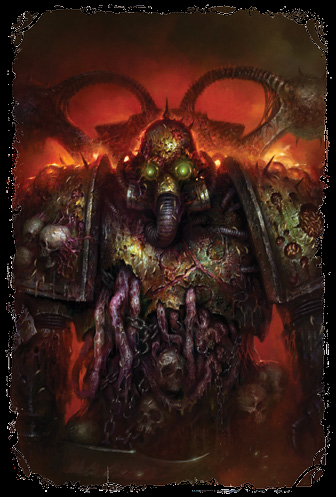
Imperial Armour 13: War Machines of the Lost and the Damned (2014)
Early to Late M31 - The Wars of the Great Scouring
Following the Siege of Terra and the death of the Warmaster Horus by the hand of his father the Emperor, the Traitor Legions - the Sons of Horus, Death Guard, Emperor's Children, Thousand Sons, World Eaters, Night Lords, Word Bearers, Iron Warriors and Alpha Legion - are driven from Terra and those regions they captured during the Horus Heresy. In an apocalyptic campaign of vengeance every bit as destructive as the civil war itself, the Traitor Legions splinter and many are driven into the Eye of Terror, where even the Loyalist Legiones Astartes may not follow. Throughout this age of war, the taint of the Warmaster's betrayal is found to have left barely any world untouched and the wars of vengeance and retribution grind on for many centuries, even as the remnants of the Traitor Legions vie for ascendancy within the Eye of Terror.
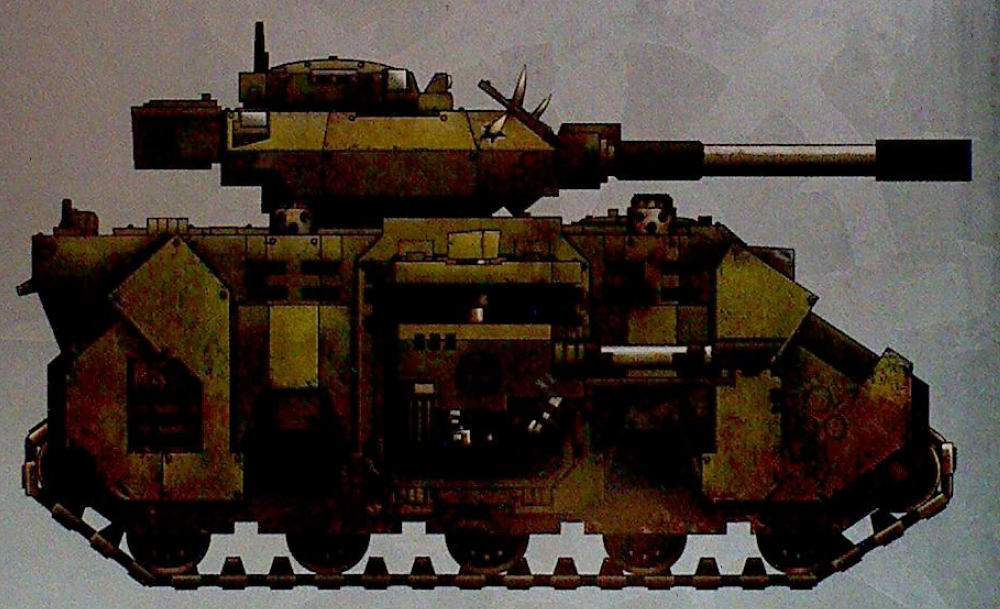
Predator Battle Tank of the Death Guard Traitor Legion. Once conforming to the Mars pattern and equipped with additional armour plating, this vehicle bears the beginnings of the stigmata of corruption so redolent of the taint of the Plague God to whom the Death Guard so long ago sold their souls.
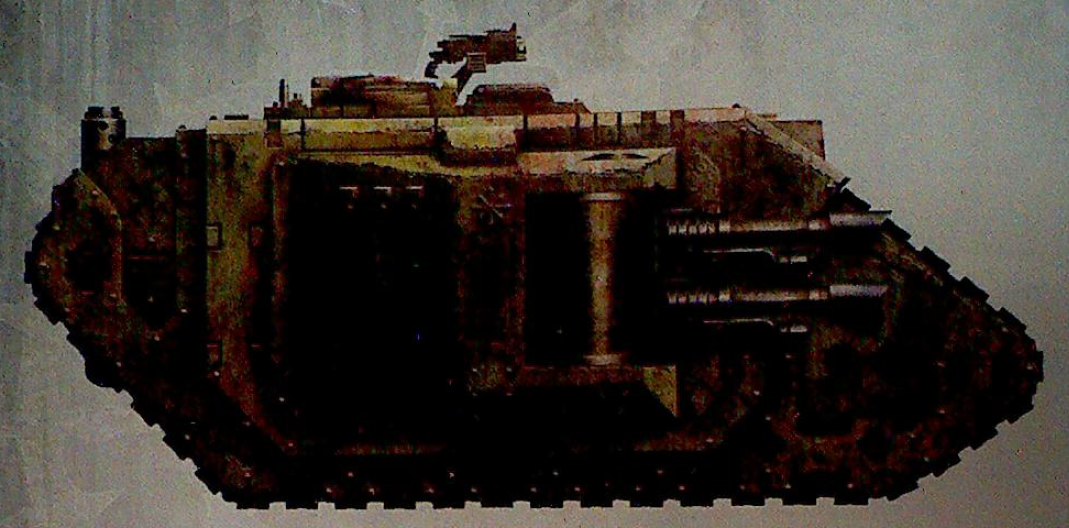
Land Raider captured by the Death Guard Traitor Legion from a Howling Griffons Chapter strike force at the Assault on Black Beacon. Depicted here as it appeared at the Siege of Vraks in 822.M41, displaying early stage corruption by the influence of that Daemon-tainted world.
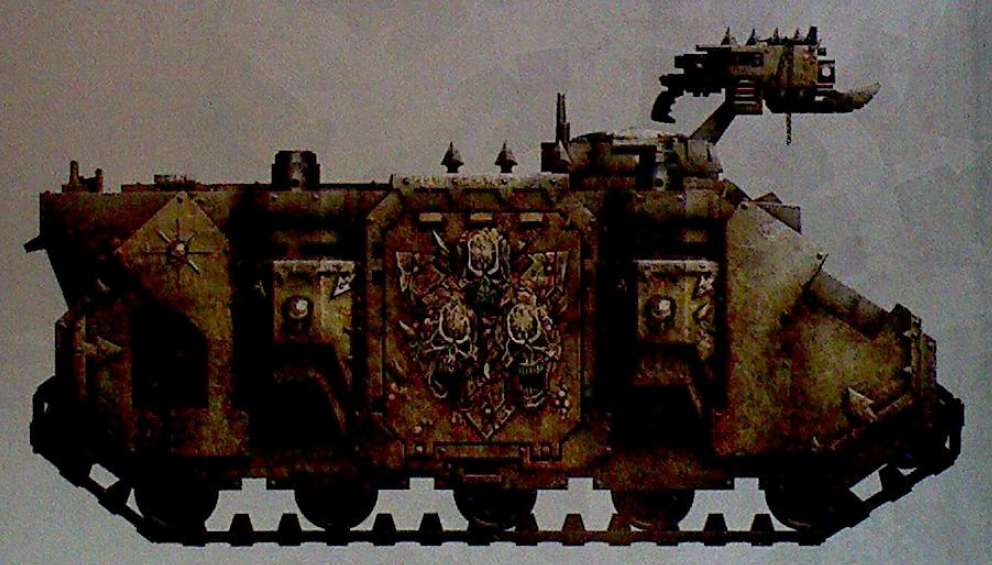
Rhino armoured carrier of the Death Guard Traitor Legion, corrupted Mars pattern with additional armour plating. Assault on Urath, Agripinaa System, 13th Black Crusade. This vehicle bears extensive signs of the taint of the Plague God, Nurgle, including surface blistering and corrosion. Also note banding and spikes common to many war machines in the service of the Ruinous Powers.
Perhaps the most singular and most disturbing Chaos Dreadnoughts however belong to the Death Guard Legion. These monstrous creations seethe with organic corruption, their hulls blistered with oozing sores and weeping, filth-encrusted wounds and other stigmata of the Plague God, Nurgle. What living nightmare is experienced by the occupant of such a vile and horrific machine is best left unimagined.
Codex Supplement: Traitor Legions (2016)
Even before the Horus Heresy, the Death Guard did not manoeuvre fancifully, or concern themselves with confusing their opponents; they picked the best ground upon which to fight, then smashed their foes after they had broken themselves against the Death Guard line. There was no environment which Mortarion, their Primarch, or the Death Guard feared. Thanks to their superhuman ability to resist poison and disease, no toxic smog or corrupted atmosphere deterred their course. What Mortarion and his adepts could not devise means to compensate for, the Death Guard overcame through sheer resilience. The Warmaster Horus above all others recognised the value of the Death Guard; he would often place Mortarion and his Legion in the centre of his battle line, counting on the enemy's inability to oust them so that he could either lever his advance from the rock of Mortarion's immovable position, or use it as the anvil upon which his hammerblow assault would break the foe.
When Horus led his attack on the Emperor, the rebel Death Guard Legion became marooned in the Warp while attempting the long journey to Terra. Days passed while the fleet's Navigators searched for a Warp-tide that would bring them back to the material universe. Meanwhile a mysterious contagion began to spread from ship to ship.
The stinking pestilence bloated the gut, distended the flesh, and turned its victims rotten from the inside. For the Space Marines of the Death Guard there was nothing so terrifying as the Destroyer plague which made their legendary resilience meaningless. These were the warriors who the Imperium had sent to conquer worlds no other man could set foot upon, much less fight on and win. There had been no pestilence, contagion, toxin or pollution potent enough to overcome Mortarion and the Death Guard, until the plague raced through their fleet. It roiled in their guts, warping their once superhuman bodies, transforming them into horrible, pustulent grotesques. They were made corrupt within and sickening to behold without and they grew sicker and sicker, yet could not die, their own constitution becoming their worst enemy. Eventually even Mortarion became infected, and in his delirium he called upon the powers of Chaos to aid the Space Marines. Mortarion's fevered ravings were answered by Nurgle, and he became Nurgle's champion.
The Death Guard, newly dedicated to Nurgle, arrived in time to take part in Horus' attack on Terra and fought in all of the major battles of the campaign. What emerged from the Warp when the Death Guard fleet broke out bore little resemblance to what had entered. The gleaming white and grey armour of Imperial champions was no more, burst and shattered from the horrific bloating of infected bodies, scabbed with boils, putrescence and the filth of corruption. Their weapons and machinery of war were now powered by the sickly sorcery of Chaos, glowing with lambent green luminescence and oozing gangrenous pus. The name Death Guard itself would pass into secondary use, as the walking pestilence-carriers became a terrifying sight across the Imperium. To their victims, to their erstwhile allies, even to themselves, they had become the Plague Marines.
The beliefs of the Death Guard echoed those of their Primarch, and a resolute determination that individuals should be free of oppression and terror became a conviction that individuals were not suited to decide what was just for them. A faith in inner strength, iron will and unshakeable resolution in the face of hardship led to pride, arrogance and an utter contempt for those they deemed inferior. When Nurgle's blessings came to the stranded Death Guard, their pride and arrogance were revealed, and their contempt for weakness turned upon themselves. Their surrender to Nurgle left them with only one seething, burning outlet, stoked white-hot by the depth of their self-loathing: to infect the strong, slay the weak and rot the foundations of everything in their paths until it collapses. Their debasement would no longer seem so shameful, if the pestilence of their Unclean Lord eventually brought everything to ruin.
After Horus' defeat, Mortarion led his Death Guard in a merry dance of destruction over a score of planets, until finally retreating with his Legion into the Eye of Terror - but not in disarray, as many of the other Legions did. Even in damnation, the resilience of the Death Guard remained, and under the direction of their Master they withdrew into the Eye intact, loyalist Space Marines and Imperial Army regiments breaking upon them time and again. There, Mortarion received Nurgle's ultimate reward, and became a full-fledged Daemon Prince, ruling over one of Nurgle's greatest Plague Worlds in the Eye of Terror.
With Mortarion elevated to daemonhood, his hand upon the Legion became more remote and the Death Guard gradually became broken up over space and time into smaller units. Warriors of the Death Guard are most often seen afoot, or at best accompanied by mad, plague-infested Helbrutes. Few of the tanks and transports of the Legion still function, their upkeep and maintenance being no priority to Space Marines dedicated to the Incarnation of Rot and Decay. The Daemon Prince Mortarion remains master of the Death Guard even after their fall, however dispersed they become, orchestrating their movements unseen from his bubonic throne.
Even after the end of the Horus Heresy, the primacy of the foot soldier remained ever the trademark of the Death Guard. Their grim Primarch Mortarion prefers to utilise huge waves of infantry, well equipped and highly trained on an individual level. He demanded that they be able to function and fight in almost any kind of atmosphere, and gave little emphasis on specialised units such as those using jump packs or bikes. The Death Guard were particularly renowned for their success at such high-risk missions as space hulk clearance and the Plague Marines continue that success, using hulks to spread disease, infection and the cult of Nurgle throughout the body of the Imperium. The combat doctrine which served the Death Guard so well in life now suits the damned character of the Plague Marines to perfection.
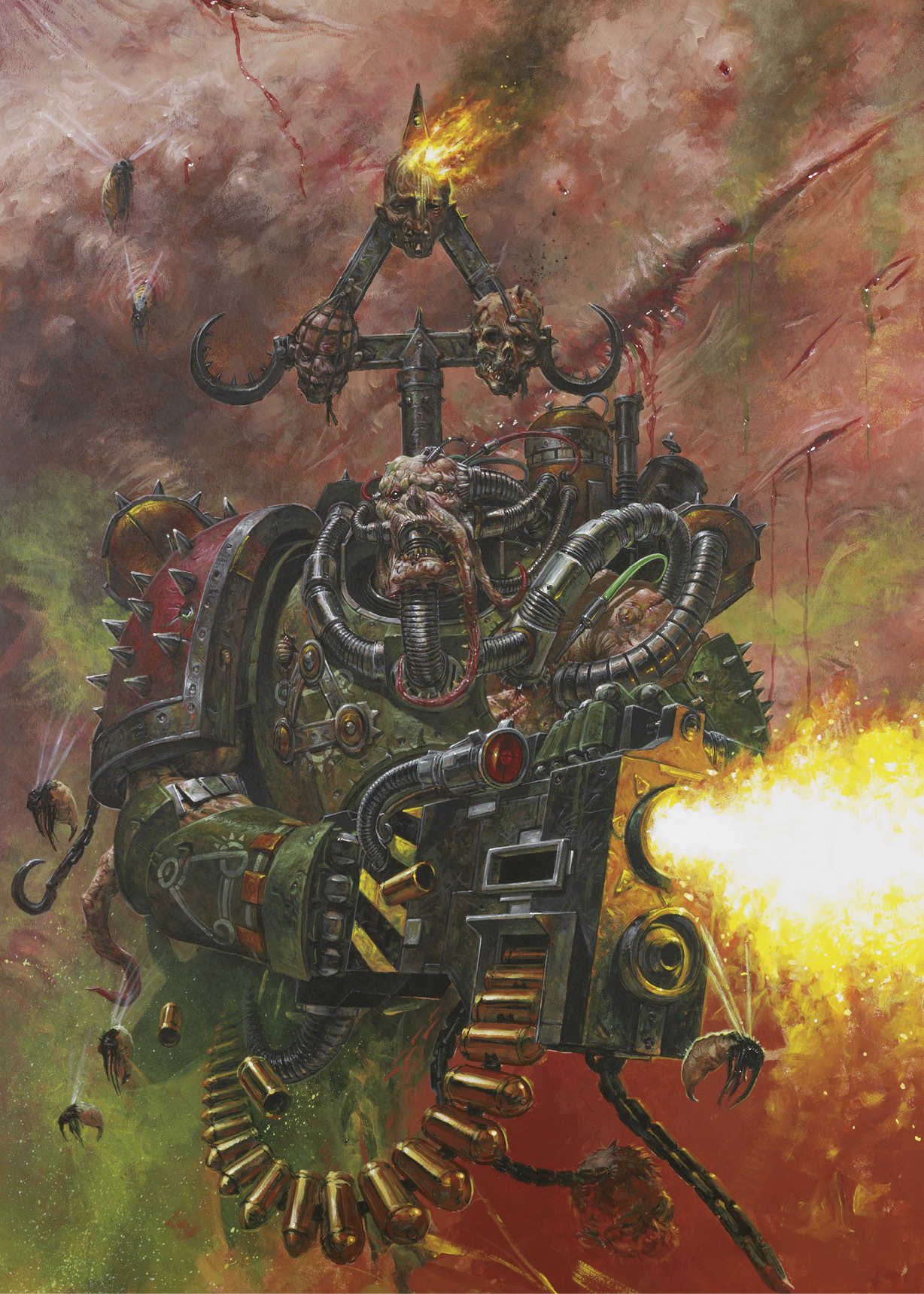
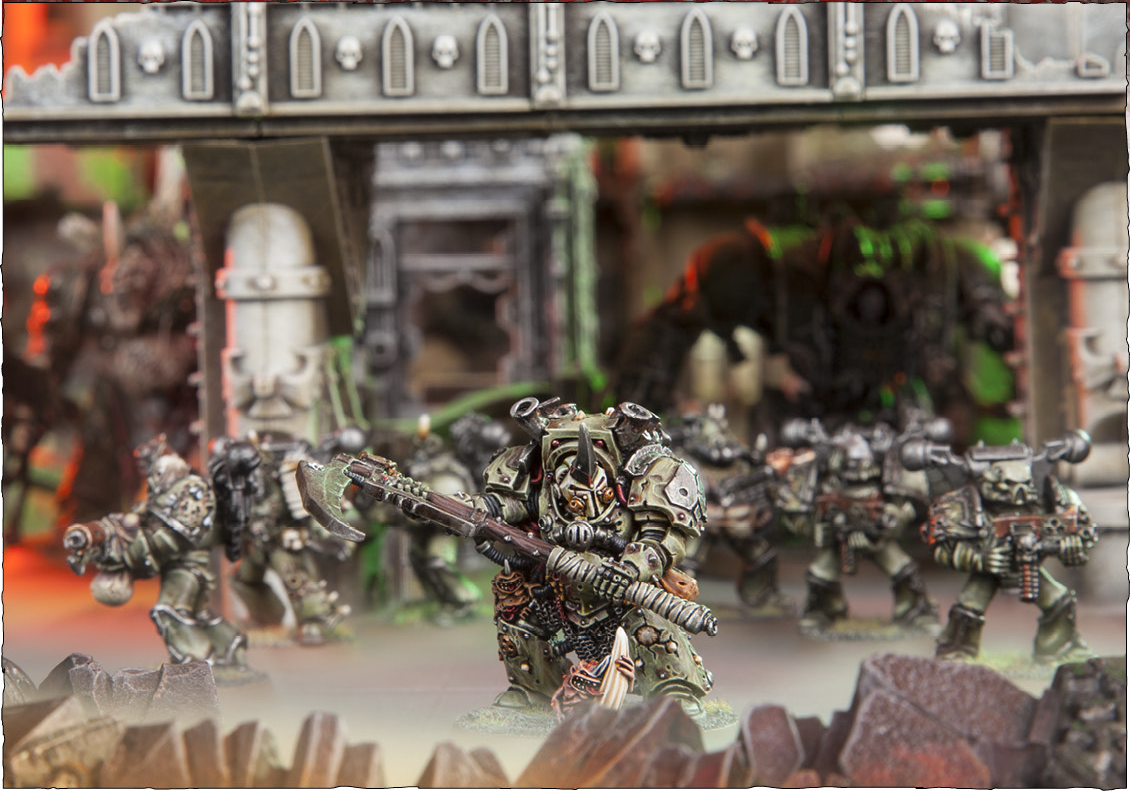
The Death Guard bring the supernatural diseases of Nurgle to the material universe. Tough and relentless, they are impervious to pain.
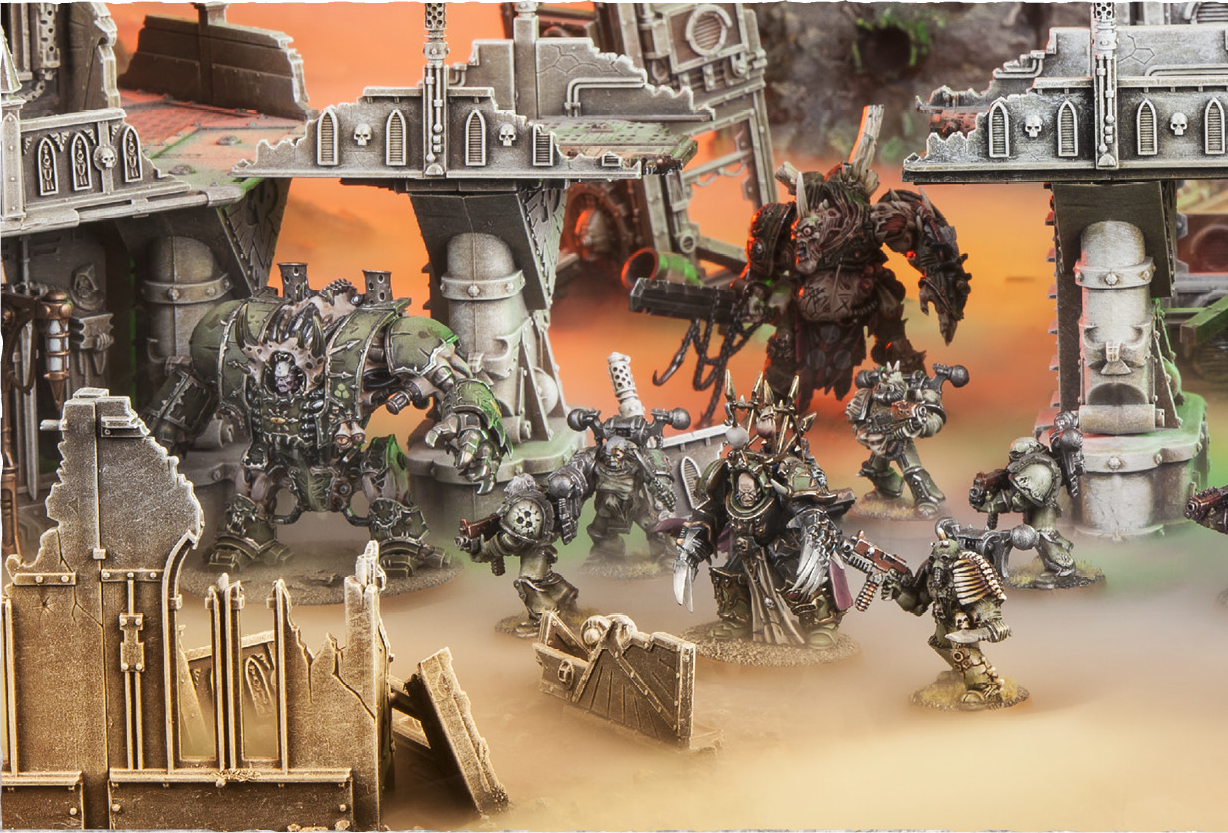
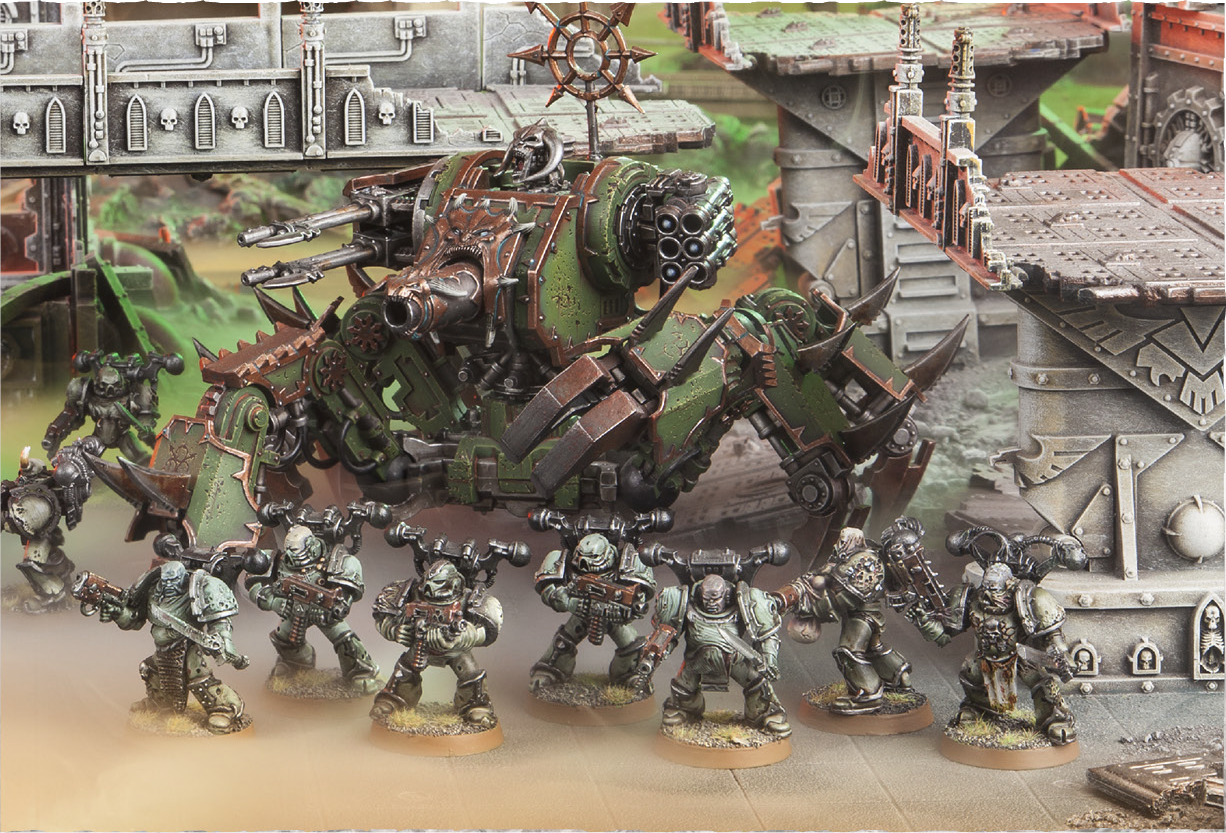
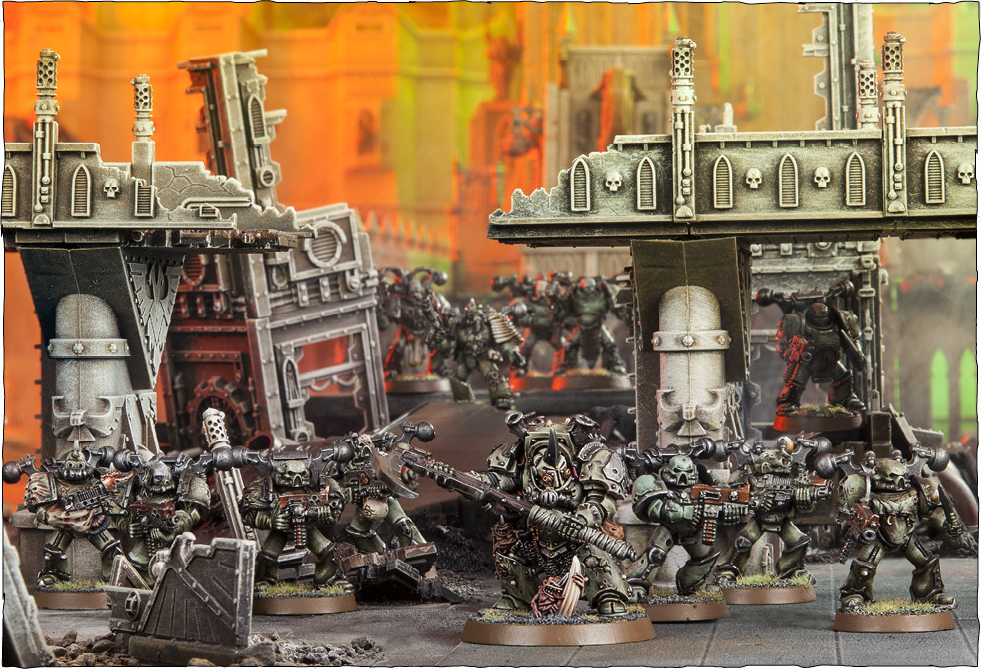
Warbands of Plague Marines are often found organised in squads of seven, banded together into groups of seven squads. An echo of the Death Guard Legion's organisational model at its height, seven is also the sacred number of the Legion's patron power, and they believe that by forming themselves in multiples of that number they carry the favour of the Chaos God Nurgle. Whether this organisation draws the attention and sorcerous blessing of the Plague God or not, the manner in which the Plague Marines carry themselves to war still reflects the hand of Mortarion, the grim Primarch who forged them, shaped them, then led them to their damnation. The Plague Marines revel in the contamination of Imperial worlds, sowing pestilence and contagion wherever they go and inflicting cruel and agonising deaths on a planetary scale.
Formation
- 1 Chaos Lord or Typhus
- 3-7 units of Plague Marines
Restrictions
This is a Death Guard Detachment (see pg 116).
Special Rules
Enervating Pestilential Aura: Enemy models within 7" of any Plague Colony units at the start of the Fight sub-phase must reduce their Initiative and Weapon Skill by 1 for the duration of the phase. If this Formation includes the maximum number of units at the start of the battle, then enemy models within 7" of any Plague Colony unit at the start of the Fight sub-phase must also reduce their Toughness by 1 for the duration of the phase.
On these pages, you will find special rules unique to armies from the Death Guard that reflect their tactics on the battlefield. You will also find Warlord Traits, Chaos Artefacts and Tactical Objectives that you can use when fielding your Death Guard army in games of Warhammer 40,000, and an exclusive Detachment - the Vectorium.
Death Guard Special Rules
Any Detachment with the Chaos Space Marines Faction can be from one of the nine Traitor Legions. A Death Guard Detachment retains the Chaos Space Marines Faction and is treated in all ways as a Chaos Space Marines Detachment, with the following modifications:
- They cannot include any Unique units other than Typhus.
- Units that can take the Mark of Nurgle must do so.
- Units with a Mark of Chaos other than the Mark of Nurgle cannot be taken.
- All units that can do so must be upgraded to Veterans of the Long War, at no additional points cost.
- Any Daemon Princes must have the Daemon of Nurgle special rule.
- Psykers from the Detachment can choose to generate all of their psychic powers from the Discipline of Nurgle.
All units in a Death Guard Detachment or Formation gain the following special rules:
Gifts of Nurgle
Units that have the Veterans of the Long War special rule have the Fearless and Feel No Pain special rules, but reduce their Initiative characteristic by 1. Typhus and units of Plague Marines are unaffected.
Inexorable Advance
Units that have the Veterans of the Long War special rule have the Relentless special rule.
Lords of the Plague Host
Units of Plague Marines are Troops choices instead of Elites choices.
Chaos Artefacts
Units in a Death Guard Detachment or Formation that can normally take Chaos Artefacts in Codex: Chaos Space Marines can choose to take items from the Chaos Artefacts of the Death Guard list (see opposite) at the points cost shown instead.
Warord Traits
When generating his Warlord Traits, a Warlord from a Death Guard Detachment or Formation may choose to roll on the table to the right instead of those found in Warhammer 40,000: The Rules or Codex: Chaos Space Marines.
Warlord Traits Table
| D6 | Warlord Trait |
|---|
| 1 | Insensate to Pain: So vast and bloated has this Warlord become that he is all but immune to the pain of injury.
Add 1 to your Warlord's Feel No Pain rolls. |
| 2 | Tainted Regeneration: So blessed is this Warlord with Nurgle's foetid restorative powers that his body heals itself as fast as his enemies can harm him.
Your Warlord has the It Will Not Die special rule. |
| 3 | Lord of Contagion: Saturated as he is with Nurgle's contagious blessings, merely to stand before this Warlord and his closest warriors is to be assailed by an oppressive aura of plague.
Your Warlord and all friendly units from a Death Guard Formation or Detachment that are within 7" of your Warlord at the start of the Fight sub-phase are infected with a contagious plague until the end of the phase. All enemy units that are locked in combat with any units infected in this manner suffer D6 Strength 1 AP 4 hits with the Poisoned (4+) special rule (distributed randomly) at the Initiative 10 step. |
| 4 | Hulking Physique: This Warlord's body has become swollen with Nurgle's divine blessings, and stands all but inviolate as a veritable behemoth of rancid flesh.
Add 1 to your Warlord's Wounds characteristic. |
| 5 | Rotten Constitution: Nurgle's favour takes many forms, and this Warlord's flesh has become so rot-infested that vast chunks of it can be torn free without risk of lasting harm.
Your Warlord has the Eternal Warrior special rule. |
| 6 | Arch-contaminator: Such are this Warlord's virulent emanations that his very presence is enough to make even the most lethal toxins and venoms deadlier still.
The effect of the Poisoned special rule on any weapons wielded by your Warlord and any models in his unit is improved by 1, to a maximum of 2+. For example, if your Warlord joined a unit of Plague Marines, their plague knives would have the Poisoned (3+) special rule instead of Poisoned (4+). |
Nurgle's putrescent blessing hangs heavy in the air about the Death Guard's most sacred relics, and proximity alone is often enough to infect those who breathe deep of their noxious foulness. Only one of each of the following items may be chosen per army, and only one may be chosen per model.
Puscleaver — 10 Points
Appearing as a particularly large plague knife, more like a machete than the traditional side weapon of the Death Guard Legion, the Puscleaver bears the infamous Gurgling Doom contagion. One struck by the blade has not only to contend with part of their anatomy being hacked away, for its edge remains punishingly sharp, but also a wound so infected balloons into a swollen mess in seconds. The afflicted individual keels over a moment later, gurgling phlegm as he finally realises the glory of Nurgle's generosity.
Replaces one of the bearer's Melee weapons.
| Range | S | AP | Type |
|---|
| - | User | - | Melee, Poisoned (2+) |
Plague Skull of Glothila — 15 Points
This oversized death's head was once the skull of the Chaos Lord Glothila, whose dying wish was to become a weapon of purest evil.
Once per game, instead of firing his weapon, the bearer of the Plague Skull of Glothila can choose to make a shooting attack that uses the profile below:
| Range | S | AP | Type |
|---|
| 8" | 1 | - | Assault 1, Large Blast, One Use Only, Poisoned (2+) |
The Pandemic Staff — 30 Points
This rune-engraved artefact is long and pitted, mouldering with a visible miasma of plague and entropy. Every one of its odd dents and holes harbours a deadly strain of contagion, one of Nurgle's old favourites, tried and proven. Collectively, the grotesque diseases that riddle the Pandemic Staff have seen trillions of lives ebb away to nothing, reduced to little more than fodder for the Grandfather's Garden. When waved expansively, the staff can conjure forth a tide of hypertoxic fluids that could bring low even a rampaging pestigor.
Replaces one of the bearer's Melee weapons. The bearer can also use the Pandemic Staff in the Shooting phase instead of firing another weapon.
| | Range | S | AP | Type |
|---|
| Ranged | Template | 1 | 5 | Assault 1, Poisoned (2+) |
| Melee | - | +2 | 4 | Melee, Concussive, Poisoned (2+) |
Dolorous Knell — 25 Points
The clangour of this giant bell is painful to the ear, almost intrusive as its foul sounds push their sickening notes into the minds of those nearby. Each toll registers as a dull clank on the data-harvest of recording devices such as vid-thief skulls, but to hear it in person is quite another matter. Bravery is undone and certainty ebbed away as the shambling horde of the Death Guard closes in, rendered as looming behemoths by the peals of the deathly knell.
All friendly Death Guard units within 14" of the bearer at the start of the Fight sub-phase have the Fear special rule for the duration of the phase. In addition, enemy units taking a Fear test against an affected unit must do so on 3D6 instead of 2D6.
Poxwalker Hive — 20 Points
Daemon insects spill from the tubular, chimney-like structures of the Poxwalker Hive. The incessant droning chatter of these tiny creatures acts as an infection in its own right, and those who willingly listen to it are at grave risk of contracting the poxwalker's curse. Should they succumb, they will devolve into shambling, mutant monstrosities, murmuring and babbling in the same flyblown tongue as the hive itself.
At the start of each of your turns, pick a friendly unit of Chaos Cultists within 7" to infect with the poxwalker virus. For the rest of the game, that unit of Chaos Cultists cannot Run or make shooting attacks, but they gain the Fearless and Feel No Pain special rules. In addition, at the start of each of your following turns, return D3 slain models to every friendly unit of infected Chaos Cultists that are within 7" of the bearer. Any models returned in this manner that cannot be placed within unit coherency are lost.
Plaguebringer — 35 Points
The hooked blade Plaguebringer once bore the souls of a trio of Beasts of Nurgle. Once the sword sprayed the virulent, infected spittle of these overexcitable Daemons with every swing. However, those entities were trapped so long in the rusted artefact's confines that their lethally potent enthusiasm has drained away, replaced with something even worse. After a long period of sulking, the blade's inhabitants became something else entirely; it now contains the malignant souls of three Rot Flies that take every chance to inflict a terrible wasting disease on those around them.
Replaces one of the bearer's Melee weapons.
| Range | S | AP | Type |
|---|
| - | User | 3 | Melee, Daemon Weapon*, Poisoned (4+) |
*See Codex: Chaos Space Marines.
Vectoriums are used exclusively by the forces of the Death Guard. The rules below will allow you to organise the models in your Chaos Space Marines collection of miniatures to represent one of these Detachments in your games of Warhammer 40,000.
Choosing an Army
When choosing an army to play a game of Warhammer 40,000, there are two main ways of organising your collection. These are the Unbound method, which means taking whichever units you like, and the Battle-forged method, which is more rigid but has extra benefits. Both are described fully in Warhammer 40,000: The Rules.
If you are using the Unbound method, simply use the datasheets that correspond to the models in your collection. If you are using the Battle-forged method, you will instead need to organise the models in your collection into Detachments. This is a fun process in its own right. The most common of these are the Combined Arms and Allied Detachments.
A Vectorium is a special type of Detachment that can be included in any Battle-forged army. Unlike the Detachments shown in Warhammer 40,000: The Rules, it has a Force Organisation Chart whose slots are a combination of specific Formations and Army List Entries instead of Battlefield Roles. However, it still has compulsory and optional elements, as well as Restrictions and Command Benefits, just like any other Detachment.
Although units cannot normally belong to more than one Detachment, units from a Formation that is part of a Vectorium are an exception. They count as part of both their Formation and the Detachment, and have all associated Command Benefits and special rules. If your Warlord is part of a Formation or an Army List Entry that makes up part of a Vectorium, the entire Vectorium is your Primary Detachment.
Death Guard Vectorium
The Vectorium allows you to represent the typical structure of a Death Guard army on the battlefield. Whether you wish to bring death and destruction with the full might of a Chaos invasion force, or field an elite warband tasked with some dark purpose, the choices below offer a great way to pick your army.
For example, Erik's Chaos Space Marines collection consists of Typhus, a Chaos Lord, a Dark Apostle, a Daemon Prince, four units of Plague Marines, two units each of Chaos Space Marines, Chaos Terminators and Chaos Cultists, one unit each of Raptors and Chosen, a Helbrute, two Heldrakes, a Defiler and two Maulerfiends.
If Erik wishes to organise his collection using the Battle-forged method - as described in Warhammer 40,000: The Rules - all of his units need to be part of a Detachment or a Formation. Erik achieves this by choosing one Vectorium and one Combined Arms Detachment from Warhammer 40,000: The Rules.
The Vectorium in Erik's army consists of two Core choices - a Plague Colony (Typhus and the Plague Marines) and a Chaos Warband (his Chaos Lord, Chosen, Chaos Terminators, Chaos Space Marines, Raptors and Helbrute) - and a Heldrake Terror Pack (his pair of Heldrakes) as an Auxiliary choice.
Erik's Dark Apostle, Daemon Prince, Chaos Cultists, two Maulerfiends and Defiler form a Combined Arms Detachment. As all of his units belong to a Detachment, the army is Battle-forged. Erik chooses Typhus to be his Warlord - his Vectorium is therefore his Primary Detachment. The units that are part of it have the Plague Lord, Disgustingly Resilient and Cloud of Flies Command Benefits, whilst those that are part of the Combined Arms Detachment have the Objective Secured Command Benefit.
Restrictions:
This Detachment must include at least one Core choice and one Auxiliary choice. It may include up to four Command choices and any number of additional Core or Auxiliary choices, in any combination. Only the datasheets listed here can be included in this Detachment and all units must have the Chaos Space Marines Faction.
Command Benefits:
Plague Lord: If this Detachment is your Primary Detachment, you can re-roll the result when rolling on the Death Guard Warlord Traits table (pg 116).
Disgustingly Resilient: Units from this Detachment can re-roll Feel No Pain rolls of 1.
Cloud of Flies: If an enemy unit targets a unit from this Detachment that is 18" or more away, the target unit has the Stealth special rule while that attack is resolved.
| Core | Chaos Warband | (pg 46) |
| Core | Plague Colony | (pg 70) |
| Command | Lord of the Legion | 1 of the following:- Chaos Lord
- Sorcerer
- Dark Apostle
- Daemon Prince
|
| Auxiliary | The Lost and the Damned | (pg 48) |
| Auxiliary | Helforged Warpack | (pg 49) |
| Auxiliary | Heldrake Terror Pack | (pg 50) |
| Auxiliary | Cult of Destruction | (pg 51) |
| Auxiliary | Fist of the Gods | (pg 52) |
| Auxiliary | Raptor Talon | (pg 53) |
| Auxiliary | Terminator Annihilation Force | (pg 54) |
| Auxiliary | Favoured of Chaos | (pg 55) |
| Auxiliary | Spawn | 1-3 units of Chaos Spawn |
Command 0-4, Auxiliary 1+, Core 1+
Presented below are six Tactical Objectives to use in your games of Warhammer 40,000, which are exclusive to Death Guard players and reflect the foetid and utterly relentless nature of the Death Guard in battle.
Tactical Objectives
If your Warlord is from a Death Guard Detachment or Formation, you may replace the Capture & Control Tactical Objectives (numbers 11-16) described in Warhammer 40,000: The Rules with the Tactical Objectives on this page.
If a Warhammer 40,000 mission has the Tactical Objectives special rule, players use the normal rules for using Tactical Objectives with the following exception: when a Death Guard player using these Tactical Objectives generates a Capture & Control objective (numbers 11, 12, 13, 14, 15 or 16), they instead generate the corresponding Death Guard Tactical Objective, as shown in the table. Other Tactical Objectives (numbers 21-66) are generated normally.
| D66 | Result |
|---|
| 11 | Death March |
| 12 | Pain is for the Weak |
| 13 | Nurgle's Gift |
| 14 | Spread Plague and Contagion |
| 15 | Symbol of the Fly-Lord |
| 16 | Death Begets Life |
11: Death March
Type: Death Guard
The slow, inexorable advance of the Death Guard has been the death knell of worlds beyond count.
Score 1 Victory Point at the end of your turn if at least 3 of your units are within your opponent's table half.
12: Pain is for the Weak
Type: Death Guard
Nurgle despises physical frailty and blesses his followers with bloated bodies filled with decay that they may forever forgo its touch.
This Tactical Objective is achieved if you make at least 7 Feel No Pain rolls in any single phase. You immediately score 1 Victory Point.
13: Nurgle's Gift
Type: Death Guard
Nurgle enjoys little more than watching his followers spread his diseases upon the mortal races.
Score 1 Victory Point at the end of your turn if at least one enemy unit was completely destroyed by a weapon or psychic power that had the Poisoned special rule during that turn.
14: Spread Plague and Contagion
Type: Death Guard
The lords of the Death Guard have survived for countless centuries, enduring to spread disease to every world they invade.
When this Tactical Objective is generated, nominate one of your Death Guard characters. Score 1 Victory Point at the end of the game if this character is still alive and on the table.
15: Symbol of the Fly-Lord
Type: Death Guard
The symbolism of the three-eyed fly holds great meaning to the worshippers of the Plague God.
Score D3 Victory Points at the end of your turn if you control exactly three Objective Markers - no more, no less.
16: Death Begets Life
Type: Death Guard
To the followers of Nurgle, the endless cycle of sowing death that new life may bloom is nothing less than a sacred act.
Score 1 Victory Point at the end of your turn if at least 7 enemy models were slain during your turn. If at least 14 enemy models were slain during your turn, score D3 Victory Points instead, and score D3+3 Victory Points if at least 21 enemy models were slain during your turn.
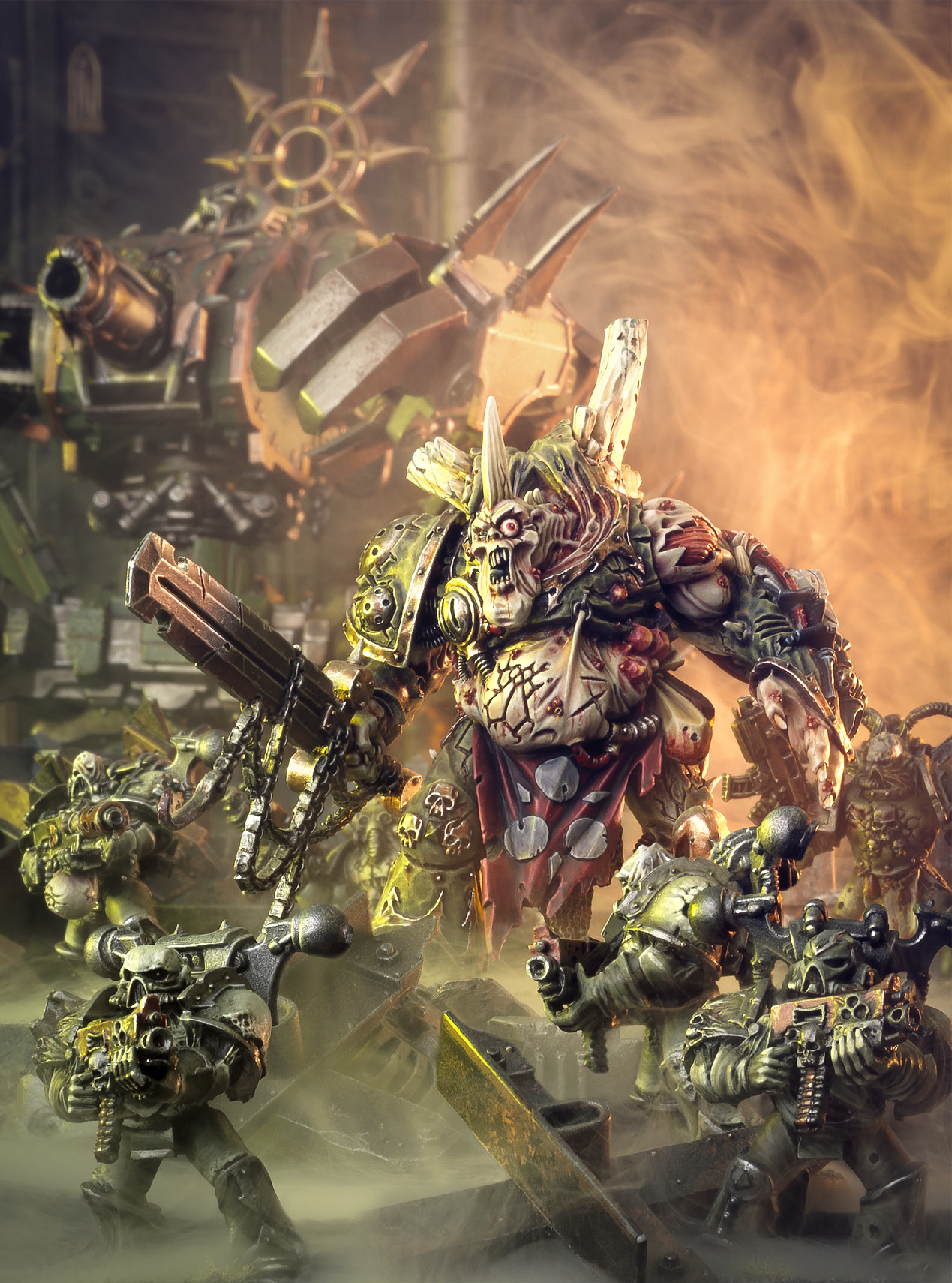
Warhammer 40,000 (2017)
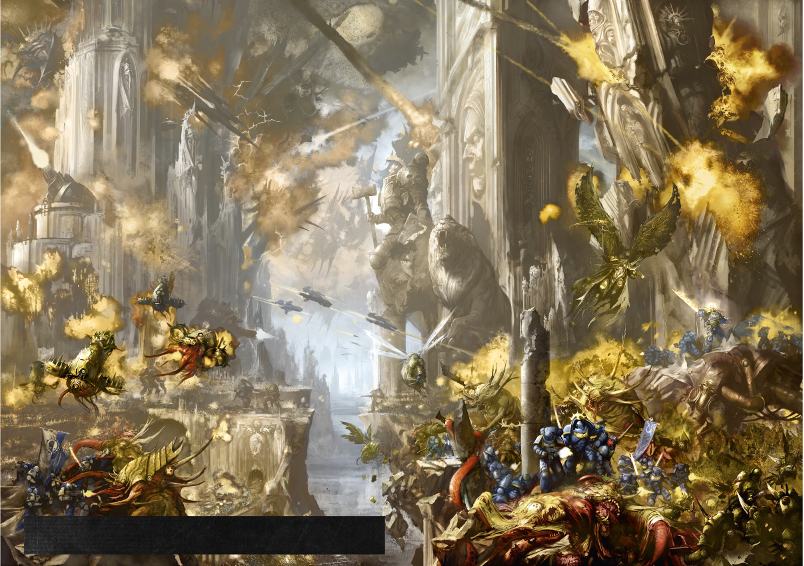
I see a rising deluge of violence drowning Humanity's worlds. Like the sea crashing upon the cliffs, it grinds and crushes with every surge. Entropy. Cruelty. Lunacy and hatred. These are the weapons of the Enemy. The tides of Chaos have toppled civilisations, bringing them from supremacy to the brink of annihilation. Blindly does Mankind make that same journey, now standing on the edge of the abyss.
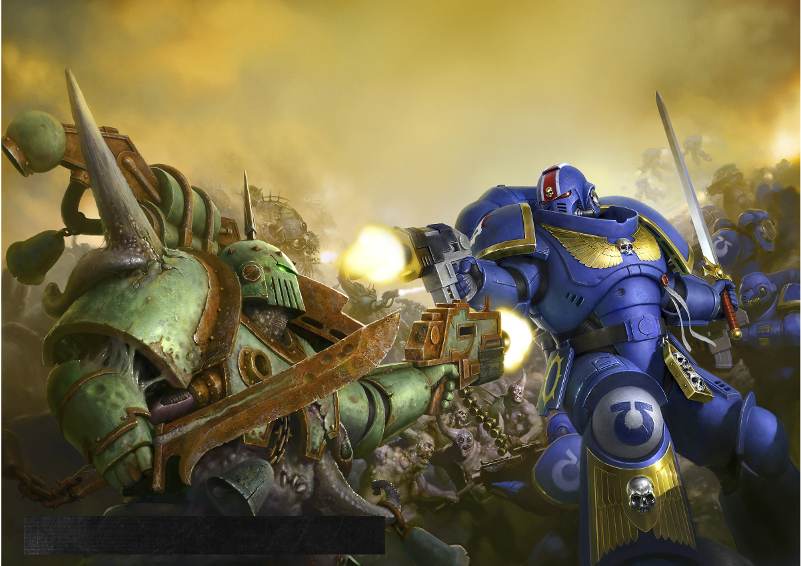
I see war unbound raging across the cosmos, a black fire that consumes a million worlds. Every imaginable conflict is made manifest, and the valorous bleed and die anew each day. But beneath this battle of darkness and light there is a truth that sears the mind. The Enemy, nemesis of all, comes not from without. Our most cursed foes are the shadows of our souls made real, and they would see the galaxy burn.
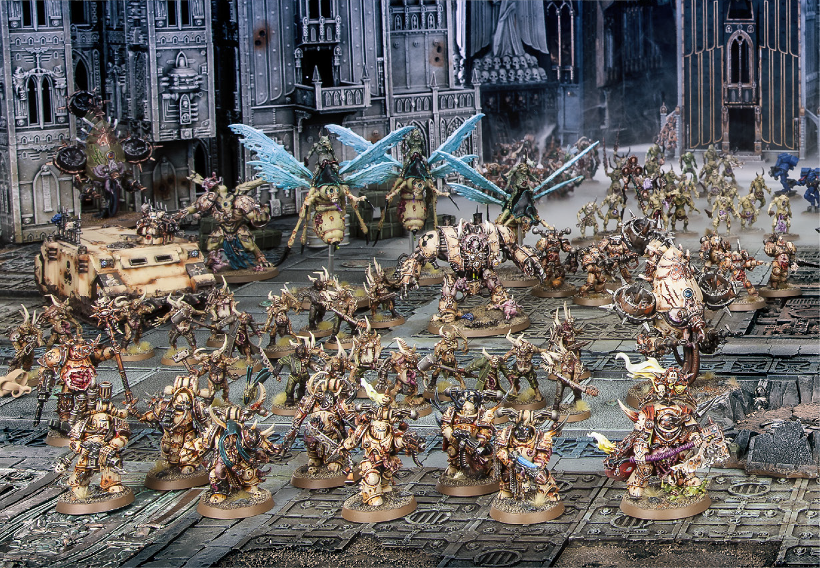
Something terrible came out of the warp storms as they roiled through the southern reaches of Ultima Segmentum. Where the seeds of corruption had been planted by the Plague That Walks, a new and terrible contamination spread. The diseased dead rose to claim the living. Previously, the walking corpses could be destroyed, but now doing so only released hordes of Nurglings that writhed impossibly out of the withered flesh of the fallen. Hive worlds were toppled, and as the Blackness descended, there was no escape. In the horrific ruins, Cults of Corruption slithered out of hiding, summoning forth further aid from the Realm of Chaos itself.
So did systems fall, creating the Scourge Stars - a trio of sickly systems that had fallen to Nurgle. From that power base, the Death Guard and Plague legions issued, systematically reaping planet after planet. On they spread. It was none other than the Daemon Primarch Mortarion that brought the fabled Realm of Ultramar, gem of the whole segmentum, under siege. Plague bombardments rained down, so severe that once gloried hives became pits and agri worlds became slime-ridden ruins. Chaos was encroaching on many fronts when Roboute Guilliman returned. It was his tactical acumen that first stabilised the many war fronts, and his Spear of Espandor counter-attacking campaign that successfully bought the forces of the Imperium still more time. At the Gates of Parmenio, Roboute Guilliman defeated the Greater Daemon Septicus and his Plague Guard. At Iax, once a glorious garden world, Primarch met Primarch as Guilliman confronted Mortarion, the two brothers fighting to a deadlock before the Chaos forces mysteriously withdrew under cover of a virus bomb.
The Death Guard were one of the original Legions, but with lies and half-truths Horus swayed their Primarch, Mortarion, to his rebellion. The Death Guard would pay a nightmarish price for that betrayal, falling under the sway of Nurgle, the Lord of Corruption, to become the first of all the Plague Marines.
Few sights are more loathsome than the corrupted forms of the plague-infested Death Guard. Their oozing power armour has rotted away in places, exposing festering wounds and pestilence-filled innards - yet their bloated bodies do not feel the agony of their mutations. If anything, these afflictions only make them stronger, their necrotic bodies so numb to pain that only total destruction can stop them. Relentlessly they march forward.
Abominations against nature, the Death Guard advance within clouds of flies, their weapons spitting death, their miasma spreading unnatural disease. Truly, Nurgle has blessed the Death Guard - their flesh bulging with corruption - and they wish to share these gifts of virulence across the galaxy.
For a long period after his ascension to daemonhood, the Traitor Primarch Mortarion allowed his Death Guard to fractionalise. He was content to rule from his throne upon the Plague Planet - a Daemon world inside the Eye of Terror - only rarely issuing forth. In the wake of the Noctis Aeterna, however, Mortarion has taken a more direct role in leading the Death Guard. The time for the planting of corruptions had ended, and the time for reaping has begun.
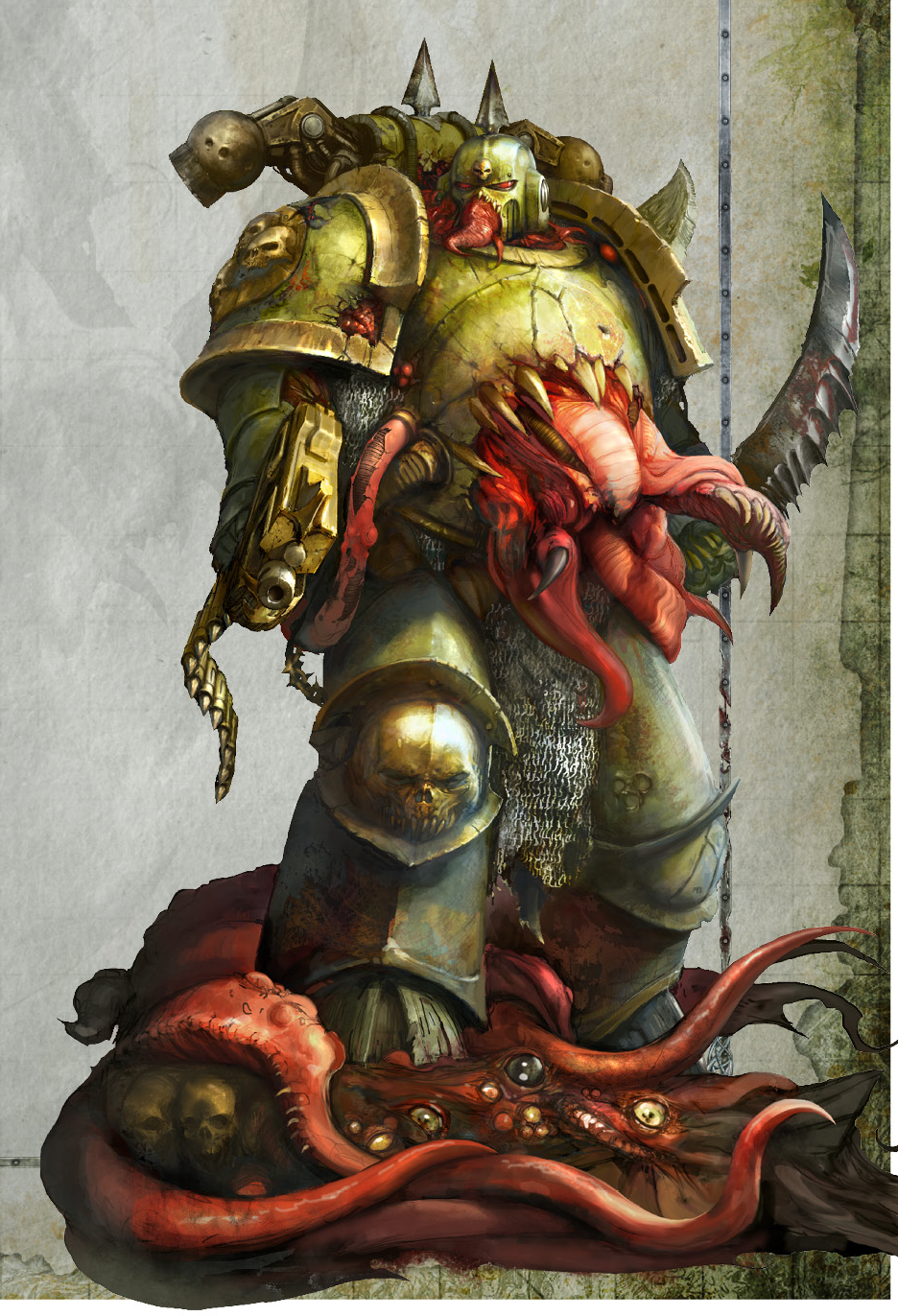
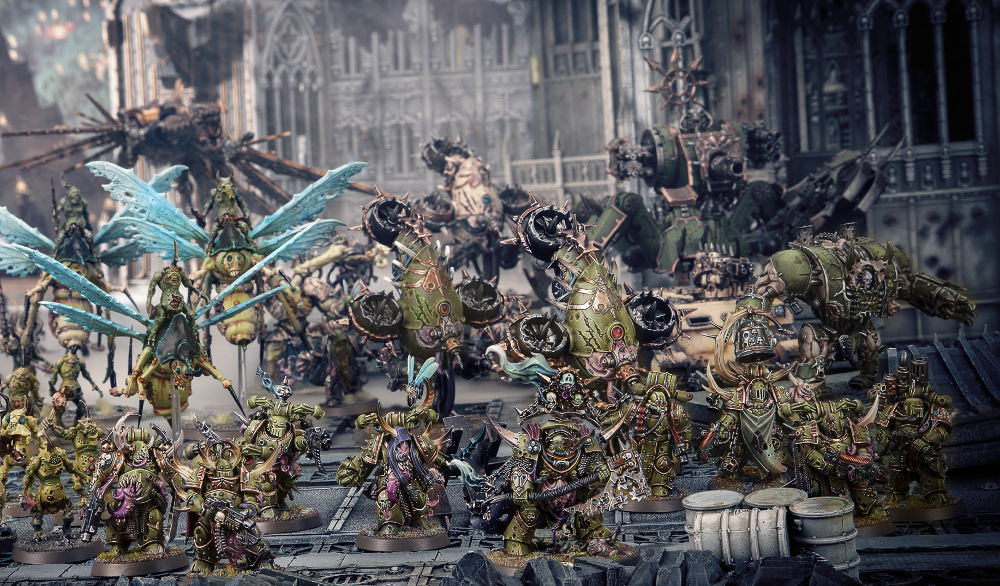
Amongst a stinking miasma of infectious gases, the legions of Nurgle advance with slow but unstoppable momentum. The air fills with the drone of bloated flies and chanting Plaguebearers, their vile chorus punctuated by the crash and roar of gunfire.
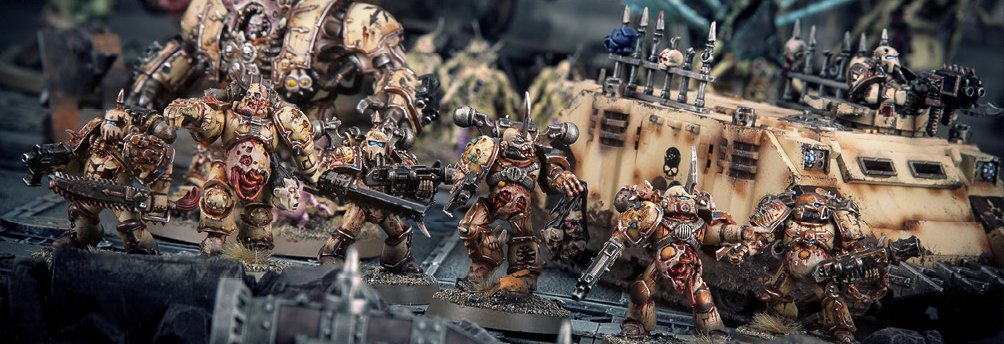
Plague Marines bring to their victims the foetid gifts of Grandfather Nurgle - amongst them disease, despair, and boundless entropy.
Greedy eyes looked out from the roiling warp. They lingered long over the southern reaches of Ultima Segmentum. Nurgle wanted them for his own. He wished to lavish his gifts upon them, to watch their citizens sprout new growths and lament while other parts rotted and sloughed off.
The worlds of Ultramar were prosperous, well governed and aesthetically beautiful. It is no wonder that such a gem drew the eager eye of Nurgle. Wishing to annex those worlds directly into his own Garden in the Realm of Chaos, the Father of Plagues set his minions to the task. After the Great Rift tore reality and flooded warp energies into the galaxy, Nurgle deemed the time was ripe. Where seeds of corruption had been planted, where the Plague That Walks, the Oozing Pox, and the Eyerot had decimated overcrowded hive worlds, there did Nurgle put forth his greatest efforts. As darkness closed over those worlds, new, virulent strains of those dreadful diseases started the cycle of death anew. This time, however, the cycle was completed, for there was life also. From the corpses of the fallen burst countless Nurglings. In the devastation that ensued, Cults of Corruption summoned further aid. The following battles - known by the Imperium as the Plague Wars - ended when three systems to the galactic north of Ultramar were corrupted and turned into the Scourge Stars. Calling upon three of his greatest commanders, Nurgle tasked them with next conquering Ultramar.
Ultramar Invaded
The first invaders to issue forth from the Scourge Stars were the Death Guard, led by their grim Primarch, Mortarion. His meticulously planned seven-part campaign would bring untold ruination to all of Ultramar. So began the first part the War of Flies including the assault of the Three Planets, the besieging of the hive world of Ardium, and the Creeping Doom offensive against Espandor and Drohl. Virus bombardments preceded the Death Guard. Once-gloried hive cities became pits, and agri worlds became flyblown wastes. The attacks were slow but relentless, wearing down the Ultramarines and their auxilia. With communications severed and relief forces cut off by fresh warp storms, the defenders were hard-pressed in a hundred locations across Ultramar. Then, Roboute Guilliman returned from his galaxy-spanning crusade. Tactically, Mortarion and his fellow commanders now found themselves evenly matched, their offensives blocked at every turn by the Ultramarines and their Primarch's precise counter-attacks. A new stage of the war had begun.
Macragge
In the early stages of the invasion of Ultramar, many different strikes were levelled at the capital world of Macragge. Whether Mortarion planned these events to probe the defences of the Ultramarines' home world, or merely aimed to tie down as many of the Imperial forces as he could, is unknown. All of the battles were short, sharp affairs, such as rapid strikes from Plague Drone forces, or cultist attacks attempting to deliver pox bombs into the heavily guarded defence networks. Whatever Mortarion's intent, the number and variety of the attacks steadily drained both morale and resources from Macragge until Primarch Guilliman returned and seized the initiative with his own strikes into Chaos-held territories.
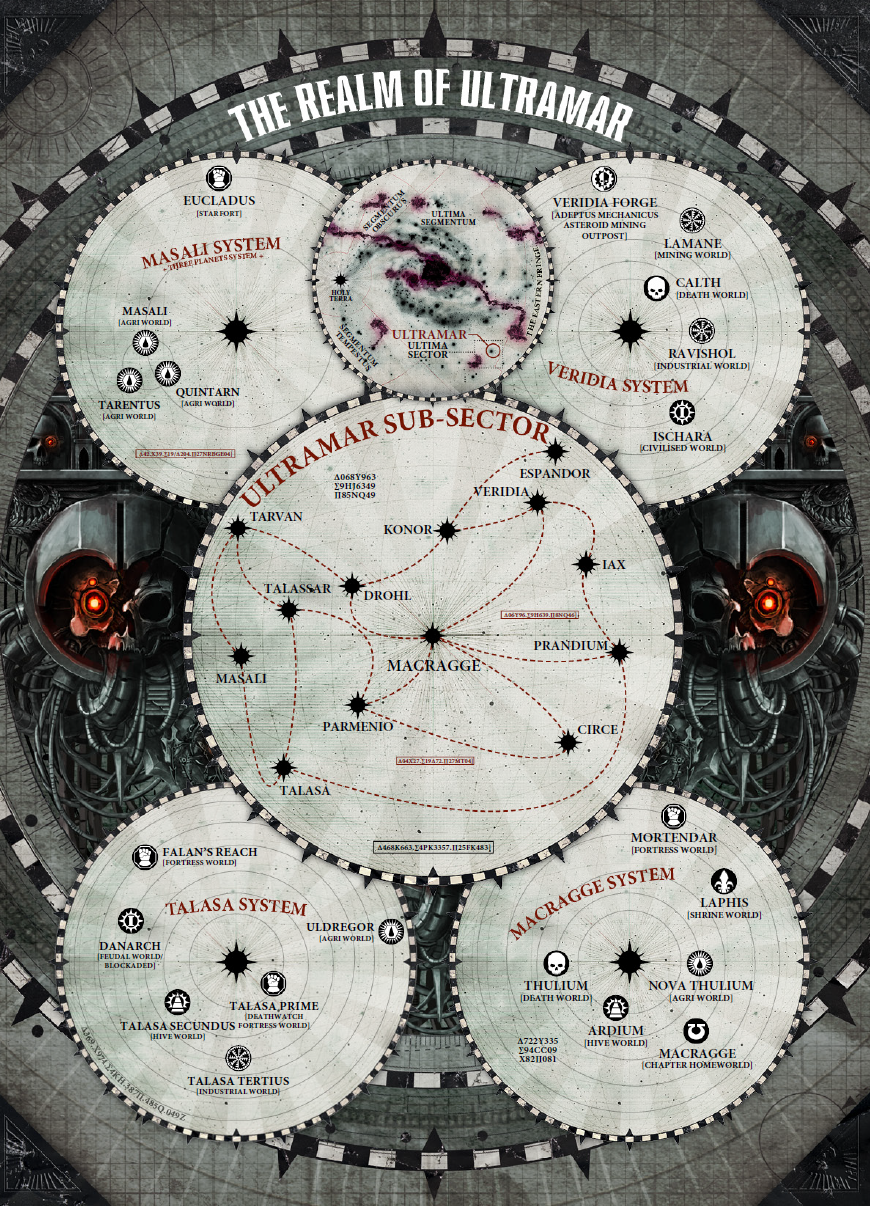
The March of Plagues
In attacking Ultramar, Mortarion was not alone. Two other commanders led massive armies out from the Scourge Stars, each seeking to win the contaminated glory of Nurgle's favour.
Ku'gath Plaguefather, a favoured Great Unclean One, led the Bubonicus legions into Ultramar. Typhus, First Captain of the Death Guard, commanded a Plague Fleet, a dilapidated rot-armada packed with Renegades, cultists and his own loyal Death Guard. Ku'gath's Daemon legions ravaged the Tartella System, which lay between the Scourge Stars and Ultramar, before manifesting on the garden world of Iax, an ideal place to nurture new diseases. The Plague Fleet, meanwhile, destroyed three of the six massive star fortresses that stood sentinel over Ultramar's shipping lanes. Even with Guilliman's return, the attacks were too many and too widespread for the defenders to contain. The timely arrival of the Ultramarines' successor Chapters, however, along with reinforcements from several forge worlds, allowed the Primarch to attempt to regain the initiative. Guilliman launched the Spear of Espandor counter-attack, hoping to buy the forces of the Imperium more time.
Deadlocked
Across Ultramar, the Plague Wars escalated. Guilliman's brilliant counter-attacks staved off defeat, allowing him to stabilise fronts across several systems. The largest battles of the war, however, were still to come.
With Mortarion's Creeping Doom offensive mired in continent-spanning trench warfare in the Espandor System, the Daemon Primarch shifted his focus, joining forces with Ku'gath. Together, they sent their surviving forces to Parmenio and Iax simultaneously. On Parmenio, the largest armour and Titan battle of the war took place over the shell-ridden Plains of Hecatone. At the battle's height, Roboute Guilliman struck against Ku'gath's vanguard, slaying his lieutenant, Septicus, and shattering his Plague Guard. In space, Galatan - Ultramar's largest star fortress - attempted to provide support but was boarded by the Plague Fleet. Massive casualties ensued, including the loss of the Novamarines' Chapter Master. The Ultramarines and their auxilia made gains on Parmenio, and Guilliman led a relief force to Iax. Once a verdant garden world, it was in ruins when Primarch met Primarch. Guilliman confronted Mortarion, fighting to a deadlock before the Death Guard withdrew under cover of a virus bomb.
Forces of the Imperium
The defence of Ultramar was really a tale of three parts: the initial losses, where the defenders gave ground before the Death Guard onslaught; the stabilisation with the return of Primarch Guilliman; and finally, the seizing of the initiative with the Primarch's counter-attacks along with the final battle.
Defenders of Ultramar
Spear of Espandor
- Ultramarines — 7 Companies
- Genesis Chapter — 6 Companies
- Aurora Chapter — 5 Companies
- Silver Eagles — 5 Companies
- Sons of Orar — 3 Companies
- Mortifactors — 3 Companies
- Knights Cerulean — 3 Companies
- Varied Astartes Chapters* — 14 Companies
- Ultramar Auxilia — 9 Regiments
- Order of the Valorous Heart — 2 Preceptories
- Grey Knights — Unknown
- Sisters of Silence — Unknown
*Many Chapters arrived to lend aid to Ultramar and to fight beneath Roboute Guilliman. The Primarch and Lord Commander of the Imperium organised those Adeptus Astartes in less-than-company numbers into battle-brother battalions, using them for special missions and to shore up the Ultramar Auxilia.
The Plains of Hecatone
- Varied Astra Militarum — 18 Regiments
- Ultramar Auxilia — 21 Regiments
- Ultramar Super-heavy Armour — 3 Regiments
- Ultramarines — 3 Companies
- Ultramarines Neophytes — Unknown
- White Scars — 3 Companies
- Legio Oberon — Demi-Legion
- Legio Atarus — Demi-Legion
- Legio Fortis — Demi-Legion
- House Terryn — 3 Households
- House Hawkshroud — 2 Households
- House Konor — 2 Households
- Legio Cybernetica — 3 Cohorts
- Skitarii — 5 Legions
Defence of Gatalan
- Novamarines — 5 Companies
- Ultramar Auxilia — 12 Regiments
- Deathwatch — 21 Kill Teams
- Grey Knights — Unknown
Battle of First Landing
- Roboute Guilliman — Primarch
- Ultramarines — 8 Companies
- Novamarines — 3 Companies
- Silver Eagles — 3 Companies
- Howling Griffons — 6 Companies
- Libators — 2 Companies
- Ultramar Auxilia — 21 Regiments
- Astra Militarum — 15 Regiments
- Legio Praetor — Demi-Legion
- Skitarii — 5 Legions
Let them flee beneath cover of their virus bomb. By the Emperor, they shall be repaid tenfold for the evils they have wrought upon Ultramar.
— Roboute Guilliman
Forces of Chaos
The invasion of Ultramar began as separate spearheads, but as the campaigns slowed, Mortarion and Ku'gath formed an alliance. Unlike the Champions of the other Dark Gods, Nurgle's lieutenants were more capable of cooperation. This was not the case, however, between Typhus and Mortarion.
Invaders of Ultramar
Bubonic Force Infectus (Iax)
- Ku'gath Plaguefather — Greater Daemon
- Septicus — Greater Daemon
- Plague Guard — Legion
- Legions of the Three-Eyed Fly — 7 Legions
- Poxdroners — 7 Legions
- Bouncing Tide — Nurgling Horde
- Slimepack — Beast of Nurgle Warherd
- Sporewalker — Colossal Beast
- Cult of Renewal — Seercult
- Cult of Blessed Protrusion — Warcult
Siege Bringers (Ardium)
- Poxguard — 7 Companies
- Dontorian Heavy Artillery — 4 Batteries
- Chem Squads — 3 Companies
- Contamination Corp — 2 Companies
- Dark Magi — Coven
- Legio Pestis — Demi-Legion
- Infernal Devices — 3 Engines
- Plague Zombies — Unknown
War of Flies Campaign
- Death Guard — 5 Plague Companies
- Drudgewalkers — 7 Plaguebearer Legions
- Zzzzartap's Circus — 7 Drone Wings
- Flylords — 4 Companies
- Winged Rotflies — Mutated Fly Swarm
The Plains of Hecatone
- Death Guard — 4 Plague Companies
- Children of Blight — 12 Companies
- Befoulers — 7 Claw Corps
- Rot Reapers — 4 Companies
- Blight Guard — 14 Regiments
- Filth Engines — 7 Regiments
- Steel Tide — 15 Companies
- Ironhulks — 12 Regiments
- Plaguereapers — 3 Companies
- Dontorian Heavy Artillery — 2 Batteries
- Seven Blights — 7 Blight Towers
- Legio Mortis — Demi-Legion
- House Slughorn — 3 Households
Final Battle of Iax
- Mortarion — Daemon Primarch
- Death Guard — Traitor Legion
- The Scabbed — Chapter
- Heltrenchers — 5 Companies
- Epidemius — Proctor of Pestilence
- Sloughskins — 7 Plaguebearer Legions
- Carrion Legion — 7 Plaguebearer Legions
- Talliers of the Dead — 7 Plaguebearer Legions
- House Drear — 3 Households
- The Anointed — Warcult
- Keepers of the Cauldron — Seercult
- Infumers — 3 Chem Legions
- Slimehorn Legions — 7 Pestigor Legions
Bursting with life. Bursting with life. Bursting with life.
— War Drone of the Sloughskins
Forces of Chaos
Abaddon led the final assault force against Cadia in person. With him came the legions of the hellish Eye of Terror, the manifold hosts of the Dark Gods amassed under a single banner. The cause that united them was not just the destruction of the Imperium, but the demise of the material realm itself.
Final Assault upon Cadia
Abaddon's Vanguard
- Black Legion — Traitor Legion
- Iron Warriors — Traitor Legion
- World Eaters — 5 Warbands
- Emperor's Children — 5 Hedonistic Hosts
- Night Lords — 3 Warbands
- Death Guard — 3 Plague Companies
- Alpha Legion — Unknown
- Word Bearers — 5 Companies
- Legio Mortis — Demi-Legion
Red Legions
- Khan'zhar the Red — Exalted Greater Daemon
- Bloodguard — 8 Greater Daemons
- Redhost — 8 Legions
- Fellblades — 8 Legions
- Kaghrexx's Destroyers — 8 Legions
- Khârn the Betrayer — Legend
- Gorehands — 5 Companies
- Blood Engines — Armour Battalion
- Skullcorps — 18 Regiments
- Bloodemption — Cult
Plague Armies
- Slogoth Poxbelly — Exalted Greater Daemon
- Drub'sla Plaguehost — 7 Legions
- Three-Eyed Tolltakers — 7 Legions
- Blightwalkers — 7 Legions
- Nurgling Tide — Uncountable
- The Tainted — 7 Companies
- The Horned — Pestigor Legion
- The Risen — Plague Zombies
- Ogryn Brutepox — 3 Companies
- The Stigmatus Convent — Entire Cult
- The Viscous — Entire Cult
The Host Iridescent
- M'katchnar — Exalted Greater Daemon
- Triumvirate of Arcanzarr — Daemon Coven
- Scintillating Host — 9 Legions
- Legions of Shimmerlak — 9 Legions
- Unkbolt Conflock — 9 Tzaangor Warflocks
- The Scourged — 4 Companies
- Eagles Iridescent — 3 Companies
- Kabal of Umbra — Entire Cult
The Decadent Horde
- Sidroh the Sinuous — Exalted Greater Daemon
- The Writhing Host — 6 Legions
- The Undulators — 6 Legions
- Violators — 5 Warbands
- Children of Torment — 3 Warbands
- Pain Armoured Brigade — 2 Sonic Companies
- The Hedonastic — Entire Cult
- Tentacled Behemoth — Warp Monster
The Damned
As befits Abaddon's cruelty and meticulous planning, thirteen massive transports of combat-drugged mutants, wretches, zombies and Chaos Spawn were crash-landed into the ruined city of Kasr Kharkovan, ensuring that many of the final assaults were performed by the least storied among his armies.
Destroy it all. Do not stop until it is ruins. Let it become a monument to death.
Sickness, disease, plague and pox, suffering and the slow, living rot. Such wondrous gifts does Nurgle seek to bestow upon the unworthy human cattle of the Imperium. We are merely the vectors by which his virulent beneficence may be spread to the undeserving masses.
— Urgloth Rotheart, Plague Champion of the Death Guard
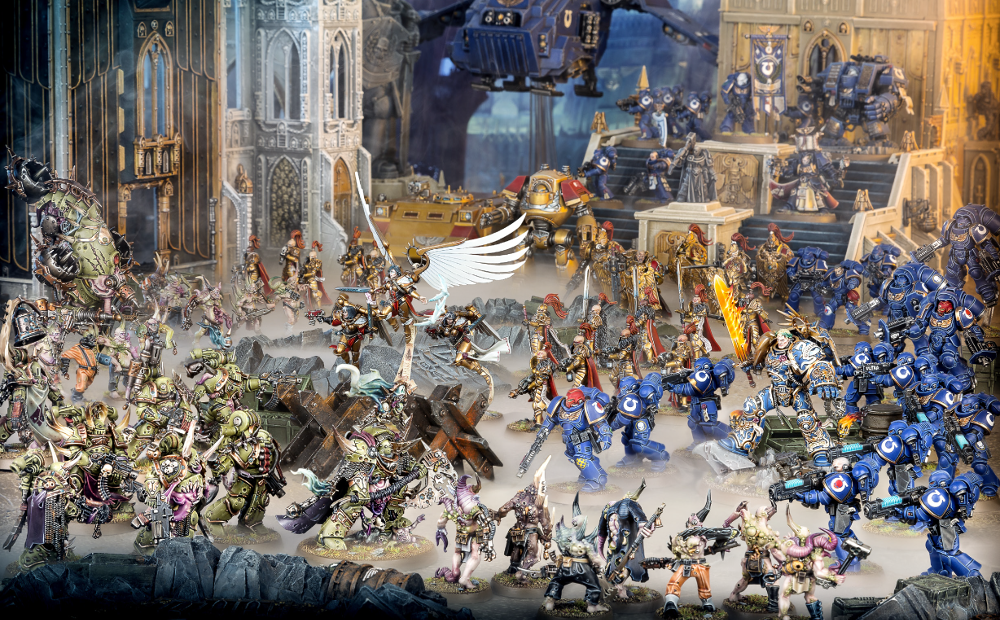
The mightiest heroes of the Imperium gather upon the steps of a sacred cathedrum, pitting their might against the suppurating traitors of the Death Guard in all their blighted glory.
Warhammer 40,000: Dark Imperium (2017)
The Death Guard trudge inexorably into battle amidst the drone of endless swarms of flies. Bloated, rotten and riddled with disease, these revolting traitors are virtually immune to pain. Each Heretic Astartes is utterly dedicated to spreading the feculent blessings of the Plague God Nurgle and working the will of their cadaverous Daemon Primarch, Mortarion.
There are few sights more revolting than that of the Death Guard marching to war. Pallid flesh bulges through splits in rusting armour plate. Rancid effluvium dribbles from pipes and lesions. Maggots squirm busily in gangrenous wounds, whilst toxic smog billows thick and polluted from censers and pus-clotted vents. Plague flies swarm around the Death Guard like smoke rising from a pyre, the mindless drone of their wings mingling with the thump of boltguns firing and the tolling of verdigrised bells.
Spattered with the mud and blood of the battlefield, reeking of rot and decay, the Death Guard advance relentlessly upon their enemies like the corpses of the risen dead. Yet there is much more to these grotesque warriors than first glance would suggest. Far from cold, dead things, the Death Guard seethe with revolting life. As the favoured mortal servants of Nurgle, the Chaos God of Plagues, the Death Guard are blessed with an abundance of foul contagions, parasites and bacteria that swarm through their riddled bodies. The sacred genetic sorcery used to create the Adeptus Astartes has been perverted in these traitors, superhuman organs transformed into pulsating incubators for phages and foulness beyond measure.
Any living thing so diseased ought to drop dead within a single beat of its worm-eaten heart. Sustained by the ebullient energies of their revolting god, the Death Guard are instead strengthened by their dubious blessings. Pain and suffering are notions that apply only to their victims; fear is a laughable concept to such ghastly beings. Warriors of the Death Guard can sustain the most monstrous wounds and continue to fight, battling on with arms torn off, torsos blown open and necrotic flesh crisped black by fire. Many foes employ volleys of plasma fire or salvoes of tank-busting weaponry to lay the lumbering Plague Marines low, and even this is no guarantee of success. Making the most of their horrific resilience, the Death Guard favour grinding, attritional warfare, scything their enemies down in punishing, close-ranged fire fights.
The Death Guard were not always such monstrous beings. During the glorious days of the Great Crusade, when the Imperium sought to reign supreme over a subjugated galaxy, the Death Guard were one amongst eighteen loyal Space Marine Legions who fought at the Emperor's side. Then came the Horus Heresy. Brother fought brother, the realms of Mankind burned in the fires of betrayal, and fully half the Space Marine Legions turned to the worship of the Ruinous Powers. The Primarchs, demigod gene-sons of the Emperor himself, led the Legions. The Primogenitor of the Death Guard was Mortarion, a mighty warrior but a soul consumed with bitterness and jealousy toward his peers. Mortarion's desire for power led to the slow curdling of his spirit. It was this chink in the Legion's armour that Nurgle needed to corrupt the Death Guard, transforming them from noble warriors to corpulent plague carriers, damned forever to Nurgle's service.
Despite their cursed existence, the Death Guard revel in spreading their patron's plagues. Nurgle himself is a rambunctious god, proud of his followers' achievements and indulgent of their whims. Many of the Death Guard are so rotted in mind and soul that they share their god's warped sense of jollity, chortling wetly through muck-encrusted vox grills as they maim and slay. Others are grim and morose, hacking and blasting their way across the battlefield with no more sound than the foetid rasp of their spore-thick breath. Whatever the case, the Death Guard fight an endless war to further the plans of Grandfather Nurgle, and they will not stop until nothing remains of the Imperium but a diseased wasteland of rotting filth.
No Traitor Legion stands as high in Nurgle's favour as the Death Guard. Swollen with the Plague God's blessings and utterly devoted to the corruption of realspace in his name, the hulking Plague Marines that comprise their mainstay despoil all in their path while chanting praise to their gruesome patron.
Plague Marines are relentless and deadly warriors, whose apparent plodding nature belies their lethality. The traitors' advance is slow but inexorable, and almost impossible to stop with anything but the heaviest weaponry.
Decaying within their armour, Plague Marines' bodies have long since become immune to pain or fatigue. Their living flesh fuses directly with their Chaos-twisted power armour, forming a disgustingly resilient whole. Blasts and bolts may crater the Plague Marines' bodies, but few will do more than slow the traitors down and splatter their tainted blood across friend and foe alike. Those who plunge blades or claws into the Plague Marines' forms will be fortunate to do any sort of meaningful damage, and may well find their weapons trapped between sucking folds of rancid fat.
In return, the Plague Marines' every blow is delivered with clubbing strength, their every shot well placed and explosively deadly. Grime-encrusted bolters roar as they spew volleys of self-propelled bolts into the enemy, mowing them down like corn before a scythe. Foul plague knives are driven into the foe, the seething toxins that befoul the blades turning flesh black with rot and clotting blood into sludge. Blight grenades loop end-over-end through the air, bursting in great showers of pathogenic spores and putrescent slime.
Like a ponderously swung sledgehammer, the Plague Marines drive unstoppably through the enemy ranks, their rusted boots grinding flesh and bone as they catch the foe in expert fire-spreads and relentless, overlapping advances. The Plague Marines chuckle wetly through clogged vox grills, flies buzzing in choking clouds about them as they bring Nurgle's wrath to their foes.
Index: Chaos (2017)
Four of the original Traitor Legions were singled out by the Chaos Gods to become their ultimate mortal avatars. Khorne, the Blood God, chose Angron's furious World Eaters to do his will, while Mortarion and his Death Guard were claimed by the Plague God Nurgle. Slaanesh, the Dark Prince, marked the obsessive Emperor's Children as his, while the Thousand Sons were manipulated into becoming the puppets - and puppetmasters - of Tzeentch. Yet there were other Traitor Legions who retained, to one degree or another, their autonomy and identity, degenerating into twisted parodies of their former glory as the millennia slid by. The Night Lords, terror troops and assault specialists without equal; the Word Bearers, dark heralds of the daemonic and the diabolical; the Iron Warriors, embittered masters of siegecraft; the Alpha Legion, infiltrators, manipulators and agents of mayhem; the Black Legion, first amongst traitors, reborn Legion of Horus himself, now ruled by his greatest gene-son, Abaddon the Despoiler. Amongst the Heretic Astartes, these primogenitors form a sort of twisted elite, and whether fighting as dedicated forces or augmenting the ranks of Renegade warbands they are feared and hated by all.
| Legion | Primarch | World |
|---|
| III - Emperor's Children | Fulgrim | [Chemos] |
| IV - Iron Warriors | Perturabo | [Olympia] |
| VIII - Night Lords | Konrad Curze | [Nostramo] |
| XII - World Eaters | Angron | No Record |
| XIV - Death Guard | Mortarion | [Barbarus] |
| XV - Thousand Sons | Magnus the Red | [Prospero] |
| XVI - Luna Wolves | Horus | [Cthonia] |
| XVII - Word Bearers | Lorgar | [Colchis] |
| XX - Alpha Legion | Alpharius | No Record |
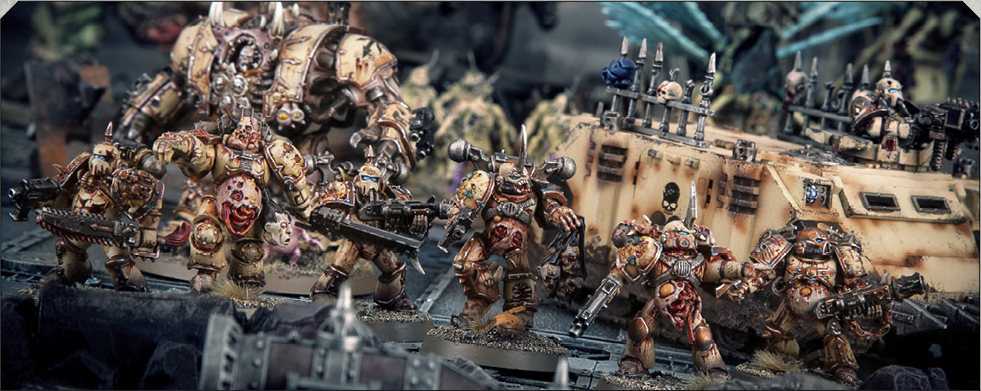
The Death Guard bring pestilence, death and despair - all the generous gifts of their patron, the Plague God Nurgle.
The Death Guard are foulness made manifest. They are a vision of unnatural corruption, of nobility, courage and strength perverted into nightmarish foulness and diseased might. Cities, worlds, even entire systems rot at their touch, the power of Nurgle spreading inexorably wherever the Death Guard raise their flyblown banners.
Resilience. Obstinacy. Brute force. Even before they fell to Chaos, these were the watchwords of the Death Guard Legion. Led by their Primarch, Mortarion, the Death Guard specialised in grinding, attritional warfare, ploughing unstoppably over their foes while taking pride in weathering the worst that their enemies could hurl at them. Thanks to the genetic legacy of their Primarch, the Death Guard possessed a remarkable resistance to poisons, toxins and phages of every sort; no such underhanded weapon or lethal atmospheric condition could lay them low.
The Death Guard were rightly proud of their implacable might, none more so than their Primarch. Yet there was a seed of resentment in Mortarion's heart, for the gifts of his Legion were neither glamorous nor glorious, and won them little acclaim. It was this Achilles' heel that Horus used to turn the Death Guard to his cause. The majority of the Death Guard followed their gene-sire into damnation, becoming the linchpin of many traitor battle-lines.
It was as Horus' Legions advanced upon Terra that the Death Guard found themselves inexplicably lost upon the fickle tides of the warp. Weeks passed with no sign of salvation, during which a terrible plague began to spread from ship to ship. The Death Guard, so long immune to mere mortal frailties, found themselves bloating and sickening. The Destroyer Plague swept through their ranks like wildfire, leaving them ever more rotted and corrupt yet singularly unable to die. At last, Mortarion himself contracted the terrible sickness. In his delirium, the Primarch beseeched Nurgle to save his Legion, and the Plague God - who had planned for this all along - graciously accepted the service of the Death Guard.
The Legion that emerged from the warp in time to join the attack on Terra bore little resemblance to the noble soldiers who had plunged into the warp weeks earlier. Pus and glowing green slime dripped from burst and rusted armour. Bloated, flabby flesh spilled forth, thick with pustulent buboes and weeping sores. The Death Guard were swollen with the sick powers of their new patron, taking a macabre joy in spreading Nurgle's plagues to all who faced them. So it has been ever since, the Death Guard marching at the behest of their rancid god and spreading his blessings to unwilling victims from one end of the galaxy to the other.
Tainted Legions
Unlike so many of their fellow traitors, the Death Guard lost neither their discipline nor their cohesion after the retreat into the Eye of Terror. With Mortarion's rise to fully fledged Daemonhood, the Legion broke into smaller warbands led by their mightiest champions, but still they continued to fight with a singular identity and purpose. Mortarion still directed his plague-ridden sons from afar, and the Death Guard continued to recruit new warriors into their ranks, albeit often by force.
Plague Lords such as Typhus, the Host of the Destroyer Hive, have continued to lead attacks upon realspace and spread metaphysical plagues far and wide. Since the opening of the Great Rift, the Death Guard have redoubled their efforts, revealing that both their numbers and their martial structure were greater than even the most pessimistic Imperial commanders had feared.
Death Guard armies are built around cores of ultra-resilient infantry, Plague Marines and befouled Terminators trudging forwards amidst the drone of a billion plague flies. Plague Sorcerers and hulking Lords lead these lumbering traitors into battle, while before them stagger reeking masses of diseased Cultists and unliving mutants. Massed firepower and armoured support is provided by rusted packs of Helbrutes and Daemon Engines, while Death Guard tanks rumble through the muck and murk of the battlefield with their guns roaring. Occasionally, even larger and more terrifying war engines lend their might to the Death Guard attack, rotted Titans and huge, bloated Daemons crushing the enemy underfoot as they spew corrosive filth across their ranks.
Utilising sustained bombardments and relentless advances, the Death Guard pummel their enemies into submission. They chant droning mantras of worship to Nurgle, or chortle with revolting mirth as they gun down the foe, but always ensure that a few survivors escape - infected with the terrible plagues of Nurgle, such victims spread sickness and disease before the Death Guard like a bow wave, and ensure their conquests come all the quicker.
This section contains a selection of datasheets for Death Guard miniatures. Each datasheet includes the characteristics profiles of the unit it describes, as well as any wargear and special abilities it may have.
Forces of the Death Guard
The Heretic Astartes datasheets listed below can be from the Death Guard Legion. Those that have the <LEGION> keyword on their datasheet can replace it in all instances with DEATH GUARD. If a Heretic Astartes unit does not appear in the list to the right, it cannot have the DEATH GUARD Faction keyword.
Servants of Nurgle
If a Death Guard unit has the <MARK OF CHAOS> keyword, it must be NURGLE. Similarly, DEATH GUARD Daemon Princes must owe their allegiance to NURGLE.
Lords of the Plague Host
The Battlefield Role of DEATH GUARD Plague Marines is Troops instead of Elites.
Plaguecasters
Malignant Plaguecasters must choose the additional psychic powers that they can use from the Contagion discipline below.
Death Guard Army List
- Typhus (pg 58)
- Lord of Contagion (pg 58)
- Malignant Plaguecaster (pg 59)
- Noxious Blightbringer (pg 61)
- Daemon Prince (pg 21)
- Chaos Lord (pg 16)
- Chaos Lord in Terminator Armour (pg 16)
- Chaos Lord on Palanquin of Nurgle (pg 19)
- Sorcerer (pg 22)
- Sorcerer in Terminator Armour (pg 22)
- Sorcerer on Palanquin of Nurgle (pg 24)
- Plague Marines (pg 60)
- Poxwalkers (pg 59)
- Chaos Cultists (pg 26)
- Possessed (pg 32)
- Helbrute (pg 33)
- Foetid Bloat-drone (pg 60)
- Chaos Rhino (pg 34)
- Chaos Spawn (pg 36)
- Defiler (pg 41)
- Chaos Predator (pg 38)
- Chaos Land Raider (pg 37)
Contagion Discipline
| D3 | Psychic Power |
|---|
| 1 | Miasma of Pestilence: Miasma of Pestilence has a warp charge value of 6. If manifested, select a visible friendly DEATH GUARD unit within 18" of the psyker. Until the start of your next Psychic phase, your opponent must subtract 1 from all hit rolls that target that unit. |
| 2 | Gift of Contagion: Gift of Contagion has a warp charge value of 7. If manifested, select a visible enemy unit within 18" of the psyker and roll a D3. Consult the table below to discover what characteristic penalty all models in that unit suffer until the start of your next Psychic phase (this cannot reduce a characteristic to less than 1).
| D3 | Effect |
|---|
| 1 | Flyblown Palsy: -1 Attack | | 2 | Muscular Atrophy: -1 Strength | | 3 | Liquefying Ague: -1 Toughness |
|
| 3 | Plague Wind: Plague Wind has a warp charge value of 5. If manifested, select a visible enemy unit within 18" of the psyker. Roll one dice for each model in that unit - the unit suffers a mortal wound for each roll of 6. |
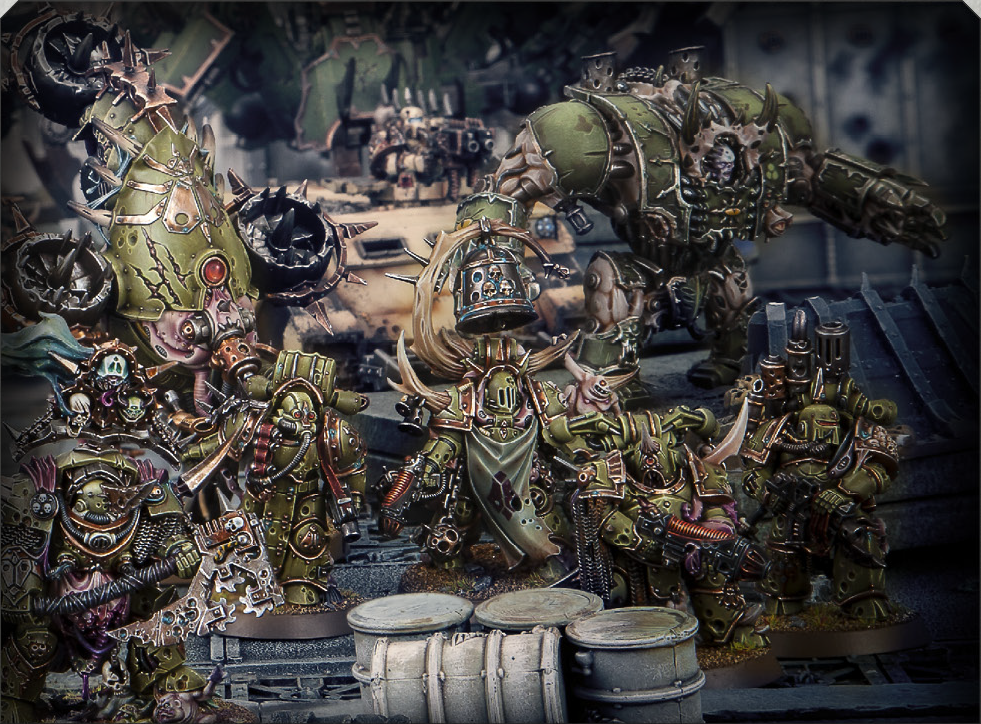
The Death Guard lumber and stomp to war amongst a throng of flies, plague spreading unbound before them.
Even if they are driven from the battlefield with barrages and firestorms of promethium, the profane gifts of Nurgle's children still linger. These include the disease known as Nurgle's Rot, a slow-acting but utterly fatal malady that agonisingly transforms the victim into a Plaguebearer, as well as the many strains of the dreaded zombie plague. The latter is a particular favourite amongst followers of the Lord of Decay, especially the hated Death Guard warbands. There are countless variations of this disease. Some are delivered by skyburst mortars into the upper atmosphere, while others are poured into a planet's water reserves or summoned in a pestilential monsoon by a pox-sorcerer's ritual. The most common strain deployed by the Death Guard keeps its victims alive and coherent even as it agonisingly reshapes their flesh. They become the shambling, rotting monsters known as Poxwalkers, whose role it is to soak up enemy fire before the advance of the Heretic Astartes, spreading their hideous infection amongst the foe even as las-fire and explosions blast them apart in gouts of pus and gore. The victim's mortal soul is trapped within this horrifying shell, unable to act or do anything but scream and beg for the blissful release of obliteration.
Warhammer 40,000: First Strike (2017)
Ultramar is a sub-sector of the Imperium ruled by the Ultramarines Chapter of the Adeptus Astartes. It is among the most heavily fortified and defended regions of the Imperium, yet it is in the throes of a pestilential invasion by the Death Guard.
During the Creeping Doom offensive, the plague-ridden Chaos Space Marines wrought untold destruction on Ultramar. Daemonic poxes ravaged planets and virus bombardments turned hive worlds into rubble-strewn cesspools of disease.
Nurgle, the Chaos God to whom the Death Guard are aligned, sees in the fertile planets of Ultramar the perfect breeding grounds for his most vile contagions. It falls to the Ultramarines to defend their realm, and to prevent agri worlds such as Masali from becoming flyblown wastes.
The Death Guard were once Adeptus Astartes, but their Legion fell to the corruption of foul Warp entities. Bound by the vile will of Nurgle - the Chaos god of contagion - and with bloated and festering bodies, they spread death, destruction and disease to all corners of the Imperium.
Few sights are more loathsome than the corrupted forms of the plague-infested Death Guard. Their distended torsos are ripe with disease, yet they do not feel the agony of their own decay. In anything, these afflictions only make them stronger, their necrotic bodies so numb to pain that only total destruction can stop their advance. Abominations against nature, the Death Guard advance amidst clouds of flies, their corrupted boltguns spewing death as an unnatural miasma bleeds infection into their surroundings. Their decomposing flesh bulges with corruption, and plump buboes swell with festering pus. Skin, sloughed away long ago, has been replaced by mucosal growths and mutated protusions. Innards hang dripping from rent abdomens, yet by Nurgle's will these corpulent warriors continue to live. Truly Nurgle has blessed the Death Guard, and they intend to share their foul gifts with the denizens of the galaxy.
The Death Guard were not always such monstrosities. As Adeptus Astartes, their Legion was amongst the first to be created, and their Primarch, Mortarion, was a renowned commander who prosecuted the Great Crusade with ruthless efficiency. But for all his strength and achievements, Mortarion was consumed by bitterness towards his peers and the Emperor. When Horus, one of only two fellow Primarchs Mortarion respected and was close to, convinced him to join his nascent rebellion, the Death Lord and the majority of his Legion turned against the Imperium. At that moment, Mortarion had set himself and his sons on a path that ended in their tragic corruption by Nurgle, the god of decay and putrescence. The Death Guard were forever transformed from noble warriors into corpulent mounds of flesh, their genetically enhanced organs transfigured into vestigial disease incubators, damned forever to the Plague Father's service.
Though the atrocities of that dark time were many, few Legions brought more ruin and putrefaction to the Imperium than the Death Guard. Through them, Nurgle's rot spread to countless Imperial worlds. Where they were met in battle by the loyalist Adeptus Astartes, their disgusting resilience allowed them to weather the most punishing fire before replying with their own dread onslaughts.
Despite numerous horrific victories that carried them all the way to Holy Terra, the revolters were defeated when Horus was cut down by the Emperor. With their leader gone, the remaining Chaos forces retreated to the Eye of Terror, the star-spanning portal between realspace and the warp, to regather their strength and plot their retribution. Here, Mortarion was rewarded by Nurgle for his faithful service, and his mighty form was mutated into that of a hideously disfigured Daemon Prince. The warriors of the Death Guard continued to decay, growing more grotesque with every passing century, more inured to pain with every parasite that wormed through their flesh. Now that the Great Rift has opened, the Death Guard are spewing back into the galaxy in numbers not seen since the time of the Heresy. Like an endless swarm of flies they descend upon the Imperium, to worlds where the seeds of Nurgle's plagues have long been festering. But the time for sowing is now over, and the time for reaping has begun.
Codex: Chaos Space Marines (2017)
Over one hundred companies drawn from the Emperor's Children, Death Guard, World Eaters and Sons of Horus Legions had already taken up arms against the rebellion on Isstvan III's surface at the time of the virus bombing. Horus had ensured their numbers were almost entirely made up of those Space Marines from each Legion who were still loyal to the Emperor, intending to wipe out those who had proved incorruptible in a single deadly stroke. Of these brave warriors, fully two-thirds miraculously survived the bombardment, thanks to warning messages received from the dwindling ranks of loyal comrades left aboard the orbiting fleet of the Warmaster. Angron, headstrong as ever, made planetfall at the head of fifty companies of Traitor Marines to slay these survivors. The ground war began in earnest, signalling the start of the greatest turmoil to ever have engulfed the Imperium.
As the forces of Horus launched their orbital barrage upon the loyal Space Marines on Isstvan III, Captain Garro, of the Death Guard, seized the frigate Eisenstein from the traitor fleet. His instinct had led him to warn the loyal warriors on the planet's surface of their imminent betrayal, and he was determined to flee the Isstvan system. Garro was unable to prevent the atrocities that followed, and his vessel was no match against the battleships of Horus' blockading fleet; all he could hope for was that the Eisenstein could escape from the Isstvan system and somehow find a way to reach Terra to warn the Emperor of Horus' treachery.
Abaddon the Despoiler's Thirteenth Black Crusade
The armies of Chaos invade Cadia and its many surrounding worlds. The forces of the Dark Gods read like a roll call from epic battles of the ages. Always in the vanguard are the Black Legion, followed by the Death Guard, World Eaters, Alpha Legion, Thousand Sons, Night Lords and other Legions from the annals of the blackest days. Renegade Chapters long thought extinct renew their assaults on the Imperium of Man. Before them run scabrous cultists, deranged mutants and traitorous scum in numbers too great to count. Behind them march Daemons of all the Ruinous Powers, the nightmares of mortals made real, led by their infernal overlords.
After a gruelling campaign with a death toll that spirals into the trillions, Abaddon the Despoiler succeeds in tearing down the strange pylons that for thousands of years had held the Cadian Gate as a stable region of space. Cadia falls soon thereafter, and a wave of warp storms roars into being across the length of the galaxy. Astropaths everywhere fear to open their minds to receive or broadcast messages, for the immaterium rings with mind-splitting peals, possibly the sound of the myriad tears ripping open in the barrier between the material universe and the warp, or perhaps the laughter of the Dark Gods...
Plague Marines are Chaos Space Marines who have sworn themselves to Nurgle, the Chaos God of pestilence and entropy. The first Plague Marines were warriors of the Death Guard Legion, trapped in the warp upon their spaceships when the virulent Destroyer Plague struck their fleet. Mortarion and his Legion offered themselves up to the service of the Lord of Decay in return for their lives. Their bodies became bloated and swollen with the corruption festering within them, but they no longer felt the agony of the warp-pox and did not die from its horrific symptoms.
Since then, many Space Marines have dedicated themselves to Nurgle, though few achieve the vaunted ranks of the Death Guard. Those who truly wish to join this most foetid of cadres must first swear loyalty to the Primarch Mortarion - only then will Nurgle bestow upon them the corrupting ague that created the Plague Marines. Outside of the Death Guard, a favoured few Sorcerers of Nurgle know the secrets of the Plague Marines, and Abaddon of the Black Legion has won many of these spellcasters to his cause. In return for fealty and long service, these blight-mages will bestow their pestilent gifts in the Warmaster's name.
Regardless of allegiance, all Plague Marines have disgusting, rotted bodies that stink of decay. The putrescent slime that oozes from their many weeping sores corrodes their armour and burns their skin, but despite their horrific disfigurements, the Plague Marines are fearsome warriors indeed. Their rotting brains are inured to the agony of bodily corruption, making them all but immune to the pain or debilitation caused by the weapons of the enemy. Not for nothing are these repugnant footsoldiers considered the most resilient of all the Chaos Space Marines.
The Plague Marines prefer short-ranged firefights, where they can truly appreciate the festering carnage they inflict upon their enemies even as they laugh off the bolts and las-blasts directed back at them. The blessed reek of corruption, the sight of freshly suppurating flesh and the blossoming gore of an infected wound - these are things to be grateful for. Those who do not appreciate Grandfather Nurgle's bounty are soon laid low. Should the enemy close to within arm's reach, the Plague Marines will attack with plague-riddled knives, and even hurl toxic blight grenades - vile inventions containing virulent toxins that eat away at armour and fill the air with thick clouds of blinding spores. The most ostentatious blight grenades are 'death's heads' made from the severed remains of fallen enemies, each cranium filled to the brim with a cocktail of disease before being sealed with ancient wax.
As well as fighting at the behest of the Lords of Chaos, the Plague Marines dedicate their lives to spreading corruption and decay across the galaxy. The fleets of Nurgle that spew from the warp spread contagion and pestilence across dozens of star systems. Once the plague ships are abandoned or their crews finally destroyed, the hulks float back to the warp and eventually, perhaps guided by the hand of Nurgle himself, find their way back to a plague planet, where they are re-crewed for a new wave of attacks.
The Cloud of Flies
During a plague ship's journey through the warp, the interior of the craft erupts with large, furry black flies that fill its holds with their decaying carcasses. When the plague ship reaches a world, the Plague Marines disembark to make planetfall. As soon as their transports' hatches open, a thick cloud of insects is released, ready to spread its foulness over a virgin planet. The fly is sacred to Nurgle, for it feasts upon the rotten and the foul. Even one such beast can carry upon its little limbs a cornucopia of infections and viruses, spreading the gifts of contagion to everything blessed by its visitations. When they come on in a great swarm, these diminutive creatures can spread a plague with incredible speed, infecting, infesting, hatching and multiplying in celebration of Nurgle's bounteous cycle with each new day. The symbol of the fly is therefore common amongst the Plague Marines, with elements of its form echoed on the mutant bodies of the Death Guard, Nurgle's chosen sons.
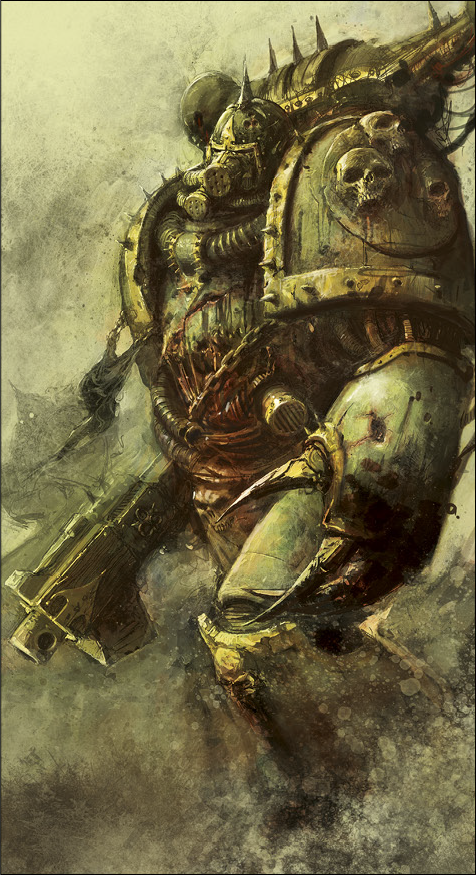
Codex Adeptus Astartes: Space Marines (2017)
Even before the coming of the Noctis Aeterna, Ultramar faced a series of dire threats. Tendrils of several Tyranid Hive Fleets drifted inexorably towards Guilliman's realm. The Arch-Arsonist of Charadon, one of the greatest Ork warlords in the galaxy, led a monstrous Waaagh! from his anarchic domain with the intent of overrunning the Ultramarines' eastern defences. Yet the greatest threat of them all was that posed by the dark servants of Chaos. A vast horde of traitors, renegades, mutants and madmen fell upon Ultramar under the leadership of the foul Daemon Prince M'kar the Reborn. And then came the Noctis Aeterna, and with it wave after wave of Daemon-filled warp storms. In the wake of these disasters, some of the greatest servants of Nurgle, the Chaos God of Plagues and Decay, fell upon the Ultramarines' stellar realm, seeking to corrupt the bucolic beauty of its worlds. The Plague Wars, as they came to be known, saw some of the greatest battles the Imperium had ever endured, with every inhabited planet of Ultramar suffering a staggering number of casualties.
Macragge, the capital world, saw fighting across its bleak rocky uplands as well as in its populated cities. The Ultramarines' sprawling fortress monastery - including the shrine in which Roboute Guilliman had lain in stasis for over seven millennia - came under concerted attack. The Bubonicus Legions, led by a favoured Great Unclean One known as Ku'gath Plaguefather, seized the nearby Tartella System before descending upon the planet of Iax, a garden world rich with life. The Espandor System suffered beneath the Creeping Doom offensive of the Daemon Primarch Mortarion and his Death Guard. On Parmenio a great armour battle took place, and throughout the sub-sector a naval battle raged, with defensive battle stations engaged by a Plague Fleet led by the Death Guard lord known as Typhus. Even the disciplined tactics and heroic sacrifices of the defenders were only enough to stave off defeat. Nurgle's followers pushed their befouling offensive forward, contaminating all they touched.
Breaking apart his Indomitus Crusade, Roboute Guilliman returned to aid his home system. Seeing that his only chance lay in seizing the initiative, the Primarch masterminded a brilliant campaign known as the Spear of Espandor. Rapid counter strikes and a series of daring boarding actions clawed back many of the foe's gains. Where the disparate Chaos armies fought separately, the defenders of Ultramar supported each other in every way they could, allowing Guilliman to slowly reverse the course of the war and put Nurgle's favoured commanders on the defensive. Utilising their superior numbers, the Chaos forces amassed for a final confrontation upon Iax. There they fought to a standstill, with Guilliman countering every ploy. Ultimately the Chaos forces escaped under the cover of a massive virus bomb. With little time to spare - for the galaxy remained riven with war - the Lord Commander of the Imperium organised the rebuilding of Ultramar, beginning with the defence networks, before leaving once more at the head of a retributive strike force.
The Plagues of Ultramar
To the galactic north of Ultramar, the followers of the Chaos God Nurgle establish dominion in the Scourge Stars. From this hive of corruption, armies of Daemons pour forth, accompanied by the traitorous Death Guard Legion along with renegades and cultists beyond count. Three loathsome spearheads push into Ultramar, attacking along a hundred fronts and bringing with them unnatural pestilence. The defenders of Ultramar fight bravely, but lose ground. Ultramarines from the Ultima Founding arrive to reinforce their brethren, but they can only slow the attackers.
Guilliman Returns to Ultramar
All across Ultramar, the Imperial defenders are depleted in dozens of ground campaigns, while a Plague Fleet systematically destroys the realm's defence fleet and star fortresses. Guilliman returns from the Indomitus Crusade, and his deft and defensive manoeuvres buy time to launch the Spear of Espandor counterattack. The combined plague armies are eventually fought to a standstill amongst the ruins of Iax, before the Death Guard Daemon Primarch Mortarion escapes under cover of a virus bomb.
Codex Adeptus Astartes: Grey Knights (2017)
Plagues of Ultramar
The Exactors send Strike Force Cautery to Ultramar to aid the Ultramarines and the Ordo Sepulturum in the fight against the Death Guard, who are spreading daemonic plagues across the region. With knowledge of the Heretic Astartes' viral proclivities gleaned from the tomes in the Sanctum Sanctorum, the Grey Knights are able to cripple two vectoriums of the Death Guard's 4th Company and eradicate the Consumptiphagus strain of the Eater Plague.
The Plague Brethren (2017)
Of all the armies that seek to conquer the stars in the 41st Millennium, the Death Guard are truly the foulest and most corrupt. Made monstrous by their patron god Nurgle - lord of plagues and grandfather of disease - they are decay and entropy made manifest, living icons of hopelessness and despair.
Once noble Space Marines loyal to the Emperor of Mankind, the Death Guard fell to the predations of Chaos, driven by their own wretchedness into the arms of the Lord of Decay, where they festered like a sickness. They became bloated with Nurgle's rot, their once-glorious armour and gene-enhanced bodies melding together into a hideous parody of the Adeptus Astartes. Ceramite became pitted and weapons rusted, flesh sloughed from bones and hideous mutations were rife. For 10,000 years the Death Guard have endured this living hell of their own making, a canker in the warp that is a constant and terrifying blight on the Imperium of Man.
Codex: Adeptus Mechanicus (2017)
War of Slime and Metal
Metalica is besieged by the Plaguehosts of Nurgle, the 3rd and 7th Plague Companies of the Death Guard, Chaos Space Marines, the corrupted Titans of Legio Morbus, and no fewer than seven fallen Knight houses. Only the arrival of the entire House Raven staves off defeat, and only with the aid of a war fleet from Deimos is the attack finally broken and the Daemons banished.
Codex: T'au Empire (2018)
Plague Wars
Commander O'Kais is sent to prepare the verdant world of Kellik for colonisation. Unfortunately, Plague Marines of the Death Guard have already made landfall, and are in the process of pouring the disease-ridden, liquefied remains of their sacrificial victims into Kellik's great lakes. T'au gunships and Piranhas knife into the Heretic Astartes, overwhelming dozens of Plague Marines with bursts of incinerating plasma fire. However, the Death Guard had already seeded their foul corruption deep into the bedrock of Kellik. Foetid creatures begin to crawl from the tainted waterways in their thousands, and clouds of fat-bodied flies block visor displays and clog helmet rebreathers. The Plague Marines rally and regroup, chortling wetly as they unleash brutal fusillades of bolter fire that burst open T'au bodies like ripe fruit. Commander O'Kais refuses to abandon his mission even in the face of this repulsive contagion, and the surface of Kellik becomes host to a deluge of blood and bile.
[...]
Battle of the Startide Nexus
Mere months after the Fourth Sphere survivors rejoined their people, an enormous Death Guard armada tears its way from the warp and emerges in the heart of the Nem'yar Atoll, before the mouth of the Startide Nexus itself. The Chaos fleet launches attack ships and boarding claws filled with Heretic Astartes at the star fortresses guarding the spatial rift. The shocked T'au defence fleets react with remarkable speed, blasting many of these vessels to atoms, but many more slip through the barrage and spill packs of frenzied killers into tide-locked arcologies and stellar fortifications. A furious battle rages. The T'au know that if the Nexus falls, a route to the heart of the empire will be left open. The warriors of the Fire caste fight with desperate courage, selling their lives by the thousand to repel the invaders. Commander Shadowsun leads an immense counter-attack into the heart of the Chaos fleet, blasting daemonic enemies and hulking Plague Marines into a putrid mist with each cannonade from her twin fusion blasters. Yet even her desperate heroics surely cannot hold back Nurgle's chosen Legion for long...
Tales from Vigilus webpages (2018)
+++Adeptus Arbites pict recorder footage log spool 966.54+++
+++Vigilus calendar [chronological corruption detected]+++
+++Location: Dontoria Hivesprawl, Quadrant Alpha-Tertius, Litmus Dock+++
+++Local time: [chronological corruption detected]+++
+++Classification: pending... pending... pending...+++
My lady and most noble Inquisitor, please find below the transcript that you requested in its entirety. I apologise for its quality. My adepts cannot account for the corruption that the data-stacks appear to have suffered. A priest is attending to them but I fear the entire stack-unit will have to be burned post-haste. It is my most fervent hope that you will still be able to make use of the information here imparted. I have transcribed it as best I could.
If I can be of any further service to you, I would ask only that you let me know in what way I might aid the Holy Ordos and your magnificent person once again.
Your most unworthy and devoted servant,
Scriptum-Collatus First-class Lamentabus Mogue
Transcript Commences>>>
PICT RECORDER 1: View of Litmus Dock, Cargo Jetty Alpha. The mooring is a hive of activity, flanked by industrial tower stacks and squat hab-blocks. It is lit by arc-lumen on tall iron poles and numerous burning braziers. Lumbering hauler-barges and shuttles of varied patterns come and go from the grav-moorings along the jetty. Auto-gangways are manoeuvred into position. They allow passengers to disembark into the massed labourers, cargo servitors, preachers, Guardsmen, hawkers and other assorted citizenry who throng the docks and the walkways beyond. Many refugees can be seen huddled in groups on every available flat surface, sporadically being moved on by patrolling Arbites.
PICT RECORDER 2: Switch to Cargo Jetty Beta. Heavier military presence here, Valhallan garrison force, snarlwire fences, stablights, minimal civilian presence. Imperial navy shuttles and lighters come and go here in orderly fashion. Two Valhallans can be seen laughing at some shared jest.
PICT RECORDER 3: View of a stretch of transitway 544/6 that lies to the rear of the dock. Civilian vehicles and military transports form a constant two-way stream along the ferrocrete, the ten lanes of carriageway orchestrated at speed by remote transit cogitators.
PICT RECORDER 2: The Valhallans' mirth is interrupted. One of them holds up a hand to the other, frowning as he attends to his vox unit. His eyes widen and he looks skywards at something out of shot.
***21% static degradation develops on image at this stage***
Transcript Interjection>>> One presumes, my lady, that this is where matters begin to go awry. - LM
PICT RECORDER 1: A commotion can be seen amongst the folk thronging Jetty Alpha. Some are pointing skywards. Others are staring. The refugees do neither of these things; instead, they have already begun to flee, bearing their meager belongings with them.
***audio corruption [fragmentary data-exhumation suggests the sounds of heavy calibre gunfire, possibly from Litmus Dock's short-range defence turrets]***
***pict feed spools at half speed and then cuts out. Audio baffled here to remove disturbing and potentially corrupting elements***
PICT RECORDER 3: Disruption amidst the traffic flow. Refugees fleeing from Jetty Alpha are attempting to cross the carriageways. There are several collisions. Some vehicles accelerate. Others slow, skid or halt altogether. There are further collisions. Auto-cogitators begin to deploy calming measures and recovery servitors.
***audio corruption, visual flare-out from left hand side of screen [evidence of a considerable impact commensurate with the deployment of large scale ordnance or a substantial vehicular impact]***
PICT RECORDER 2: Sentries on Jetty Beta are raising their lasguns, intoning arming prayers and moving swiftly out of shot in the direction of Jetty Alpha. A Valhallan officer can be seen shouting and gesticulating as a troop shuttle slides in to dock at Jetty Beta. Signs of physical degradation can be noted across the vehicle's hull [sub-ref corrosive contagion, possible heretical contaminants, evidence of biomechanical growth, tri-lobe symbol]. The shuttle's troop-bay doors open.
***partial audio and visual wash out. Muzzle flares visible in the shuttle's troop bay entrance. Static disruption of image increases to 35%***
The Valhallan officer is hit by multiple projectiles. His body jerks and then explodes as though munitions have triggered inside him. Valhallan soldiers meet similar fates. Those making for Jetty Alpha can be seen turning and re-entering shot, attempting to martial themselves into a formation while continuing to take substantial fire. Though they are largely obscured by static on the image, massive figures can be made out stamping down the shuttle's auto-gangway and firing into the gathering Valhallans. Lasbolts and grenades batter them, but the ponderous invaders seem untroubled. They continue to fire, their movements made jerky by image-spooling failure, and more Valhallans die.
***visual feed cuts out***
Transcript Interjection>>> It is shocking, is it not, to see such violence against servants of the Emperor within our own cities? How can such a thing have been permitted? One hopes, but would never presume to suggest, my lady, that those responsible for this disaster will be found out and punished suitably! - LM
PICT RECORDER 1: ***visual restored, though spooling is erratic and static disruption varies from 42-70%***
The scene is apocalyptic. A heavy cargo hauler can be seen driven like a spear into the jetty, its prow broken away at an extreme angle from its aft quarters. It has evidently come in at considerable speed. Damage from heavy armaments can be seen upon its ruptured hull, which is aflame and also evidencing substantial unnatural corruption. The hauler's cargo grapples have disengaged and multiple Munitorum-standard cargo containers have spilled across the jetty. Wreckage, bodies and fire are everywhere. Several braziers have been toppled and their contents added to the blaze. The cargo containers cycle their hatches to open. Movement now visible inside.
***partial visual and audio corruption. Dirge-like moans can be heard over the crackle of flames and the screams of the wounded***
Figures begin to emerge from the containers in prodigious numbers. They affect a shambling gait and severe physical corruption. Some are aflame but do not appear troubled by this. Valhallan soldiers can be seen entering shot. Despite partial static on the image, it can be seen that they are firing lasguns and throwing grenades into the advancing figures.
Transcript Interjection>>> How monstrous these terrible creatures are! Can they possibly ever have been human? - LM
PICT RECORDER 3: ***image showing 49% static degradation, audio entirely baffled due to extreme corruption, spooling intermittent***
Seven lanes of traffic have come to a complete stop at this stage. The remaining three are gridlocked as enormous quantities of transport vehicles attempt to funnel through the bottleneck with little success. Refugees are still fleeing between them, causing substantial disruption. The Arbites' attempts to control the chaos are insufficient. Fresh panic can be seen spreading through figures on the road and inside vehicles as a dark shadow falls across this section of carriageway. Vehicles lurch violently as their passengers attempt to wrest control and are locked out by traffic auto-cogitators. Refugees and Arbites alike can be seen fleeing in all directions, some plunging into the flames of burning wrecks in their panicked haste to escape.
***image suddenly obscured. Flash flare and complete degradation of image. Cracks craze the pict recorder lens and its machine spirit expires***
PICT RECORDER 4: ***Awakening runes flash across a reserve pict recorder's lens. Visual comes online, only audio is choral exclamation of machine spirit awakening. Visual is already 35% static-washed, but shows another, more distant angle of transitway 544/6***
A second heavy hauler has come down upon the transitway and caused utter devastation. It is broken in two across the carriageways, and cargo containers have spilled from within its flaming innards. They are open, and fresh waves of the moaning, stumbling figures are emerging. Low estimate of their numbers would be one to two thousand. Their bodies evidence extreme signs of both disease and mutation. A few Arbites attempt to fight, and are swiftly dragged down.
Transcript Interjection>>> A truly monstrous scene. My most heartfelt apologies for conveying it to you, my lady Inquisitor; I can only imagine you have felt the same deep-seated horror as I at witnessing this atrocity unfold. - LM
PICT RECORDER 1: ***image now barely visible due to static and spooling issues***
Valhallan soldiery can be seen retreating in good order, firing as they go. Their shots bring down shambling figures, but hundreds more follow on their heels and the Astra Militarum soldiery are being overrun. Voxmen speak intently into vox horns, presumably requesting reinforcements. Panic has not yet claimed these men, but it is close. The plague mutants advance inexorably.
***image washes out with static, corruption now at 91%***
PICT RECORDER 2: ***image returns for a moment. Static corruption is low, estimated at only 7%, but something obscures much of the visual feed. Dark shapes move and squirm across the pict recorder's lens. Audio is a persistent drone***
Through the corrupted image we see that there are no remaining Valhallan soldiery alive on Jetty Beta. The vessel has been scuttled and ploughed into the walkways between jetties Alpha and Beta, severing their links and leaving a mountain of flaming wreckage to block access to the military jetty. Massive figures can be seen moving out of shot in the opposite direction from Jetty Alpha and the transitway. It can be extrapolated that they are accessing the service hatches leading to vent-stack 77, and from there potentially any of a number of low-hive districts. The pict recorder will not capture these figures properly, it warps and blisters around them, but a suggestion can be made out of enormous bulk, of pale-green armour consistent with that of an old and severely corrupted Mk III power armour pattern, and diseased, mutated flesh.
Transcript Interjection>>> Could it be that this entire tragedy was but a diversion so that these monstrous beings might escape notice? Who, or what, could they be? - LM
PICT RECORDER 4: ***image degradation already at 84%. Audio wholly baffled***
Astra Militarum armoured transports can be seen shunting aside wreckage as they converge upon the crashed hauler. Turret and hull weapons fire. Soldiery deploy from their vehicles and establish firing lines. Sentinels stalk through the wreckage, multi-lasers spitting shots. They are attempting to cordon off the area and contain the outbreak of plague mutants, but the conditions are hellish. Fire leaps and spreads by the moment, vehicle fuel tanks explode. Smoke billows, obscuring sight lines and choking soldiers. It is evident that, as wave upon wave of plague mutants continue to emerge from the crashed hauler and to stumble into shot from the direction of Jetty Alpha, the outbreak is escalating in severity with terrifying swiftness. Amongst the fallen a number of figures begin to stir and then to rise, their flesh now showing advanced states of corruption, their visages fixed in leering grins.
***image washes out, corruption at 98%, image spooling fails***
Transcript Interjection>>> I pray to the Emperor himself that these monstrous creatures have all been destroyed. I fear in my heart that it is not so. - LM
PICT RECORDER 2: Jetty Beta is empty. The bulky figures are gone, undetected and unchallenged amidst the mayhem.
***image spooling fails***
PICT RECORDER 1: ***image spooling fails***
Transcript Ends>>>
Imperium Nihilus: Vigilus Defiant (2018)
Imperium Nihilus: Vigilus Defiant (2018), p24-25 — A Sickness in Dontoria
Dontoria Hivesprawl was the largest of all the planet Vigilus' inhabited regions. It was noted for one thing above all else - its overpopulation. As a result, when one of Mankind's darkest and most ancient enemies decided to make Dontoria its playground, the consequences were devastating.
The bustle and mayhem of Dontoria's streets was bewildering, even before the coming of the Cicatrix Maledictum. The black market barons and czars in control of that hivesprawl knew well enough that building tall was a waste of resources. Unlike many of their peers, who were too hidebound, unimaginative or afraid of bucking the rules to stop building upward, they had instead opted to spread as wide as possible - even if that meant narrowing the streets to the point that entire regions became one vast contiguous hab-block.
As a result of this land grab, the buildings were packed in close together, every available space capitalised upon so much so that people had to rub shoulders and share humid air if they wished to proceed above ground. To enter the subterranean levels brought its own risks. Down there, power cuts were common, and those stranded in the darkness did not always come back out.
Such a rich, teeming source of life attracted predators and other baleful influences, just as shoals of vexenkrill attract the leviathans of the ocean deeps. The Drukhari of Kaelac's Bane had raided the hivesprawl more than once, taking a rich haul of slaves back to their base. The Cult of the Pauper Princes, seeing in the sprawl a great many converts-to-be, spread from Megaborealis to infest its lower levels and began the slow, insidious life cycle of their Patriarch all over again. But the false continent's doom was to come from another source entirely.
In the year 2.230 post, Dontoria's principal spaceport - Litmus Dock - received reports of an unknown vessel inbound. It was a pattern of vessel that even the Tech-Adepts seconded from Megaborealis considered ancient, encrusted with the filth of millennia and some manner of strange caulk that made its shape seem as much organic as mechanical. A rain of filth drizzled from its hatchways and airlocks as it came down, its crew ignoring the increasingly insistent calls for its animus codes. When the dock's garrison opened fire upon the vessel with their Icarus autocannon emplacements, some manner of shield repelled the shots. Even lascannons proved unable to pierce the unaccountably strong barrier. The ship docked, by now surrounded by Arbitrators and garrison troops. Its hatches clunked open, and stumbling out came a crowd of distended, bloated mutants - the ambulatory corpses known as Gellerpox Infected. Their assault on the garrison was easily put down by disciplined lasfire, but that which followed was all but impervious - a detachment of Death Guard. Their bulbous and horned silhouettes identified them as the same Heretic Astartes that had assailed Ultramar not long before. A fierce close-range firefight broke out, but the Death Guard shrugged off all but the most dire injuries. They used the Infected as fleshy shields, quickly going to ground via the underway dry docks of Litmus' lower levels.
With coordination at an all-time low due to the Noctis Aeterna and the myriad other threats upon Vigilus, the hunt for the invaders was not reinforced. No armed force was keen on rooting out entrenched Heretic Astartes, but many of the elite Guardsmen and those Arbitrators with a keen sense of duty braced themselves and went into the depths. Most found nothing. Others found painful death. When Tempestor Naiod ordered the lower levels firebombed within a two-mile radius, the Imperial forces considered the matter closed. Naiod withdrew the 98th Lamdic Oxen from the operation, and the hunt slowly ground to a halt. Only when a strange plague started to manifest across the district did it become clear that the scions of Nurgle had been diligent indeed.
The magnitude of this infection cannot be underestimated. This is no natural plague, no malady that the human body can fight and overcome. This is the Gellerpox. It is fully capable of causing flesh to run like wax, to swell and burst, even to blend with augmetics, wargear and those machineries close at hand whilst the sufferer sleeps. The resultant hybrids are as tough as Ogryns and singularly focused on bringing their blight to as many uninfected as they can find. In the name of the Astra Cartographica, I implore you - quarantine Dontoria, effective immediately, or lose your planet to an enemy you cannot fight.
— Delarique du Languille
Imperium Nihilus: Vigilus Defiant (2018), p36 — Hope Yet
Since the fall of the Oteck Hollows, water was becoming ever scarcer upon Vigilus, and the convoys for its transference less and less common. With Grodholev Subsprawl falling to the Gellerpox, Dontoria was in danger of losing its own main source of water - Lake Dontor, which was now under daily vigil in case of disease. The Vigilus Senate had still not located the Death Guard forces that had brought the Gellerpox to the planet, and suspected that if the traitors found a way through the firewall they would move against the lake with yet more contaminants.
Imperium Nihilus: Vigilus Defiant (2018), p45 — 14.010 Post - The Infection Spreads
As promethium fires blazed around Dontoria, the Iron Hands enforcing the quarantine allowed frustration and repugnance to overwhelm their nobler natures. Ruthless efficiency became sheer brutality, and desperation turned to terror amongst the trapped populace. Preferring to brave fire and pox than face the merciless Iron Hands, bands of resourceful Dontorians broke out of the restricted area and fled. Efficient as strategic cogitators, the Iron Hands deployed kill teams to contain these breakouts. However, their forces came under sudden heavy attack from the Death Guard still lurking in the city. Reports circulated of daemonic entities manifesting alongside Mortarion's sons.
Imperium Nihilus: Vigilus Defiant (2018), p87 — Necropolis Hawks
Trained extensively in close-quarters warfare and veterans of a dozen city fights, the Necropolis Hawks are stoic and efficient in their warfare. They bear their battlefield role insignia upon their backpacks as well as their pauldrons so their comrades can identify them even in the smoke and dust of urban war.
On Vigilus, the Necropolis Hawks turned the tide against the xenos insurrection and Gellerpox infection that rocked Dontoria to its foundations. Taking control of the city building by building, they established several safe zones that were expertly defended - and pitilessly demolished those that they considered lost causes.
Imperium Nihilus: Vigilus Defiant (2018), p121 — First Phase of the War of Beasts
Round 5
2.230 Post: A Sickness in Dontoria
In Dontoria Hivesprawl, a vessel makes an unauthorised docking. Emerging from within, the Death Guard fight their way deep into the hivesprawl. Within the week, the deadly Gellerpox has spread through the hive.
Special Rules
In this campaign round the following special rules apply:
[...]
Deadly Contagion: At the start of the first battle round, but before the first turn begins, each player rolls a D6 for each of their Infantry units that is on the battlefield. On a 1, subtract 1 from that unit's Toughness characteristic. Nurgle units are not affected.
Imperium Nihilus: Vigilus Defiant (2018), p124 — Third Phase of the War of Beasts
Round 3
14.010 Post: The Infection Spreads
The Iron Hands struggle to secure their Dontoria quarantine and their heavy-handed enforcement causes the populace to panic and break out. As the plague spreads to Megaborealis and Mortwald, the Death Guard launch an ambush against the Iron Hands, with reports of daemonic entities accompanying them.
Special Rules
In this campaign round the following special rules apply:
[...]
Deadly Contagion: At the start of the first battle round, but before the first turn begins, each player rolls a D6 for each of their Infantry units that is on the battlefield. On a 1, subtract 1 from that unit's Toughness characteristic. Nurgle units are not affected.
Imperium Nihilus: Vigilus Defiant (2018), p150-151 — Echoes of War: Breach of Quarantine
The quarantine set up in Dontoria by the Iron Hands to contain the Gellerpox outbreak was not to last. The civilians trapped inside attempted to force their way out, prompting the Space Marines to respond aggressively. Meanwhile, the veil of realspace began to erode, allowing Nurgle Daemons to burst through.
The Armies
Each player must first muster an army from their collection. The Defender commands the Iron Hands quarantine force. The Attacker commands the poxriddled populace, the contingent of Death Guard and the warp-born Daemons of Nurgle. A player can include any models in their army, but if their army is Battleforged they will also be able to use the appropriate Stratagems included with this mission (see below).
The Battlefield
The Defender creates the battlefield. Each of their deployment zones should be heavily fortified to mark the perimeter of the quarantined zone, whilst the centre is left clear save for a few barricades, obstacles and craters.
Deployment
After terrain has been set up, the Attacker sets up their units wholly within their deployment zone. The Defender then sets up their units wholly within their deployment zones.
First Turn
The Attacker has the first turn.
Escape Route
Any unit in the Attacker's army can move off a battlefield edge labelled 'Escape Route' so long as all of the models in that unit are able to make it off the board by that edge in the same phase. Any models that do so are said to have escaped, and are removed from the battlefield and take no further part in the battle.
Battle Length
Use the Random Battle Length rules (pg 128) to determine how long the battle lasts.
Victory Conditions
At the end of the battle, add up the Power Ratings of all the Attacker's escaped units (see Escape Route) and compare this to the Power Level of their army (count the entire unit's Power Rating, even if some of its models were destroyed before the unit escaped). If the combined Power Rating of the escaped units is one third or more of the army's Power Level, the Attacker wins a major victory. Any other result is a major victory for the Defender.
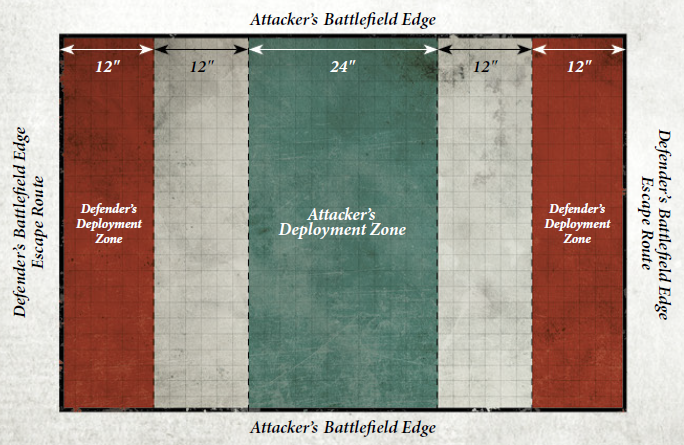
Stratagems
In this mission, the players can use Command Points (CPs) to use the following bonus Stratagems:
Reality Tears — 2CP
Attacker Stratagem
The veil between realspace and the warp tears wide like agaping wound and out pour the Daemons of Nurgle.
Use this Stratagem at the end of your Movement phase. Pick a Nurgle Daemon unit from your army that was destroyed earlier in the battle. Set up this unit anywhere on the battlefield more than 9" from any enemy models.
Repulsive Deluge — 1CP
Attacker Stratagem
The servants of Nurgle explode with vile fluids that corrode armour and sear the flesh of any caught in the entropic downpour.
Use this Stratagem after a unit from your army has been destroyed, before removing the last model from the battlefield. Roll a D6 for each enemy unit within 7" of that model. For each roll of 3+ the unit being rolled for suffers D3 mortal wounds. Once this Stratagem has been resolved remove the last model from the destroyed unit as normal.
The Frenzied Populace — 1CP
Attacker Stratagem
Driven mad by the foul plague that has infected them, the common people are driven to attack those they once called comrades with unnatural vigour.
Use this Stratagem at the start of the Fight phase. Pick a unit of Poxwalkers from your army. Add 1 to the Attacks characteristic of that unit until the end of the phase.
We Give Our Lives for the Emperor — 1CP
Defender Stratagem
With righteous zeal and reckless abandon, these warriors hurl themselves into the enemy lines without thought for their own safety.
Use this Stratagem at the start of the Fight phase. Pick a unit from your army. Add 1 to hit rolls and wound rolls for attacks made by that unit until the end of that phase. However, your opponent can add 1 to hit rolls and wounds rolls for attacks that target the unit you picked.
Purge the Unclean — 1CP
Defender Stratagem
Flamer in hand, this Space Marine steps forward to unleash a righteous inferno upon the enemy.
Use this Stratagem before a unit from your army attacks in the Shooting phase. Add 1 to wound rolls made for that unit's flame weapons. For the purposes of this Stratagem, a flame weapon is any weapon profile whose name includes the word 'flame' (e.g. flamer, heavy flamer, flamestorm cannon, flamestorm gauntlet.)
Thunderhawk Strafing Run — 3CP
Defender Stratagem
A sound of thunder roars from above before the battlefield ignites in a series of devastating detonations.
Use this Stratagem in your Shooting phase. Pick up to three enemy units within 12" of each other and roll a D6 for each. Add 1 to the result for every 10 models in the unit being rolled for. On a 5, the unit being rolled for suffers D3 mortal wounds. On a 6+ the unit being rolled for suffers D6 mortal wounds.
Mission Veterans
In this mission, each player can upgrade one of the units in their army to be a mission veteran. If one player takes a mission veteran but the other does not have a suitable model, the player without the mission veteran gains 1 additional Command Point at the start of the battle.
The Putrid Brotherhood
Attacker Mission Veteran Stratagem
Veterans of the Long War, and members of the Seven Pillared warrior lodge, the Putrid Brotherhood were spreading the vile diseases of Grandfather Nurgle for over ten millennia before they set foot on Vigilus.
Pick a unit of Plague Marines from your army to be the Putrid Brotherhood. Add 1 to wound rolls for shooting attacks made by this unit that target enemy Vehicles.
Scout Squad Sicaron
Defender Mission Veteran Stratagem
Under the leadership of Sergeant Idonis, the unflinching aim of Scout Squad Sicaron neutralised half a dozen critical enemy targets without loss of civilian life.
Pick a unit of Adeptus Astartes Scouts from your army to be Scout Squad Sicaron. You can re-roll hit rolls for shooting attacks made with sniper rifles by this unit that target enemy Characters.













